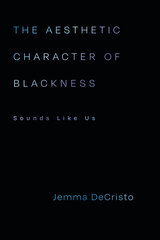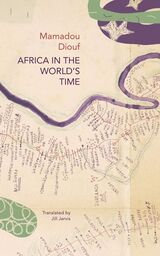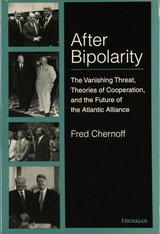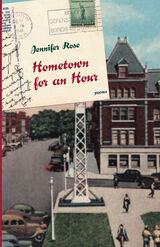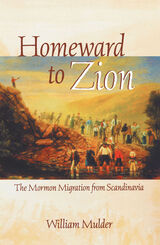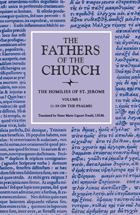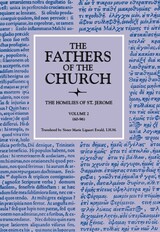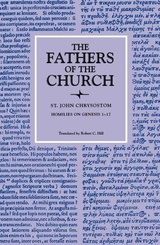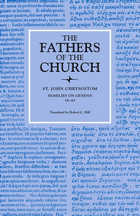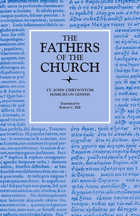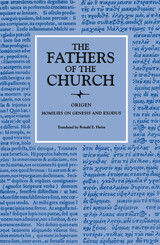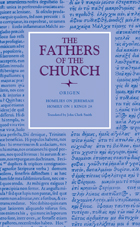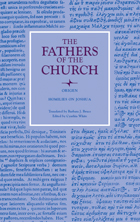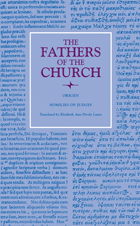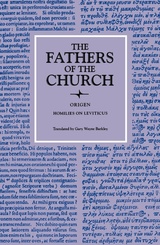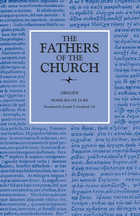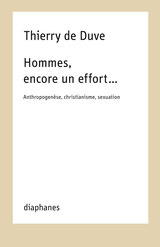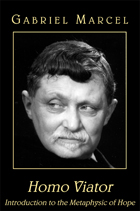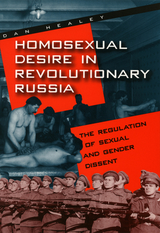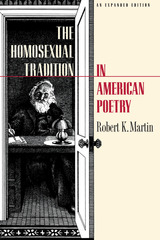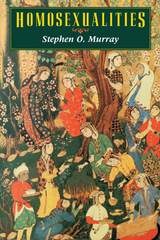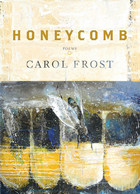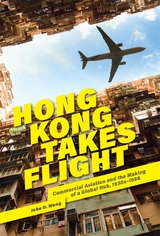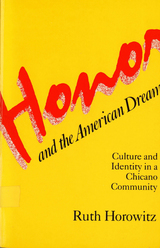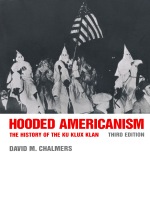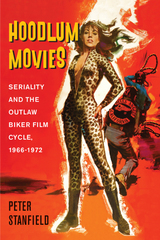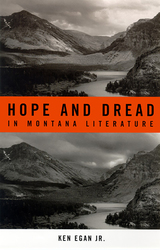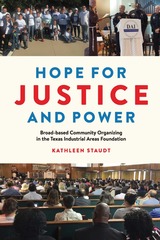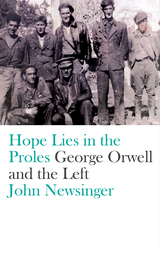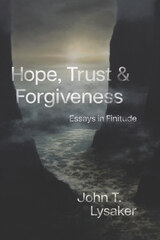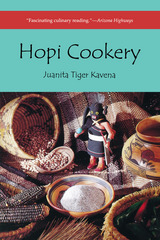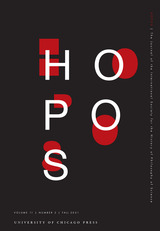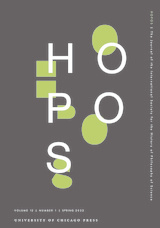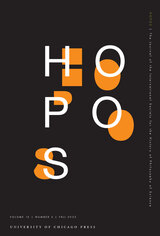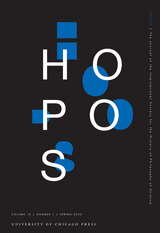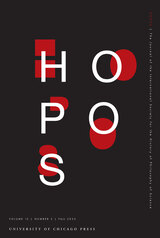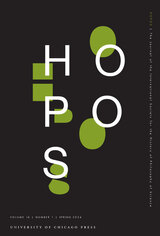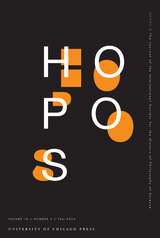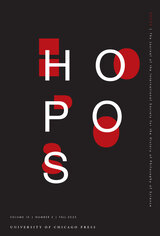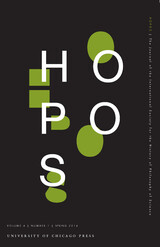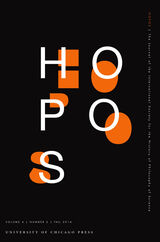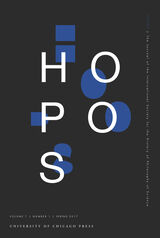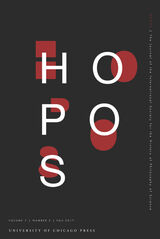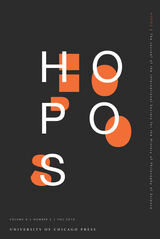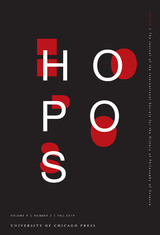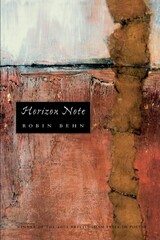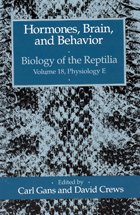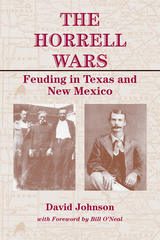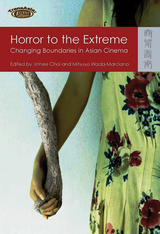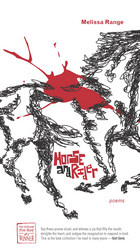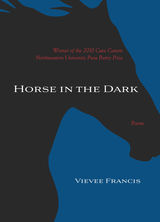Hometown for an Hour: Poems
Jennifer Rose
Ohio University Press, 2006 In her second collection of poems, Jennifer Rose writes primarily of places and displacement. Using the postcard’s conventions of brevity, immediacy, and, in some instances, humor, these poems are greetings from destinations as disparate as Cape Cod, Kentuckiana, and Croatia. Rich in imagery, deftly crafted, and imbued with a lightness of voice, these poems are also postmarked from poetry’s more familiar provinces of love, nature, and loss.
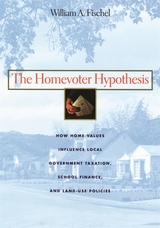 The Homevoter Hypothesis: How Home Values Influence Local Government Taxation, School Finance, and Land-Use Policies
William A. Fischel
Harvard University Press, 2004 Just as investors want the companies they hold equity in to do well, homeowners have a financial interest in the success of their communities. If neighborhood schools are good, if property taxes and crime rates are low, then the value of the homeowner’s principal asset—his home—will rise. Thus, as William Fischel shows, homeowners become watchful citizens of local government, not merely to improve their quality of life, but also to counteract the risk to their largest asset, a risk that cannot be diversified. Meanwhile, their vigilance promotes a municipal governance that provides services more efficiently than do the state or national government.
Fischel has coined the portmanteau word “homevoter” to crystallize the connection between homeownership and political involvement. The link neatly explains several vexing puzzles, such as why displacement of local taxation by state funds reduces school quality and why local governments are more likely to be efficient providers of environmental amenities. The Homevoter Hypothesis thereby makes a strong case for decentralization of the fiscal and regulatory functions of government.
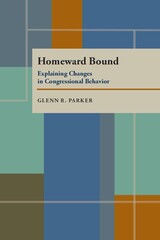 Homeward Bound: Explaining Changes in Congressional Behavior
Glenn R. Parker
University of Pittsburgh Press, 1986
Richard Fenno first coined the term home style to describe the ways in which members of Congress cultivate the voters of their home constituencies. He suggested that incumbents were paying more attention to their constituents than they had in the past. In this book, Glenn Parker examines the relationship between activities at home and in Washington, asking specifically: Why and when did congressmen and senators begin to pay more attention to their constituents? And what are the institutional consequences of this change?
Using data drawn from the travel vouchers filed by incumbent senators and congressmen between 1959 and 1980, Parker shows that since the mid-1960s incumbents have been placing greater emphasis on service to their state or district. Congress has facilitated this change in various ways, such as by increasing travel allowances and by scheduling that minimizes the conflict between legislative business in Washington and time spent with constituents.
Parker's study includes both the Senate and House, and he draws distinctions between the home-style behaviors of senators and representatives. He also provides a historical context for understanding the dynamics of changes in home style. The time-series data generate explanations that specify relationships among historical conditions, individual behavior, and institutional structures.
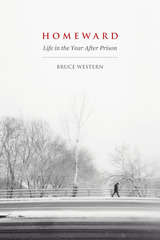 Homeward: Life in the Year After Prison
Bruce Western
Russell Sage Foundation, 2018 In the era of mass incarceration, over 600,000 people are released from federal or state prison each year, with many returning to chaotic living environments rife with violence. In these circumstances, how do former prisoners navigate reentering society? In Homeward, sociologist Bruce Western examines the tumultuous first year after release from prison. Drawing from in-depth interviews with over one hundred individuals, he describes the lives of the formerly incarcerated and demonstrates how poverty, racial inequality, and failures of social support trap many in a cycle of vulnerability despite their efforts to rejoin society.
Western and his research team conducted comprehensive interviews with men and women released from the Massachusetts state prison system who returned to neighborhoods around Boston. Western finds that for most, leaving prison is associated with acute material hardship. In the first year after prison, most respondents could not afford their own housing and relied on family support and government programs, with half living in deep poverty. Many struggled with chronic pain, mental illnesses, or addiction—the most important predictor of recidivism. Most respondents were also unemployed. Some older white men found union jobs in the construction industry through their social networks, but many others, particularly those who were black or Latino, were unable to obtain full-time work due to few social connections to good jobs, discrimination, and lack of credentials. Violence was common in their lives, and often preceded their incarceration. In contrast to the stereotype of tough criminals preying upon helpless citizens, Western shows that many former prisoners were themselves subject to lifetimes of violence and abuse and encountered more violence after leaving prison, blurring the line between victims and perpetrators.
Western concludes that boosting the social integration of former prisoners is key to both ameliorating deep disadvantage and strengthening public safety. He advocates policies that increase assistance to those in their first year after prison, including guaranteed housing and health care, drug treatment, and transitional employment. By foregrounding the stories of people struggling against the odds to exit the criminal justice system, Homeward shows how overhauling the process of prisoner reentry and rethinking the foundations of justice policy could address the harms of mass incarceration.
Homeward To Zion: The Mormon Migration from Scandinavia
William Mulder
University of Minnesota Press, 2000 The classic history of this emblematic moment in U.S. immigration. In the late nineteenth century, thirty thousand Mormons from Norway, Sweden, Denmark, and Finland immigrated to Utah, dissatisfied with conditions in their homelands. As their countrymen were farming rich fields in other parts of the United States, Scandinavian Mormons were making their way to Salt Lake City. Homeward to Zion tracks this movement from northern Europe to the western desert, examining the Mormon recruiting efforts in Scandinavia as well as the arduous journey across the Great Plains. Mulder draws extensively from personal narratives of these immigrants to relate their pioneering experience and their role in the history of Scandinavian migration and of the settlement of the American West.
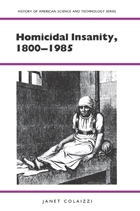 Homicidal Insanity, 1800-1985
Janet Colaizzi, with a foreword by Jonas R. Rappeport
University of Alabama Press, 1989 Where madness meets the law, history leaves no easy verdict. Homicidal insanity has remained a vexation to both the psychiatric and legal professions despite the panorama of scientific and social change during the past 200 years. The predominant opinion today among psychiatrists is that no correlation exists between dangerousness and specific mental disorders. But for generation after generation, psychiatrists have reported cases of insane homicide that were clinically similar. Although psychiatric theory changed and psychiatric nosology was inconsistent, the mental phenomena psychiatrists identified in such cases remained the same. The central thesis of Homicidal Insanity is that as psychiatric theory changed, psychiatrists regarded these phenomena variously as symptoms of mental disease or the disease in itself. It is possible to trace these phenomena throughout the history of Anglo-American psychiatric theory and practice. A secondary thesis of the book is that psychiatrists have used these phenomena as predictors and markers in the practical matters of preventing insane homicide and of testifying in the courts to defend the irresponsible and expose the culpable. For 200 years, scientific and philosophical disagreement raised controversy and brought the issues to public attention. Still, to this day no rational method exists to discriminate the dangerous from the harmless in matters of involuntary commitment, nor insanity from crime in the courts.
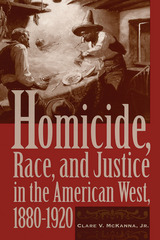 Homicide, Race, and Justice in the American West, 1880-1920
Clare V. McKanna
University of Arizona Press, 1997 In a chilling scene in the film Unforgiven, Clint Eastwood as the gunman stands over a wounded Gene Hackman, the sheriff, aiming a rifle at his head. "I don't deserve this, to die like this," says Hackman. Eastwood replies, "Deserve's got nothing to do with it," cocks his rifle, and fires point blank at his helpless victim.
This scenario dramatically brings home to the viewer what historians have long debated and hundreds of other films and books suggest: the turn-of-the-century West was a violent time and place. Ranchers, miners, deputy sheriffs, teenagers and old men, occasionally even housewives and mothers found themselves at the business end of a shotgun or a .38 revolver. Yet, since western historians tend to portray violence as essentially episodic--frontier gunfights, range wars, vigilante movements, and the like--solid data has been hard to come by.
As a beginning point for actually measuring lethal violence and assessing the administration of justice, here at last is a detailed and well-documented study of homicide in the American West. Comparing data from representative areas--Douglas County, Nebraska; Las Animas County, Colorado; and Gila County, Arizona--this book reveals a level of violence far greater than many historians have believed, even surpassing eastern cities like New York and Boston.
Clashing cultures and transient populations, a boomtown mentality, easy availability of alcohol and firearms: these and many other factors come under scrutiny as catalysts in the violence that permeated the region. By comparing homicide data, including coroner's inquests, indictments, plea bargains, and sentences across both racial and regional lines, the book also offers persuasive evidence that criminal justice systems of the Old West were weighted heavily in favor of defendants who were white and against those who were African American, Native American, or Mexican.
Packed with information, this is a book for students and scholars of western history, social history, criminology, and justice studies. Western history buffs will be captivated by colorful anecdotes about the real West, where guns could and did blaze over anything from love trysts to vendettas to too much foam on the beer. From whatever perspective, all readers are sure to find here a well-constructed framework for understanding the West as it was and for interpreting the region as it moves into the future.
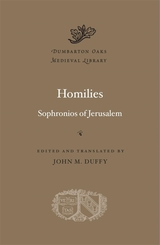 Homilies
Sophronios of Jerusalem
Harvard University Press, 2020 Sophronios, born in Damascus around 560, was a highly educated monk and prolific writer who spent much of his life traveling in the Eastern Roman Empire and promoting the doctrines of the controversial Council of Chalcedon (451). The Homilies—like his poetry, biographies, and miracle accounts—bear eloquent testimony to his tireless struggle on behalf of Orthodoxy and the Christian way of life. The seven sermons collected here were delivered during his short tenure, at his life’s end, as patriarch of Jerusalem (634–638). He saw the Holy City capitulate to the Arab army (638). His Nativity Sermon (634), given while Bethlehem was under siege and his congregation was barred from the annual procession from Jerusalem to the birthplace of Christ, vividly reflects the approach of Islamic forces. Other targets of his venom include pagans, Jews, and despised heretics of all hues. Based on a completely new edition of the Byzantine Greek text, this is the first English translation of the homilies of Sophronios.
 The Homilies of Photius, Patriarch of Constantinople
Cyril Mango
Harvard University Press The middle of the ninth century was a particularly momentous period in the history of the Byzantine Empire. The Iconoclast movement, which had divided Eastern Christendom for over a century, was finally liquidated; the Slavs were converted to Christianity, thus immeasurably enlarging the orbit of Byzantine cultural influence; and a renewed interest in classical literature and learning assured the preservation of the ancient Greek heritage. It was also when the growing hostility between the Eastern and Western Churches erupted in the first great schism.
The homilies of the patriarch Photius—unquestionably the greatest figure of his time—hold an important place among the literary documents of the ninth century. Although the original Greek texts were published early in the twentieth century, his homilies remained almost unread by modern historians. Cyril Mango has translated the homilies into English, making this primary source of the intellectual, religious, and political history of the ninth century available to a wider audience.
The Homilies of Saint Jerome, Volume 2
Saint Jerome
Catholic University of America Press, 1966 This volume of the Homilies of Saint Jerome contains fifteen homilies on Saint Mark's Gospel, Homilies 75-84.
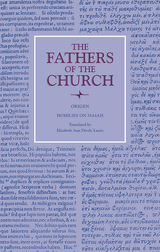 Homilies on Isaiah
Origen
Catholic University of America Press, 2021 Hans Urs von Balthasar places Origen of Alexandria “in rank . . . beside Augustine and Thomas” in “importance for the history of Christian thought,” explaining that his “brilliance” has captivated theologians throughout history (Spirit and Fire, 1984, 1). This brilliance shines forth in his nine extant homilies on Isaiah, in which he employs his theology of the Trinity and Christ to exhort his audience to play their crucial role in salvation history.
Origen reads Isaiah’s vision of the Lord and two seraphim in Isaiah 6 allegorically as representing the Trinity, and this theme runs throughout the nine homilies. His representation of the seraphim as the Son and Holy Spirit around the throne of the Father brought early accusations that Origen was a proto-Arian subordinationist, followed by a pointed condemnation by Emperor Justinian in 553. These homilies, originally delivered between 245 and 248, are extant only in a fourth-century Latin translation. Though St. Jerome, likely because of these controversies, does not identify himself as the Latin translator, the evidence overwhelmingly points to his pen, and his reliability in conveying Origen’s authentic meaning is well documented.
If one sets aside the questionable charges of subordinationism, these homilies, expounding on passages from Judges 6-10, come alive with Origen’s legacy of presenting Christ as the central figure of the soul’s ascent to God. Reading allegorically the two seraphim to be Jesus and the Holy Spirit around the Father’s throne, Origen draws a picture of the Trinity as a tightly knit whole in which the Son and the Holy Spirit eternally sing the Trisagion (“Holy, holy, holy”) to each other and the Father about the divine truths of God’s nature, allowing the part of their song that conveys the “middle things” of salvation history to be heard by creation. The “second seraph” is the Son, or Jesus, who descends holding a hot coal, or Scripture, from the altar of the throne, with which he cleanses Isaiah’s lips, or the believer’s soul. Origen employs his signature exegetical method of allegory and typology through the lens of the threefold meaning of Scripture to emphasize to his hearers that Christ is the deliverer, the content, and the reward of the healing Word. He repeatedly assures them that those who submit to Scripture will enter into salvation history’s cycle of cleansing from sin, growth in virtue, and ever-deepening knowledge of God. As a result, they will become like Christ and thus will be prepared to join the Trinity for all eternity at the heavenly wedding feast.
Homilies on Jeremiah and 1 Kings 28
Origen
Catholic University of America Press, 1998 Presented in this volume are the remains of twenty-two homilies and a collection of fragments delivered by Origen around A.D. 240. The original texts of the homilies on Jeremiah have not come down to us completely; two of the homilies survive only in a Latin translation of St. Jerome. The homily on I Kings 28, while not a part of the homilies on Jeremiah, deals with the Witch of Endor and has been added to this volume in virtue of its own inherent interest.
Homilies on Joshua
Origen
Catholic University of America Press, 2002 No description available
Homilies on Judges
Origen
Catholic University of America Press, 2010 No description available
Homilies on Luke
Origen
Catholic University of America Press, 1996 No description available
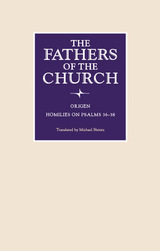 Homilies on Psalms, 36-38
Origen
Catholic University of America Press, 2023 This volume provides the first English translation of the nine extant homilies on Psalms 36[37]–38[39] preached by Origen (d. 253/4) to his congregation at Caesarea as arranged and translated for Latin readers by his admirer, Rufinus of Aquileia (d. 411). These homilies are among the earliest extant examples of patristic preaching on the Psalter. The interpretation offered throughout these homilies, which is almost wholly moral, reflects Origen’s understanding of the “soul” of the scriptural text. These homilies provide a glimpse of Origen’s account of scriptural meaning, outlined in De principiis 4, in pastoral practice. In his preaching, Origen offers a vision of the Christian life as centered on the soul’s continuing conversion, growth, and progress, with particular reference to and within the context of the Church. The life of the believer is one of combat and struggle with powers opposed to Christ. It is Christ, as the divine Physician, who offers healing to the one who is wounded and ailing from sin, and it is Christ, as Wisdom and Word of God, who instructs and educates the believer in the life of the Spirit. These homilies reveal the substantial coherence of Origen’s thought, as expressed in the more speculative De principiis and as revealed in the more elaborate, nuptial theology found in his Commentary on the Canticle. This volume includes a robust introduction and complements the work of Joseph Trigg, whose translation from the original Greek of the cache of homilies discovered in Codex Monacensis 314 has recently appeared in this series.
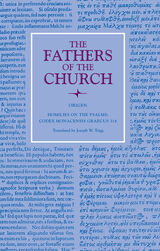 Homilies on the Psalms: Codex Monacensis Graecus 314
Origen
Catholic University of America Press, 2021 In 2012 Dr. Marina Marin Pradel, an archivist at the Bayerische Stattsbibliotek in Munich, discovered that a thick 12th-century Byzantine manuscript, Codex Monacensis Graecus 314, contained twenty-nine of Origen’s Homilies on the Psalms, hitherto considered lost. Lorenzo Perrone of the University of Bologna, an internationally respected scholar of Origen, vouched for the identification and immediately began work on the scholarly edition that appeared in 2015 as the thirteenth volume of Origen’s works in the distinguished Griechische Christlichen Schrifsteller series. In an introductory essay Perrone provided proof that the homilies are genuine and demonstrated that they are, astonishingly, his last known work. Live transcripts, these collection homilies constitute our largest collection of actual Christian preaching from the pre-Constantinian period.
In these homilies, the final expression of his mature thought, Origen displays, more fully than elsewhere, his understanding of the church and of deification as the goal of Christian life. They also give precious insights into his understanding of the incarnation and of human nature. They are the earliest example of early Christian interpretation of the Psalms, works at the heart of Christian spirituality. Historians of biblical interpretation will find in them the largest body of Old Testament interpretation surviving in his own words, not filtered through ancient translations into Latin that often failed to convey his intense philological acumen. Among other things, they give us new insights into the life of a third-century Greco-Roman metropolis, into Christian/Jewish relations, and into Christian worship.
This translation, using the GCS as its basis, seeks to convey, as faithfully as possible, Origen’s own categories of thought. An introduction and notes relate the homilies to the theology and principles of interpretation in Origen’s larger work and to that work’s intellectual context and legacy.
 Homing Instincts
Dionisia Morales
Oregon State University Press, 2018 As a native New Yorker who now calls Oregon home, Dionisia Morales knows how moving and resettling can spark an identity crisis relative to geography, family, and tradition. The essays collected in Homing Instincts explore how Morales’s conception of home plays out in her daily life, as she navigates the gap between where she is and the stories she tells herself about where she belongs.
Although Morales migrated from one North American coast to another, the questions she raises are relevant to migrations of any scale and place, whether across town or around the world. What does it mean to be a newcomer? Who has the right to claim a sense of place? What is gained or lost when we try to fit in? In a world where people are migrating more than ever for social, economic, personal, and political reasons, these questions take on a new urgency.
A wife and mother as well as a professional writer and editor, Morales writes with grace and resolve about a broad range of topics, including pregnancy, people watching, rock climbing, and bee colony collapse. She channels a spirit of adventure and adaptability while acknowledging how certain habits and mindsets are indelibly ingrained and are—like it or not—forever part of where, what, and who we call home.
As issues of migration and social integration play out in national and international politics, Morales provides a personal lens through which readers can appreciate that at one time or another we have all been in the process of arriving. Homing Instincts is a remarkable debut from a gifted prose stylist. It will be warmly received by lovers of the essay form and anyone who has sought, or still seeks, a place to call home.
Hommes, encore un effort…: Anthropogenèse, christianisme, sexuation
Thierry de Duve
Diaphanes, 2023 Dans ce petit livre intempestif arc-bouté à la conviction selon laquelle « le christianisme est la religion de la sortie de la religion » (Marcel Gauchet), Thierry de Duve sort des disciplines qui sont les siennes, l’esthétique et histoire de l’art, pour aborder deux questions anthropologiques que la mutation de l’ordre symbolique en cours rend pressantes : la différence des sexes, qu’il envisage par le biais de l’incertitude de la paternité, et l’avenir de la politique d’émancipation, qu’il ancre à la naissance prématurée des enfants humains. Le ton de ce livre est une certaine effronterie respectueuse par laquelle de Duve engage un dialogue imaginaire avec quelques grandes figures intellectuelles, parmi lesquelles Françoise Héritier, Alain Badiou, Georges Duby, Marcel Gauchet et, last but not least, Jacques Lacan.
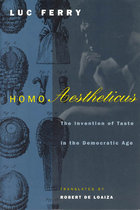 Homo Aestheticus: The Invention of Taste in the Democratic Age
Luc Ferry
University of Chicago Press, 1993 Can subjective, individual taste be reconciled with an objective, universal standard? In Homo Aestheticus, Luc Ferry argues that this central problem of aesthetic theory is fundamentally related to the political problem of democratic individualism.
Ferry's treatise begins in the mid-1600s with the simultaneous invention of the notions of taste (the essence of art as subjective pleasure) and modern democracy (the idea of the State as a consensus among individuals). He explores the differences between subjectivity and individuality by examining aesthetic theory as developed first by Kant's predecessors and then by Kant, Hegel, Nietzsche, and proponents of the avant-garde. Ferry discerns two "moments" of the avant-garde aesthetic: the hyperindividualistic iconoclasm of creating something entirely new, and the hyperrealistic striving to achieve an extraordinary truth. The tension between these two, Ferry argues, preserves an essential element of the Enlightenment concern for reconciling the subjective and the objective—a problem that is at once aesthetic, ethical, and political.
Rejecting postmodern proposals for either a radical break with or return to tradition, Ferry embraces a postmodernism that recasts Enlightenment notions of value as a new intersubjectivity. His original analysis of the growth and decline of the twentieth-century avant-garde movement sheds new light on the connections between aesthetics, ethics, and political theory.
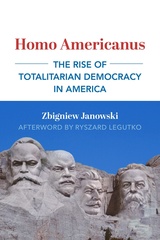 Homo Americanus: The Rise of Totalitarian Democracy in America
Zbigniew Janowski
St. Augustine's Press, 2021 What is the man who cannot be known apart from his socio-political environment? As Zbigniew Janowski asserts, one does not ask who this man is, for he does not even know himself. This man is suppressed and separated, and not by Fascism or Communism. In present-day America this has been accomplished by democracy.
“Only someone shortsighted, or someone who values equality more than freedom, would deny that today’s citizens enjoy little or no freedom, particularly freedom of speech, and even less the ability to express openly or publicly the opinions that are not in conformity with what the majority considers acceptable at a given moment. It may sound paradoxical to contemporary ears, but a fight against totalitarianism must also mean a fight against the expansion of democracy.”
Janowski all at once brazen and out of bounds states what he calls the obvious and unthinkable truth: In the United States, we are already living in a totalitarian reality. The American citizen, the Homo Americanus, is an ideological being who is no longer good or bad, reasonable or irrational, proper or improper except when measured against the objectives of the dominating egalitarian mentality that American democracy has successfully incubated. American democracy has done what other despotic regimes have likewise achieved––namely, taken hold of the individual and forced him to renounce (or forget) his greatness, pursuit of virtue and his orientation toward history and Tradition.
Homo Americanus, Janowski argues, has no mind or soul and he cannot tolerate diversity and indeed he now censors himself. Democracy is not benign, and we should fear its principles come by and applied ad hoc. It is deeply troublesome that in the way democracy moves today it gives critics no real insight into any trajectory of reason behind its motion, which is erratic and unmappable. The Homo Americanus is an ideological entity whose thought and even morality are forbidden from universal abstraction.
Janowski mounts the offensive against what the American holds most sacred, and he does so in order to save him. After exposing the danger and the damage done, Janowski makes another startling proposal. It is a “diseased collective mind” that is the source of this ideology, the liberal anti-perspective that presses man into the image of the Homo Americanus, and its grip can only be broken through the recovery of instinct. Homo Americanus cannot be free again until he is himself again. That is, until the shadow that belongs only to him is restored, and he is thereby no longer alienated from others. Despite the condemnation Janowski seems to be levying on the citizen of the United States, he betrays a great hope and confidence that the means to shake ourselves awake from the bad dream are nevertheless in hand.
Janowski’s work is the next title in St. Augustine’s Press Dissident American Thought Today Series. It occupies a controversial overlapping terrain between the philosophical descriptions of liberalism as a tradition, psychology and the fundamentally influential critiques of democracy offered by Thucydides, Jefferson, Franklin, Tocqueville, Mill, Burke and more. More anecdotal than analytical, Janowski offers the contemporary proof that the reader is right to be scandalized by democracy and his or her own likeness of the Homo Americanus. Once upon a time it was the despicable Homo Sovieticus fruit of tyranny, but now we fear democratic society too might fall and all its citizens never be found again.
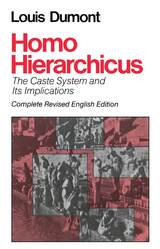 Homo Hierarchicus: The Caste System and Its Implications
Louis Dumont
University of Chicago Press, 1981 Louis Dumont's modern classic, here presented in an enlarged, revised, and corrected second edition, simultaneously supplies that reader with the most cogent statement on the Indian caste system and its organizing principles and a provocative advance in the comparison of societies on the basis of their underlying ideologies. Dumont moves gracefully from the ethnographic data to the level of the hierarchical ideology encrusted in ancient religious texts which are revealed as the governing conception of the contemporary caste structure. On yet another plane of analysis, homo hierarchicus is contrasted with his modern Western antithesis, homo aequalis.
This edition includes a lengthy new Preface in which Dumont reviews the academic discussion inspired by Homo Hierarchicus and answers his critics. A new Postface, which sketches the theoretical and comparative aspects of the concept of hierarchy, and three significant Appendixes previously omitted from the English translation complete this innovative and influential work.
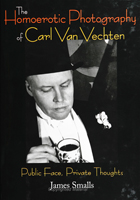 The Homoerotic Photography of Carl Van Vechten: Public Face, Private Thoughts
James Smalls
Temple University Press, 2006 Carl Van Vechten (1880-1964) was perhaps the most notorious white patron of the arts of black America, particularly during the Harlem Renaissance. In 1932, he gave up a career as a theater critic and a novelist of light fiction to become a full-time amateur photographer. His photographs of the era's celebrated African American cultural figures are well-known, but until recently his private, homoerotic interracial photographs were sealed in an archive. Author James Smalls considers how these images relate to Van Vechten's public persona and private desires. He discusses the interracial photographs in the context of white privilege and exotic tourism, primitivism's relation to modernism, camp sensibility and theatricality, and the vibrancy of underground gay visual culture during periods of political oppression. He also considers contemporary viewers' conflicting responses to the eroticized black male body in Van Vechten's and later twentieth-century photography. This original and provocative book embraces transracial voyeuristic pleasure while acknowledging the negative political implications of that pleasure. Amply illustrated with 60 pioneering duotones, The Homoerotic Photography of Carl Van Vechten celebrates the sensual nude male form with both candor and reverence, offering a rare glimpse into the private domain of the master photographer and his handsome subjects.
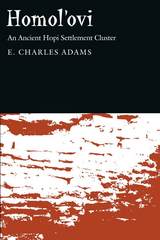 Homol'ovi: An Ancient Hopi Settlement Cluster
E. Charles Adams
University of Arizona Press, 2002 Beginning sometime in the thirteenth century, people from the Hopi Mesas established a cluster of villages to the south along the Little Colorado River. They were attracted by the river’s resources and the region's ideal conditions for growing cotton. By the late 1300s, these Homol'ovi villages were the center of a robust trade in cotton among many clusters of villages near or on the southern Colorado Plateau and were involved in the beginning of katsina religion among Hopi people.
Charles Adams has directed fifteen years of research at these sites for the Arizona State Museum, including excavations in five of the seven primary Homol'ovi villages and in other villages predating them. Through this research he concludes that the founders of these settlements were Hopis who sought to protect their territory from migrating groups elsewhere in the Pueblo world. This book summarizes that research and broadens our understanding of the relationship of Homol'ovi to ancient and modern Hopi people.
Each Homol'ovi village had a unique history of establishment, growth, sociopolitical organization, length of occupation, and abandonment; and although the villages shared much in the way of material culture, their size and configuration were tremendously varied. By comparing Homol'ovi research to information from projects on other settlements in the area, Adams has been able to reconstruct a provocative history of the Homol'ovi cluster that includes relationships among the individual villages and their relationships to nearby clusters. He shows that social organization within villages is apparent by the number and variety of ritual structures, while political organization among villages is indicated by the need for cooperation to share water for irrigation and by the exchange of such materials as pottery, obsidian, and ground stone.
Adams advances several important theories about why Homol'ovi was founded where and when it was, who its founders were, and the importance of cotton in making Homol'ovi an important center of trade in the 1300s. He also considers why Pueblo settlements suddenly became so large, addressing theoretical issues pertaining to multiple settlements and the rise of enormous villages containing more than 1,000 rooms.
Homol'ovi is a rich work of synthesis and interpretation that will be important for anyone with an interest in Southwest archaeology, Arizona history, or Hopi culture. By considering the settlement trajectory of an entire cluster of sites, it will also prove valuable to archaeologists worldwide.
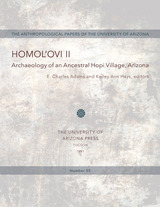 Homol'ovi II: Archaeology of an Ancestral Hopi Village, Arizona
Edited by E. Charles Adams and Kelley Ann Hays
University of Arizona Press, 1991 Homol'ovi II is a fourteenth-century, ancestral Hopi pueblo with over 700 rooms. Although known by archaeologists since 1896, no systematic excavations were conducted at the pueblo until 1984. This report summarizes the findings of the excavations by the Arizona State Museum of five rooms and an outside activity area, which now form the core of the interpretive program for Homolovi Ruins State Park. The significant findings reported here are that the excavated deposits date between A.D. 1340 and 1400; that nearly all the decorated ceramics during this period were imported from villages on the Hopi Mesas; that cotton was a principal crop which probably formed the basis of Homol'ovi II's participation in regional exchange; that chipped stone was a totally expedient technology in contrast to ground stone which was becoming more diverse; and that the katsina cult was probably present or developing at Homol'ovi II. These findings from the basis for future excavations that should broaden our knowledge of the developments taking place in fourteenth-century Pueblo society connecting the people whom archaeologists term the Anasazi with those calling themselves Hopi.
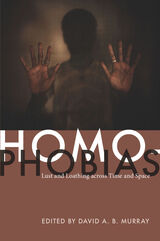 Homophobias: Lust and Loathing across Time and Space
David A. B. Murray, ed.
Duke University Press, 2009 What is it about “the homosexual” that incites vitriolic rhetoric and violence around the world? How and why do some people hate queers? Does homophobia operate differently across social, political, and economic terrains? What are the ambivalences in homophobic discourses that can be exploited to undermine its hegemonic privilege? This volume addresses these questions through critical interrogations of sites where homophobic discourses are produced. It provides innovative analytical insights that expose the complex and intersecting cultural, political, and economic forces contributing to the development of new forms of homophobia. And it is a call to action for anthropologists and other social scientists to examine more carefully the politics, histories, and contexts of places and people who profess hatred for queerness. The contributors to this volume open up the scope of inquiry into processes of homophobia, moving the analysis of a particular form of “hate” into new, wider sociocultural and political fields. The ongoing production of homophobic discourses is carefully analyzed in diverse sites including New York City, Australia, the Caribbean, Greece, India, and Indonesia, as well as American Christian churches, in order to uncover the complex operational processes of homophobias and their intimate relationships to nationalism, sexism, racism, class, and colonialism. The contributors also critically inquire into the limitations of the term homophobia and interrogate its utility as a cross-cultural designation. Contributors. Steven Angelides, Tom Boellstorff, Lawrence Cohen, Don Kulick, Suzanne LaFont, Martin F. Manalansan IV, David A. B. Murray, Brian Riedel, Constance R. Sullivan-Blum
 Homos
Leo Bersani
Harvard University Press, 1995 Acclaimed for his intricate, incisive, and often controversial explorations of art, literature, and society, Leo Bersani now addresses homosexuality in America.
Hardly a day goes by without the media focusing an often sympathetic beam on gay life--and, with AIDS, on gay death. Gay plays on Broadway, big book awards to authors writing on gay subjects, Hollywood movies with gay themes, gay and lesbian studies at dozens of universities, openly gay columnists and even editors at national mainstream publications, political leaders speaking in favor of gay rights: it seems that straight America has finally begun to listen to homosexual America.
Still, Bersani notes, not only has homophobia grown more virulent, but many gay men and lesbians themselves are reluctant to be identified as homosexuals. In Homos, he studies the historical, political, and philosophical grounds for the current distrust, within the gay community, of self-identifying moves, for the paradoxical desire to be invisibly visible. While acknowledging the dangers of any kind of group identification (if you can be singled out, you can be disciplined), Bersani argues for a bolder presentation of what it means to be gay. In their justifiable suspicion of labels, gay men and lesbians have nearly disappeared into their own sophisticated awareness of how they have been socially constructed. By downplaying their sexuality, gays risk self-immolation--they will melt into the stifling culture they had wanted to contest.
In his chapters on contemporary queer theory, on Foucault and psychoanalysis, on the politics of sadomasochism, and on the image of "the gay outlaw" in works by Gide, Proust, and Genet, Bersani raises the exciting possibility that same-sex desire by its very nature can disrupt oppressive social orders. His spectacular theory of "homo-ness" will be of interest to straights as well as gays, for it designates a mode of connecting to the world embodied in, but not reducible to, a sexual preference. The gay identity Bersani advocates is more of a force--as such, rather cool to the modest goal of social tolerance for diverse lifestyles--which can lead to a massive redefining of sociality itself, and of what we might expect from human communities.
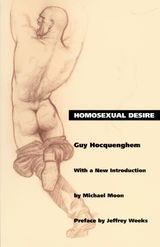 Homosexual Desire
Guy Hocquenghem
Duke University Press, 1993 Originally published in 1972 in France, Guy Hocquenghem's Homosexual Desire has become a classic in gay theory. Translated into English for the first time in 1978 and out of print since the early 1980s, this new edition, with an introduction by Michael Moon, will make available this vital and still relevant work to contemporary audiences. Integrating psychoanalytic and Marxist theory, this book describes the social and psychic dynamics of what has come to be called homophobia and on how the "homosexual" as social being has come to be constituted in capitalist society.
Significant as one of the earliest products of the international gay liberation movement, Hocquenghem's work was influenced by the extraordinary energies unleashed by the political upheavals of both the Paris "May Days" of 1968 and the gay and lesbian political rebellions that occurred in cities around the world in the wake of New York's Stonewall riots of June 1969.
Drawing on the theoretical work of Gilles Deleuze and Félix Guattari and on the shattering effects of innumerable gay "comings-out," Hocquenghem critiqued the influential models of the psyche and sexual desire derived from Lacan and Freud. The author also addressed the relation of capitalism to sexualities, the dynamics of anal desire, and the political effects of gay group-identities.
Homosexual Desire remains an exhilarating analysis of capitalist societies' pervasive fascination with, and violent fear of, same-sex desire and addresses issues that continue to be highly charged and productive ones for queer politics.
Homosexual Desire in Revolutionary Russia: The Regulation of Sexual and Gender Dissent
Dan Healey
University of Chicago Press, 2001 The first full-length study of same-sex love in any period of Russian or Soviet history, Homosexual Desire in Revolutionary Russia investigates the private worlds of sexual dissidents during the pivotal decades before and after the 1917 Bolshevik Revolution. Using records and archives available to researchers only since the fall of Communism, Dan Healey revisits the rich homosexual subcultures of St. Petersburg and Moscow, illustrating the ambiguous attitude of the late Tsarist regime and revolutionary rulers toward gay men and lesbians. Homosexual Desire in Revolutionary Russia reveals a world of ordinary Russians who lived extraordinary lives and records the voices of a long-silenced minority.
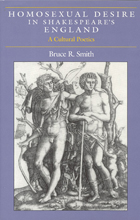 Homosexual Desire in Shakespeare's England: A Cultural Poetics
Bruce R. Smith
University of Chicago Press, 1994 In the most comprehensive study yet of homosexuality in the English Renaissance, Bruce R. Smith examines and rejects the assessments of homosexual acts in moral philosophy, laws, and medical books in favor of a poetics of homosexual desire. Smith isolates six different "myths" from classical literature and discusses each in relation to a particular Renaissance literary genre and to a particular part of the social structure of early modern England. Smith's new Preface places his work in the context of the continuing controversies in gay, lesbian, and bisexual studies.
"The best single analysis of the homoerotic element in Renaissance English literature."—Keith Thomas, New York Review of Books
"Smith's lucid and subtle book offer[s] a poetics of homosexual desire. . . . Its scholarship, impressively broad and deftly deployed, aims to further a serious social purpose: the redemptive location of homosexual desire in history and the recuperation for our own time, through an understanding of its discursive embodiments, of that desire's changing imperatives and parameters."—Terence Hawkes, Times Literary Supplement
"The great strength of Bruce Smith's book is that it does not sidestep the complex challenge of engaging in the sexual politics of the present while attending to the resistant discourses and practices of Renaissance England. Homosexual Desire in Shakespeare's England demonstrates how a commitment to the present opens up our understanding of the past."—Peter Stallybrass, Shakespeare Quarterly
"A major contribution to the understanding of homosexuality in Renaissance England and by far the best and most comprehensive account yet offered of the homoeroticism that suffuses Renaissance literature."—Claude J. Summers, Journal of Homosexuality
Homosexual Tradition in American Poetry
Robert K. Martin
University of Iowa Press, 1998 In this expanded edition, Robert Martin sketches an account of American gay male poetry since the 1970s, including an overview of works by Rafael Campo, Mark Doty, Marlon Riggs, and Reginald Shepherd.
Homosexualities
Stephen O. Murray
University of Chicago Press, 2000 Breathtaking in its historical and geographical scope, this book provides a sweeping examination of the construction of male and female homosexualities, stressing both the variability of the forms same-sex desire can take and the key recurring patterns it has formed throughout history.
"[An] indispensable resource on same-sex sexual relationships and their social contexts. . . . Essential reading." —Choice
"[P]romises to deliver a lot, and even more extraordinarily succeeds in its lofty aims. . . . [O]riginal and refreshing. . . . [A] sensational book, part of what I see emerging as a new commonsense revolution within academe." —Kevin White, International Gay and Lesbian Review
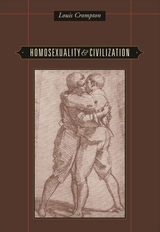 Homosexuality and Civilization
Louis Crompton
Harvard University Press, 2003 How have major civilizations of the last two millennia treated people who were attracted to their own sex? In a narrative tour de force, Louis Crompton chronicles the lives and achievements of homosexual men and women alongside a darker history of persecution, as he compares the Christian West with the cultures of ancient Greece and Rome, Arab Spain, imperial China, and pre-Meiji Japan.
Ancient Greek culture celebrated same-sex love in history, literature, and art, making high claims for its moral influence. By contrast, Jewish religious leaders in the sixth century BCE branded male homosexuality as a capital offense and, later, blamed it for the destruction of the biblical city of Sodom. When these two traditions collided in Christian Rome during the late empire, the tragic repercussions were felt throughout Europe and the New World.
Louis Crompton traces Church-inspired mutilation, torture, and burning of “sodomites” in sixth-century Byzantium, medieval France, Renaissance Italy, and in Spain under the Inquisition. But Protestant authorities were equally committed to the execution of homosexuals in the Netherlands, Calvin’s Geneva, and Georgian England. The root cause was religious superstition, abetted by political ambition and sheer greed. Yet from this cauldron of fears and desires, homoerotic themes surfaced in the art of the Renaissance masters—Donatello, Leonardo, Michelangelo, Sodoma, Cellini, and Caravaggio—often intertwined with Christian motifs. Homosexuality also flourished in the court intrigues of Henry III of France, Queen Christina of Sweden, James I and William III of England, Queen Anne, and Frederick the Great.
Anti-homosexual atrocities committed in the West contrast starkly with the more tolerant traditions of premodern China and Japan, as revealed in poetry, fiction, and art and in the lives of emperors, shoguns, Buddhist priests, scholars, and actors. In the samurai tradition of Japan, Crompton makes clear, the celebration of same-sex love rivaled that of ancient Greece.
Sweeping in scope, elegantly crafted, and lavishly illustrated, Homosexuality and Civilization is a stunning exploration of a rich and terrible past.
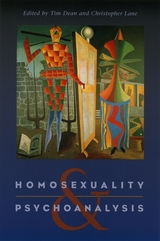 Homosexuality and Psychoanalysis
Edited by Tim Dean and Christopher Lane
University of Chicago Press, 2001 A groundbreaking analysis of the troubled relationship between homosexuality and psychoanalysis, including two previously untranslated essays by Michel Foucault
Why has homosexuality always fascinated and vexed psychoanalysis? This groundbreaking collection of original essays reconsiders the troubled relationship between same-sex desire and psychoanalysis, assessing homosexuality's status in psychoanalytic theory and practice, as well as the value of psychoanalytic ideas for queer theory. The contributors, each distinguished clinicians and specialists, reexamine works by Freud, Klein, Reich, Lacan, Laplanche, and their feminist and queer revisionists. Sharing a commitment to conscious and unconscious forms of homosexual desire, they offer new perspectives on pleasure, perversion, fetishism, disgust, psychosis, homophobia, AIDS, otherness, and love. Including two previously untranslated essays by Michel Foucault, Homosexuality and Psychoanalysis will interest cultural theorists, psychoanalysts, and anyone concerned with the fate of sexuality in our time.
Contributors:
Lauren Berlant
Leo Bersani
Daniel L. Buccino
Arnold I. Davidson
Tim Dean
Jonathan Dollimore
Brad Epps
Michel Foucault
Lynda Hart
Jason B. Jones
Christopher Lane
H. N. Lukes
Catherine Millot
Elizabeth A. Povinelli
Ellie Ragland
Paul Robinson
Judith Roof
Joanna Ryan
Ramón E. Soto-Crespo
Suzanne Yang
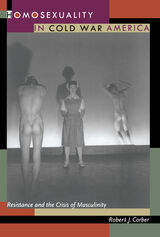 Homosexuality in Cold War America: Resistance and the Crisis of Masculinity
Robert J. Corber
Duke University Press, 1997 Challenging widely held assumptions about postwar gay male culture and politics, Homosexuality in Cold War America examines how gay men in the 1950s resisted pressures to remain in the closet. Robert J. Corber argues that a form of gay male identity emerged in the 1950s that simultaneously drew on and transcended left-wing opposition to the Cold War cultural and political consensus. Combining readings of novels, plays, and films of the period with historical research into the national security state, the growth of the suburbs, and postwar consumer culture, Corber examines how gay men resisted the "organization man" model of masculinity that rose to dominance in the wake of World War II.
By exploring the representation of gay men in film noir, Corber suggests that even as this Hollywood genre reinforced homophobic stereotypes, it legitimized the gay male "gaze." He emphasizes how film noir’s introduction of homosexual characters countered the national "project" to render gay men invisible, and marked a deep subversion of the Cold War mentality. Corber then considers the work of gay male writers Tennessee Williams, Gore Vidal, and James Baldwin, demonstrating how these authors declined to represent homosexuality as a discrete subculture and instead promoted a model of political solidarity rooted in the shared experience of oppression. Homosexuality in Cold War America reveals that the ideological critique of the dominant culture made by gay male authors of the 1950s laid the foundation for the gay liberation movement of the following decade.
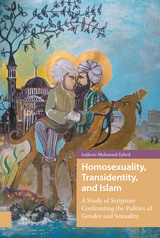 Homosexuality, Transidentity, and Islam: A Study of Scripture Confronting the Politics of Gender and Sexuality
Ludovic-Mohamed Zahed
Amsterdam University Press, 2020 -- With a foreword from Jan Jaap de Ruiter. Translation and Afterword by Adi S. Bharat. -- In Homosexuality, Transidentity, and Islam: A Study of Scripture Confronting the Politics of Gender and Sexuality, Ludovic-Mohamed Zahed systematically analyses the entirety of Islamic scriptural sources that relate to the question of gender and sexuality in relation to their historical contexts. Through an approach that is certainly more politically engaged than that of most Islamic thinkers of our time, he clarifies key theological concepts that may seem esoteric to the uninitiated. In doing so, he makes a compelling case for the compatibility of sexual and gender diversity within Islam. Zahed also examines the historical and contemporary socio-political impacts of inclusive and exclusive (or, quite simply, homophobic, transphobic, and misogynistic) interpretations of scripture. This important study dynamically examines the connections between scripture, interpretation, and the politics of gender and sexuality.
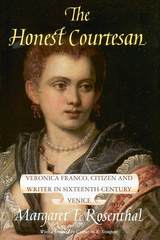 The Honest Courtesan: Veronica Franco, Citizen and Writer in Sixteenth-Century Venice
Margaret F. Rosenthal
University of Chicago Press, 1992 The Venetian courtesan has long captured the imagination as a female symbol of sexual license, elegance, beauty, and unruliness. What then to make of the cortigiana onesta—the honest courtesan who recast virtue as intellectual integrity and offered wit and refinement in return for patronage and a place in public life? Veronica Franco (1546-1591) was such a woman, a writer and citizen of Venice, whose published poems and familiar letters offer rich testimony to the complexity of the honest courtesan's position.
Margaret F. Rosenthal draws a compelling portrait of Veronica Franco in her cultural social, and economic world. Rosenthal reveals in Franco's writing a passionate support of defenseless women, strong convictions about inequality, and, in the eroticized language of her epistolary verses, the seductive political nature of all poetic contests. It is Veronica Franco's insight into the power conflicts between men and women—and her awareness of the threat she posed to her male contemporaries—that makes her literary works and her dealings with Venetian intellectuals so pertinent today.
Combining the resources of biography, history, literary theory, and cultural criticism, this sophisticated interdisciplinary work presents an eloquent and often moving account of one woman's life as an act of self-creation and as a complex response to social forces and cultural conditions.
"A book . . . pleasurably redolent of Venice in the 16th-century. Rosenthal gives a vivid sense of a world of salons and coteries, of intricate networks of family and patronage, and of literary exchanges both intellectual and erotic."—Helen Hackett, Times Higher Education Supplement
The Honest Courtesan is the basis for the film Dangerous Beauty (1998) directed by Marshall Herskovitz. (The film was re-titled The Honest Courtesan for release in the UK and Europe in 1999.)
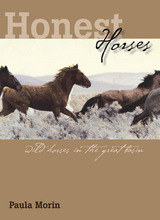 Honest Horses: Wild Horses In The Great Basin
Paula Morin
University of Nevada Press, 2006 Horses have been part of the American West since the first Spanish explorers brought their European-bred steeds onto the new continent. Soon thereafter, some of these animals, lost or abandoned by their owners or captured by indigenous peoples, became the foundation of the great herds of mustangs (from the Spanish mesteño, stray) that still roam the West. These feral horses are inextricably intertwined with the culture, economy, and mythology of the West. The current situation of the mustangs as vigorous competitors for the scanty resources of the West’s drought-parched rangelands has put them at the center of passionate controversies about their purpose, place, and future on the open range. Photographer/oral historian Paula Morin has interviewed sixty-two people who know these horses best: ranchers, horse breeders and trainers, Native Americans, veterinarians, wild horse advocates, mustangers, range scientists, cowboy poets, western historians, wildlife experts, animal behaviorists, and agents of the federal Bureau of Land Management. The result is the most comprehensive, impartial examination yet of the history and impact of wild mustangs in the Great Basin. Morin elicits from her interviewees a range of expertise, insight, and candid opinion about the nature of horses, ranching, and the western environment. Honest Horses brings us the voices of authentic westerners, people who live intimately with horses and the land, who share their experiences and love of the mustangs, and who understand how precariously all life exists in Great Basin.
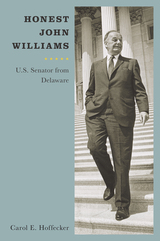 Honest John Williams: U.S. Senator from Delaware
Carol E. Hoffecker
University of Delaware Press, 2024 John J. Williams was elected to the U.S. Senate in 1946, defeating incumbent Democratic U.S. Senator James M. Tunnell. Honest John Williams: U.S. Senator from Delaware examines the political career of Williams, a political novice who established himself as an important advocate for fiscal probity and integrity in government during four successive terms in the U.S. Senate between 1947 and 1970. Over the course of those twenty-four years in the Senate, which spanned the administrations of five separate U.S. presidents (Truman, Eisenhower, Kennedy, Johnson, and Nixon), Williams positioned himself as an opponent of wasteful government spending and corruption, often working "across the aisle" in order to achieve specific political goals. In Honest John Williams, noted Delaware historian Carol E. Hoffecker offers readers a comprehensive look at the legislative course forged by Delaware’s first four-term senator, a chicken-feed dealer born on a farm near Sussex County who went on to become an important advocate for fiscal probity and integrity in twentieth-century American politics.
 Honest Numbers and Democracy: Social Policy Analysis in the White House, Congress, and the Federal Agencies
Walter Williams
Georgetown University Press, 1998 In Honest Numbers and Democracy, Walter Williams offers a revealing history of policy analysis in the federal government and a scorching critique of what’s wrong with social policy analysis today. Williams, a policy insider who witnessed the birth of domestic policy analysis during the Johnson administration, contends that the increasingly partisan U.S. political environment is vitiating both "honest numbers" — the data used to direct public policy — and, more importantly, honest analysts, particularly in the White House. Drawing heavily on candid off-the-record interviews with political executives, career civil servants, elected officials and Washington-based journalists, Williams documents the steady deformation of social policy analysis under the pressure of ideological politics waged by both the executive and legislative branches. Beginning with the Reagan era and continuing into Clinton’s tenure, Williams focuses on the presidents’ growing penchant to misuse and hide numbers provided by their own analysts to assist in major policy decisions. Honest Numbers and Democracy is the first book to examine in-depth the impact of the electronic revolution, its information overload, and rampant public distrust of the federal government's data on the practice of policy analysis. A hard-hitting account of the factors threatening the credibility of the policymaking process, this book will be required reading for policy professionals, presidential watchers, and anyone interested in the future of U.S. democracy.
The Honest Politician's Guide to Crime Control
Norval Morris and Gordon J. Hawkins
University of Chicago Press, 1970 Norval Morris and Gordon Hawkins's first premise is that our criminal justice system is a moral busybody, unwisely extended beyond its proper role of protecting persons and property. But they go further and systematically cover the amount, costs, causes, and victims of crime: the reduction of violence; the police; corrections; juvenile delinquency; the function of psychiatry in crime control; organized crime; and the uses of criminological research. On each topic precise recommendations are made and carefully defended.
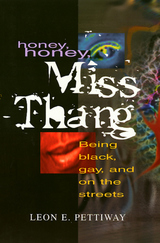 Honey, Honey, Miss Thang: Being Black, Gay, and on the Streets
Leon E. Pettiway
Temple University Press, 1996
Many straight Americans would never embrace homosexuals as neighbors, co-workers, or friends. Still less would they accept as equals those transgendered individuals who work the streets to provide themselves with drug money.
This book seeks to change that perception. It celebrates the lives of Shontae, China, Keisha, Detra, and Monique, five Afro-American gay hustlers who struggle to survive and to maintain a life of dignity and value in the face of their drug use and criminal activity. As individuals they vary in terms of background, the manner in which they entered the transgendered world, and the nature of their initiation into the drug subculture. None of them has escaped the ravages of urban decline, crime, drugs, and poverty that accompany life in an inner city, but by the same token, none of them has capitulated to the stresses with which they live.
It is impossible to read these accounts and not come away emotionally drained. As Monique explains, their lives take place in a world of chances. "You take a chance on living or dying, on being hurt or not being hurt, a chance on finding a friend or finding an enemy." It is from this world that their voices speak so eloquently about their families, hustling, sexuality, sexual abuse, friendship, and intimacy.
By letting these women speak, Leon E. Pettiway evokes questions and encourages discussion and a re-evaluation of those who are labeled as deviant. Pettiway reaches beyond academic convention to offer a view with depth and emotion that mere statistics could never provide. While the poverty and often destructive lifestyle of these women may be gut-wrenching, their experiences reveal joy, pain, and the profound strength of the human spirit with which we can all identify. These lives have much to teach us about ourselves and those we label as "other."
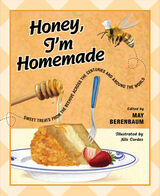 Honey, I'm Homemade: Sweet Treats from the Beehive across the Centuries and around the World
Edited by May Berenbaum, Illustrated by Nils Cordes
University of Illinois Press, 2010 Honey, I'm Homemade: Sweet Treats from the Beehive across the Centuries and around the World showcases a wealth of recipes for cookies, breads, pies, puddings, and cakes that feature honey as an essential ingredient. Noted entomologist May Berenbaum also details the fascinating history of honey harvesting and consumption around the world, explains the honey bee's extraordinary capacity to process nectar into concentrated sweetness, and marvels at honey's diverse flavors and health benefits. Honey is a unique food because of its power to evoke a particular time and place. Every time it is collected from a hive, honey takes on the nuanced flavors of a particular set of flowers--clover, orange blossoms, buckwheat, or others--at a certain point in time processed and stored by a particular group of bees. Honey is not just a snapshot of a time and place--it's the taste of a time and place, and it lends its flavors to the delectable baked goods and other treats found here. More than a cookbook, Honey, I'm Homemade is a tribute to the remarkable work of Apis mellifera, the humble honey bee whose pollination services allow three-quarters of all flowering plant species to reproduce and flourish. Sales of the book will benefit the University of Illinois Pollinatarium--the first freestanding science outreach center in the nation devoted to flowering plants and their pollinators. Because so much depends on honey bees, and because people have benefited from their labors for millennia, Honey, I'm Homemade is the perfect way to share and celebrate honey's sweetness and delight.
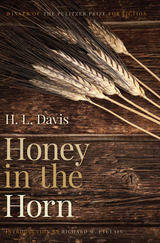 Honey in the Horn
H.L. Davis
Oregon State University Press, 2015 Set in Oregon in the early years of the twentieth century, H. L. Davis’s Honey in the Horn chronicles the struggles faced by homesteaders as they attempted to settle down and eke out subsistence from a still-wild land. With sly humor and keenly observed detail, Davis pays homage to the indomitable character of Oregon’s restless people and dramatic landscapes without romanticizing or burnishing the myths.
Clay Calvert, an orphan, works as a hand on a sheep ranch until he stumbles into trouble and is forced to flee. Journeying throughout the state, from the lush coastal forests, to the Columbia Gorge, to the golden wheat fields east of the Cascades, he encounters a cast of characters as rich and diverse as the land, including a native Tunne boy and a beautiful girl named Luce.
Originally published in 1935, Honey in the Horn reveals as much about the prevailing attitudes and beliefs of H. L. Davis’ lifetime as it does about the earlier era in which it is set. It transcends the limitations of its time through the sheer power and beauty of Davis’ prose. Full of humor and humanity, Davis’s first novel displays a vast knowledge of Pacific Northwest history, lore, and landscape.
An essential book for all serious readers of Northwest literature, this classic coming-of-age novel has been called the “Huckleberry Finn of the West.” It is the only Oregon book that has ever won a Pulitzer Prize for fiction. With a new introduction by Richard W. Etulain, this important work from one of Oregon’s premier authors is once again available for a new generation to enjoy.
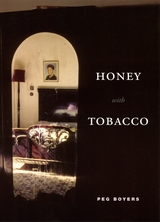 Honey with Tobacco
Peg Boyers
University of Chicago Press, 2007 Pietà
This time the migraine came with a vision
bathed in night sweat:
I was sitting on the Eames chair,
your man’s body on my lap, legs
and arms white as casein draped over
mine, spilling onto the cassock, new sores
on your legs, dried blood
on your feet and hands,
from your chalk mouth
the words forgive me,
from mine, the impossible
no
Hard Bread,Peg Boyers’s debut poetry collection, with verse spoken in the imagined voice of the Italian writer Natalia Ginzburg, was widely praised for its inspired ventriloquism and its brilliant lyricism. In Honey with Tobacco, Boyers’s own intensely personal voice emerges in three strikingly distinctive variants. The first part of the book is the most explicitly autobiographical, bringing together poems that explore the poet’s Cuban American experience and a childhood marked by travel, the tropics, and varieties of disenchantment. The middle sequence of poems concerns a mother, a father, and a son, a postmodern holy family whose ordeals are evoked in a terse, terrifying narrative. In familiar tableaux drawn from the Bible that have inspired great works of art—the Annunciation, the Pieta, and Judgment Day—Boyers explores what it means in contemporary America to be “blessed among women” and whether and how art can contain grief. The final section of the book confronts age, desire, and regret in a series of personal poems that plumb baser human instincts and the speakers’ determination to dwell in darkness, when necessary, without abandoning the sacred. Praise for Hard Bread: “A great achievement of poetic voice . . . . It’s absolutely clear what these poems are ‘about,’ and they are unapologetic in their devotion to subject, clarity, precision, and accessibility.”—Steven Cramer, Poetry
Honeycomb: Poems
Carol Frost
Northwestern University Press, 2010 The poems in PEN Award–winning author Carol Frost’s ninth collection spring from her experiences with her mother’s struggle with Alzheimer’s disease, forming a deeply moving meditation on memory and its role in the creation and evolution of identity and relationships. Frost maintains complete command of her imaginative leaps between the natural and spiritual worlds in diverse poetic forms. Using the disappearance of bees as her prevailing metaphoric backdrop, the poet deftly explores the varied emotions occasioned by her mother’s slow deterioration. Like its eponym, Honeycomb is stunning in its details, but it wears its craftsmanship lightly, yielding an accessible yet profound work.
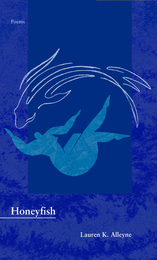 Honeyfish
Lauren K. Alleyne
New Issues Poetry and Prose, 2018 “These poems love. Prophesize. Return us to our beginnings. To
days that we want to remember. Or forget. But don’t. Thus in our
sister’s memory, we survive in the luxury of dying. The courage of
loving. The re-imagining of our souls for another generation. Thank
you, my dear sister for your words saluting our living, our lives.”
—Sonia Sanchez, winner of the 2018 Lifetime Achievement Award
from the Academy of American Poets
“In exquisitely crafted poems of heart-accelerating candor and
clarity, Lauren K. Alleyne says to all the black bodies slain by hatred
and militarized fear, ‘Nothing I say will save you, but how can I say
nothing?’ Honeyfish is an elegy for all the countless lost, and a praise
song for the many black lives that persist in their wish to give and
receive love.”
— Tracy K. Smith, Poet Laureate of the United States of America
“Even in the places we think of as most beautiful, the endless gong
of the body being broken and defiled will find us. How can we see
the sun and the ocean and the clear blue sky as anything other than
a kind of cruel joke in the face of so much suffering? The extraordinary gift of Lauren K Alleyne’s, Honeyfish is that she shows
the world in all its brutality and loss and somehow lets us mourn within the poems, which in
turn allows us to begin some kind of healing. These are poems whose elegy is ongoing, whose
elegy need never happened but for hatred. The waves go in and out and so many people keep
being killed. And here is this extraordinary poet, making a heaven that is freedom, that is the
dream of being welcomed and loved and tended to. This is a book for our times and for the
day when these times are over and we can rejoice.”
— Gabrielle Calvacoressi, author of Rocket Fantastic
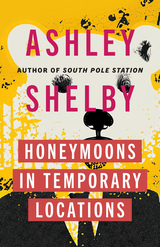 Honeymoons in Temporary Locations
Ashley Shelby
University of Minnesota Press, 2024 Eclectic, experimental, and wildly imaginative climate fictions from a familiar world hauntingly transformed Climate disaster–induced fugue states, mutinous polar bears, support groups for recently displaced millionaires, men who hear trees, and women who lose their wives on environmental refugee resettlement trips. In these dispatches from a weirding world, the absurd and fantastic are increasingly indistinguishable from reality. Exploring this liminal moment, Ashley Shelby’s collection of climate fictions imagines a near future that is both unnervingly familiar and subversively strange. Set in the same post-climate-impact era, these stories range from playfully satirical to poignantly humane, bending traditional narrative forms and coming together into a brilliant and unusual contemplation of our changing world. Featuring the Hugo-nominated novelette “Muri,” Honeymoons in Temporary Locations processes the unthinkable through riotous inventions like guided tours of submerged cities, Craigslist ads placed by climate refugees, and cynical pharmaceutical efforts to market a drug to treat solastalgia, the existential distress caused by environmental change. Shelby reengineers the dystopic bleakness that characterizes so much climate fiction by embracing an eclectic experimentalism leavened with humor, irony, and the inevitable bathos that characterizes the human experience. Unexpected and clever, this innovative collection confirms her status as a visionary writer whose work expands the forms, attitudes, and possibilities of climate fiction.
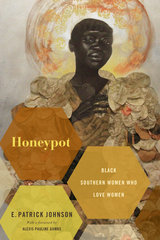 Honeypot: Black Southern Women Who Love Women
E. Patrick Johnson
Duke University Press, 2019 E. Patrick Johnson's Honeypot opens with the fictional trickster character Miss B. barging into the home of Dr. EPJ, informing him that he has been chosen to collect and share the stories of her people. With little explanation, she whisks the reluctant Dr. EPJ away to the women-only world of Hymen, where she serves as his tour guide as he bears witness to the real-life stories of queer Black women throughout the American South. The women he meets come from all walks of life and recount their experiences on topics ranging from coming out and falling in love to mother/daughter relationships, religion, and political activism. As Dr. EPJ hears these stories, he must grapple with his privilege as a man and as an academic, and in the process he gains insights into patriarchy, class, sex, gender, and the challenges these women face. Combining oral history with magical realism and poetry, Honeypot is an engaging and moving book that reveals the complexity of identity while offering a creative method for scholarship to represent the lives of other people in a rich and dynamic way.
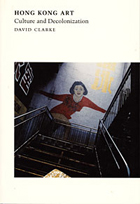 Hong Kong Art: Culture and Decolonization
David Clarke
Duke University Press, 2002 Hong Kong Art is the first comprehensive survey of contemporary art from Hong Kong presented within the changing social and political context of the territory’s 1997 handover from British to Chinese sovereignty. Tracing a distinctive and increasingly vibrant art scene from the late 1960s through the present, David Clarke discusses a wide range of media, including painting, sculpture, photography, video, and installations, as well as other kinds of visual production such as architecture, fashion, graphic design, and graffiti.
Clarke shows how a sense of local identity emerged in Hong Kong as the transition approached and found expression in the often politicized art produced. Given the recent international exposure of mainland Chinese contemporary art, this book considers the uniqueness of the art of China’s most cosmopolitan city. With a modern visual culture that was flourishing even when the People’s Republic was still closed to the outside world, Hong Kong has established itself as an exemplary site for both local and transnational elements to formulate into brilliant and groundbreaking art.
The author writes about individual artists and art works with a detail that will appeal to artists, curators, and art historians, as well as to postcolonial scholars, cultural studies scholars, and others.
 Hong Kong Connections: Transnational Imagination in Action Cinema
Meaghan Morris, Siu-Leung Li, and Stephen Chan Ching-kiu, eds.
Duke University Press, 2005 Since the 1960s, Hong Kong cinema has helped to shape one of the world’s most popular cultural genres: action cinema. Hong Kong action films have proved popular over the decades with audiences worldwide, and they have seized the imaginations of filmmakers working in many different cultural traditions and styles. How do we account for this appeal, which changes as it crosses national borders? Hong Kong Connections brings leading film scholars together to explore the circulation of Hong Kong cinema in Japan, Korea, India, Australia, France, and the United States, as well as its links with Taiwan, Singapore, and the Chinese mainland. In the process, this collection examines diverse cultural contexts for action cinema’s popularity and the problems involved in the transnational study of globally popular forms, suggesting that in order to grasp the history of Hong Kong action cinema’s influence we need to bring out the differences as well as the links that constitute popularity. Contributors. Nicole Brenez, Stephen Chan Ching-kiu, Dai Jinhua, David Desser, Laleen Jayamanne, Kim Soyoung, Siu Leung Li, Adrian Martin, S. V. Srinivas, Stephen Teo, Valentina Vitali, Paul Willemen, Rob Wilson, Wong Kin-yuen, Kinnia Yau Shuk-ting, Yung Sai-shing
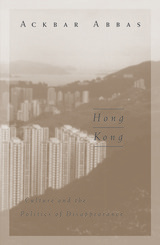 Hong Kong: Culture and the Politics of Disappearance
Ackbar Abbas
University of Minnesota Press, 1997 A consideration of what the culture of Hong Kong tells us about the state of the world at the fin-de-siècle. On June 30, 1997, Hong Kong as we know it will disappear, ceasing its singular and ambiguous existence as a colonial holdover and becoming part of the People’s Republic of China. In an intriguing and provocative exploration of its cinema, architecture, photography, and literature, Ackbar Abbas considers what Hong Kong, with its unique relations to decolonization and disappearance, can teach us about the future of both the colonial city and the global city. The culture of Hong Kong encompasses Jackie Chan and John Woo, British colonial architecture and postmodern skyscrapers. Ironically, it was not until they were faced with the imposition of Mainland power—with the signing of the Sino-British Joint Agreement in 1984—that the denizens of the colony began the search for a Hong Kong identity. According to Abbas, Hong Kong’s peculiar lack of identity is due to its status as “not so much a place as a space of transit,” whose residents think of themselves as transients and migrants on their way from China to somewhere else. Abbas explores the way Hong Kong’s media saturation changes its people’s experience of space so that it becomes abstract, dominated by signs and images that dispel memory, history, and presence.Hong Kong disappears through simple dualities such as East/West and tradition/modernity. What is missing from a view of Hong Kong as merely a colony is the paradox that Hong Kong has benefited from and made a virtue of its dependent colonial status, turning itself into a global and financial city and outstripping its colonizer in terms of wealth.Combining sophisticated theory and a critical perspective, this rich and thought-provoking work captures the complex situation of the metropolis that is contemporary Hong Kong. Along the way, it challenges, entertains, and makes an important contribution to our thinking about the surprising processes and consequences of colonialism.Copublished with Hong Kong University Press
 Hong Kong in Revolt: The Protest Movement and the Future of China
Au Loong-Yu
Pluto Press, 2020 Hong Kong is in turmoil, with a new generation of young and politically active citizens shaking the regime. From the Umbrella Movement in 2014 to the defeat of the Extradition Bill and beyond, the protestors' demands have become more radical, and their actions more drastic. Their bravery emboldened the labor movement and launched the first successful political strike in half a century, followed by the broadening of the democratic movement as a whole. The book also sets the new protest movements within the context of the colonization, revolution and modernization of China. Au Loong-Yu explores Hong Kong's unique position in this history and the reaction the protests have generated on the Mainland. But the new generation's aspiration goes far beyond the political. It is a generation that strongly associates itself with a Hong Kong identity, with inclusivity and openness. Looking deeper into the roots and intricacies of the movement, the role of 'Western Values' vs 'Communism' and 'Hong Kongness' vs 'Chineseness', the cultural and political battles are understood through a broader geopolitical history. For good or for bad, Hong Kong has become one of the battle fields of the great historic contest between the US, the UK and China.
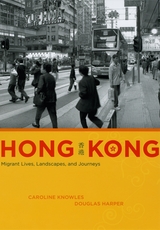 Hong Kong: Migrant Lives, Landscapes, and Journeys
Caroline Knowles and Douglas Harper
University of Chicago Press, 2009 In 1997 the United Kingdom returned control of Hong Kong to China, ending the city’s status as one of the last remnants of the British Empire and initiating a new phase for it as both a modern city and a hub for global migrations. Hong Kong is a tour of the city’s postcolonial urban landscape, innovatively told through fieldwork and photography.
Caroline Knowles and Douglas Harper’s point of entry into Hong Kong is the unusual position of the British expatriates who chose to remain in the city after the transition. Now a relatively insignificant presence, British migrants in Hong Kong have become intimately connected with another small minority group there: immigrants from Southeast Asia. The lives, journeys, and stories of these two groups bring to life a place where the past continues to resonate for all its residents, even as the city hurtles forward into a future marked by transience and transition. By skillfully blending ethnographic and visual approaches, Hong Kong offers a fascinating guide to a city that is at once unique in its recent history and exemplary of our globalized present.
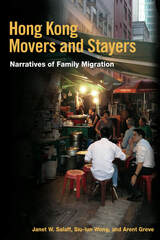 Hong Kong Movers and Stayers: Narratives of Family Migration
Janet W. Salaff, Siu-lun Wong, and Arent Greve
University of Illinois Press, 2010 Half a million Hong Kong residents fled their homeland during the thirteen years before Hong Kong's reversion to China in 1997. Nearly half of those returned within the next several years. Filled with detailed, first-hand stories of nine Hong Kong families over nearly two decades, Hong Kong Movers and Stayers is a multifaceted yet intimate look at the forces behind Hong Kong families' successful, and failed, efforts at migration and settlement. Defining migration as a process, not a single act of leaving, Hong Kong Movers and Stayers provides an antidote to ethnocentric and simplistic theories by uncovering migration stories as they relate to social structures and social capital. The authors meld survey analysis, personal biography, and sociology and compare multiple families in order to give voice to the interplay of gender, age, and diverse family roles as motivating factors in migration.
 Hong Kong New Wave Cinema (1978-2000)
Pak Tong Cheuk
Intellect Books, 2008 The increasingly popular films of the Hong Kong New Wave grapple with such issues as East-West cultural conflicts, colonial politics, the divide between rich and poor, the plight of women in a modernizing Asian city, and the identity crises provoked by Hong Kong’s estranged motherland. Comprehensive and penetrating, Hong Kong New Wave Cinema analyzes the specific films that grew out of this dynamic era and investigates the historical and social conditions that allowed the New Wave to flourish.
Drawing on the auteur and genre theories, Pak Tong Cheuk here examines the cinematic style and aesthetics of New Wave directors, most of whom were educated at British and U.S. film schools. In addition to investigating the narrative content, structure, and mise-en-scène of individual films, this volume traces the overall development of the film and television industries in Hong Kong in the 1960s and 1970s. Cheuk’s intriguing study of the rise and fall of Hong Kong’s golden age of film establishes the New Wave as an era of great historical significance for scholars of cinema, popular culture, and the arts. “An interesting and detailed look at one of the most vital movements in the film industry during the latter part of the twentieth century. Pak’s work not only gives an informative overview of the origins of the movement, but goes into detail about the works of some of the most notable New Wave directors, including Tsui Hark, Ann Hui, and Patrick Tam, and the effects their pictures had on film-makers from all over the world.”—Neil Koch, HKfilm.net
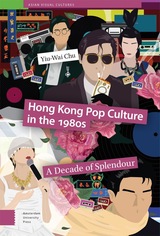 Hong Kong Pop Culture in the 1980s: A Decade of Splendour
Yiu-Wai Chu
Amsterdam University Press, 2023 This book deals with the 1980s – the “golden decade” of Hong Kong pop culture – in which a cosmopolitan lifestyle of pop and chic emerged in the city. Bookended by two major historical incidents, the 1980s will probably enter the annals of Hong Kong history as the decade that defined its future after reversion to Mainland China. Having witnessed and experienced the rise of Hong Kong pop culture to unprecedented heights in this decade, the author enhances its context through a story about his own personal belongings. Examining popular genres including television, film, music, fashion, disco and city magazine, this book teases out the distinctive aspects of Hong Kong pop culture that defined (his) Hong Kong. As Hong Kong has been undergoing drastic changes in recent years, it is necessary to point toward new imaginaries by re-examining its development. Toward this end, this book will shed light on an important research area of Hong Kong Studies as an academic discipline.
Hong Kong Takes Flight: Commercial Aviation and the Making of a Global Hub, 1930s–1998
John D. Wong
Harvard University Press, 2022 Commercial aviation took shape in Hong Kong as the city developed into a powerful economy. Rather than accepting air travel as an inevitability in the era of global mobility, John Wong argues that Hong Kong’s development into a regional and global airline hub was not preordained. By underscoring the shifting process through which this hub emerged, Hong Kong Takes Flight aims to describe globalization and global networks in the making. Viewing the globalization of the city through the prism of its airline industry, Wong examines how policymakers and businesses asserted themselves against international partners and competitors in a bid to accrue socioeconomic benefits, negotiated their interests in Hong Kong’s economic success, and articulated their expressions of modernity.
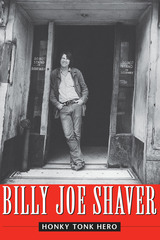 Honky Tonk Hero
By Billy Joe Shaver
University of Texas Press, 2005 Billy Joe Shaver was the real deal. Many agree with him that his songs are pure poetry. Shaver sang about a life that was full of hard times, wild living, and a forty-year-long passion for his late wife Brenda. His songs are raw, honest, and so true that people hear the story of their own lives in his music. No wonder, then, that his songs have also been recorded by artists such as Johnny Cash, Willie Nelson, Waylon Jennings, Kris Kristofferson, George Jones, Bob Dylan, Elvis Presley, Patty Loveless, John Anderson, Tom T. Hall, the Allman Brothers, the Oak Ridge Boys, and Tex Ritter. In this compelling autobiography written with the assistance of Brad Reagan, Billy Joe Shaver looks back over a life that some might call a miracle of survival. His father abandoned the family before Billy Joe was born. Troubles in school and in the military turned him into a fighter, and a sawmill accident claimed two fingers and part of a third on his right hand. Yet his innate musical talent and the encouragement of an English teacher set him on the road to being a songwriter—and he never looked back. Shaver recounts his long struggle to break into the music business in Nashville and the success that came when Waylon Jennings recorded his songs on the 1973 album Honky Tonk Heroes, which became a landmark of outlaw country music. Shaver movingly describes his own up-and-down career as a singer-songwriter in Nashville and Texas; his bouts with alcohol and drugs; his pleasure in touring with his son, Eddy, and their band, Shaver, during the 1990s; and the pain of losing Eddy, Brenda, and Billy Joe's mother all within the year 1999–2000. As full of life, heartbreak, and drama as any of Billy Joe Shaver’s songs, Honky Tonk Hero is the story of a man who not only walked on the wild side and lived to tell about it, but also got it all down in songs that many people consider to be some of the finest country music ever written.
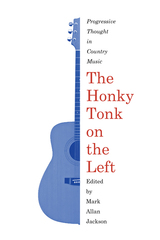 The Honky Tonk on the Left: Progressive Thought in Country Music
Mark Allan Jackson
University of Massachusetts Press, 2018 Massively popular for the past century, country music has often been associated with political and social conservatism. While such figures as George Wallace, Richard Nixon, and Ted Cruz have embraced and even laid claim to this musical genre over the years, country performers have long expressed bold and progressive positions on a variety of public issues, whether through song lyrics, activism, or performance style.
Bringing together a wide spectrum of cultural critics, The Honky Tonk on the Left takes on this conservative stereotype and reveals how progressive thought has permeated country music from its beginnings to the present day. The original essays in this collection analyze how diverse performers, including Fiddlin' John Carson, Webb Pierce, Loretta Lynn, Johnny Cash, O. B. McClinton, Garth Brooks, and Uncle Tupelo, have taken on such issues as government policies, gender roles, civil rights, prison reform, and labor unrest. Taking notice of the wrongs in their eras, these musicians worked to address them in song and action, often with strong support from fans.
In addition to the volume editor, this collection includes work by Gregory N. Reish, Peter La Chapelle, Stephanie Vander Wel, Charles L. Hughes, Ted Olson, Nadine Hubbs, Stephanie Shonekan, Stephen A. King, P. Renee Foster, Tressie McMillan Cottom, Travis D. Stimeling, and Jonathan Silverman.
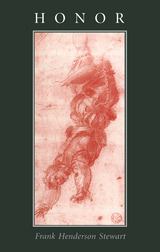 Honor
Frank Henderson Stewart
University of Chicago Press, 1994 What is honor? Is it the same as reputation? Or is it rather a sentiment? Is it a character trait, like integrity? Or is it simply a concept too vague or incoherent to be fully analyzed?
In the first sustained comparative analysis of this elusive notion, Frank Stewart writes that none of these ideas is correct. Drawing on information about Western ideas of honor from sources as diverse as medieval Arthurian romances, Spanish dramas of the sixteenth and seventeenth centuries, and the writings of German jurists of the nineteenth and twentieth centuries, and comparing the European ideas with the ideas of a non-Western society—the Bedouin—Stewart argues that honor must be understood as a right, basically a right to respect. He shows that by understanding honor this way, we can resolve some of the paradoxes that have long troubled scholars, and can make sense of certain institutions (for instance the medieval European pledge of honor) that have not hitherto been properly understood.
Offering a powerful new way to understand this complex notion, Honor has important implications not only for the social sciences but also for the whole history of European sensibility.
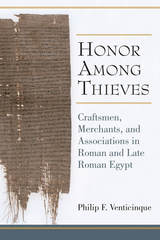 Honor Among Thieves: Craftsmen, Merchants, and Associations in Roman and Late Roman Egypt
Philip F. Venticinque
University of Michigan Press, 2016 Honor Among Thieves examines associations of craftsmen in the framework of ancient economics and transaction costs. Scholars have long viewed such associations primarily as social or religious groups that provided mutual support, proper burial, and sociability, and spaces where nonelite individuals could seek status supposedly denied them in their contemporary society. However, the analysis presented here concentrates on how craftsmen, merchants, and associations interacted with each other and with elite and nonelite constituencies; managed economic, political, social, and legal activities; represented their concerns to the authorities; and acquired and used social capital—a new and important view of these economic engines.
Philip F. Venticinque offers a study of associations from a social, economic, and legal point of view, and in the process examines how they helped their members overcome high transaction costs—the “costs of doing business”—through the development of social capital. He explores associations from the “bottom up,” in order to see how their members create status and reputation outside of an elite framework. He thus explores how occupations regarded as thieves in elite ideology create their own systems of honor.
Honor Among Thieves will be of interest to scholars of the ancient economy, of social groups, and Roman Egypt in all periods.
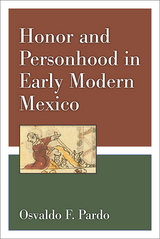 Honor and Personhood in Early Modern Mexico
Osvaldo F. Pardo
University of Michigan Press, 2015 Osvaldo F. Pardo examines the early dissemination of European views on law and justice among Mexico’s native peoples. Newly arrived from Spain in the sixteenth and seventeenth centuries, mendicant friars brought not only their faith in the authority of the Catholic Church but also their reverence of the monarchy. Drawing on a rich range of documents dating from this era—including secular and ecclesiastical legislation, legal and religious treatises, bilingual catechisms, grammars on indigenous languages, historical accounts, and official reports and correspondence—Pardo finds that honor, as well as related notions such as reputation, came to play a central role in shaping the lives and social relations of colonists and indigenous Mexicans alike. Following the application and adaptation of European ideas of justice and royal and religious power as they took hold in the New World, Pardo sheds light on the formation of colonial legalities and long-lasting views, both secular and sacred, that still inform attitudes toward authority in contemporary Mexican society.
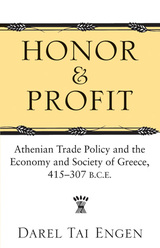 Honor and Profit: Athenian Trade Policy and the Economy and Society of Greece, 415-307 B.C.E.
Darel Tai Engen
University of Michigan Press, 2010 Honor and Profit offers a welcome corrective to the outmoded Finleyite view of the ancient economy. This important volume collects and analyzes economic evidence including government decrees for all known occasions on which Athens granted honors and privileges for services relating to trade. The analysis proceeds within the intellectual framework of substantive economic theory, in which formal market behavior and institutions are considered to be but a subset of a larger group of economic behaviors and institutions devoted to the production, distribution, and exchange of goods. Honor and Profit merges theory with empirical historical evidence to illustrate the complexity and dynamism of the ancient Greek economy. The author's conclusions have broad implications for our understanding not only of Athens and environs but also of the social and political history of Greece and the ancient Mediterranean world. Darel Tai Engen is Associate Professor of History at California State University, San Marcos. Also of interest An Introduction to Greek Epigraphy of the Hellenistic and Roman Periods from Alexander the Great down to the Reign of Constantine (323 B.C.---A.D. 337)
By B. H. McLean The Athenian Empire Restored: Epigraphic and Historical Studies
By Harold B. Mattingly The Athenian Experiment: Building an Imagined Political Community in Ancient Attica, 508---490 B.C.
By Greg Anderson
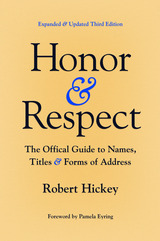 Honor and Respect: The Official Guide to Names, Titles, and Forms of Address
Robert Hickey
University of Chicago Press, 2023 From addressing letters to local officials to sending formal invitations to foreign chiefs of state, this complete guide provides the correct usage of names, titles, and forms of address for anyone on any occasion.
For any personal or professional situation where formality is of the essence and proper decorum is the expectation, this book offers critical information on how to address, introduce, and communicate with officials, functionaries, and dignitaries from all walks of life. From presidents to pastors, ambassadors to attorneys general to your local alderperson, Honor and Respect offers clear explanations and examples of the official honorifics of thousands of federal, state, and municipal officials; corporate executives; clergy; tribal officials; and members of the armed services in the United States, Australia, Canada, and the United Kingdom. It also includes titles and guidance on addressing high officials from more than 180 countries.
This updated third edition reflects the nuanced changes in language, protocol, and conventions that have been implemented by the State Department, Armed Forces, and myriad other government offices in the United States and beyond. With its all-encompassing scope and quick-reference format, Honor and Respect provides easy access for all who seek the proper protocols of forms of address. This book is an indispensable reference for individuals and offices working in government, foreign affairs, diplomacy, law, the military, training and consulting, and public relations, among others.
Honor and the American Dream: Culture and Identity in a Chicano Community
Horowitz, Ruth
Rutgers University Press, 1983 Thirty-second Street in Chicago. A Chicano community, peaceful on a warm summer night, residents socializing, children playing--and gang warfare ready to explode at any time. Ruth Horowitz takes us to the heart of this world, one characterized by opposing sets of values. On the one hand, residents believe in hard work, education, family ties, and the American dream of success. On the other hand, gang members are preoccupied with fighting to maintain their personal and family honor. Horowitz gives us an inside look at this world, showing us how the juxtaposition of two worlds--the streets and the social ladder--and two cultures, Mexican and American, constantly challenges the residents of the community.
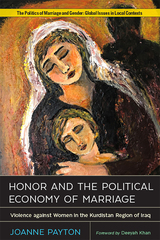 Honor and the Political Economy of Marriage: Violence against Women in the Kurdistan Region of Iraq
Joanne Payton
Rutgers University Press, 2020 'Honor' is used as a justification for violence perpetrated against women and girls considered to have violated social taboos related to sexual behavior. Several ‘honor’-based murders of Kurdish women, such as Fadime Sahindal, Banaz Mahmod and Du’a Khalil Aswad, and campaigns against 'honor'-based violence by Kurdish feminists have drawn international attention to this phenomenon within Kurdish communities.
Honor and the Political Economy of Marriage provides a description of ‘honor’-based violence that focuses upon the structure of the family rather than the perpetrator’s culture. The author, Joanne Payton, argues that within societies primarily organized by familial and marital connections, women’s ‘honor’ is a form of symbolic capital within a ‘political economy’ in which marriage organizes intergroup connections.
Drawing on statistical analysis of original data contextualized with historical and anthropological readings, Payton explores forms of marriage and their relationship to ‘honor’, sketching changing norms around the familial control of women from agrarian/pastoral roots to the contemporary era.
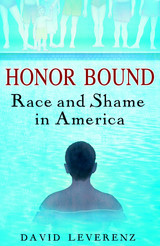 Honor Bound: Race and Shame in America
Leverenz, David
Rutgers University Press, 2012 As Bill Clinton said in his second inaugural address, “The divide of race has been America’s constant curse.” In Honor Bound, David Leverenz explores the past to the present of that divide. He argues that in the United States, the rise and decline of white people’s racial shaming reflect the rise and decline of white honor. “White skin” and “black skin” are fictions of honor and shame. Americans have lived those fictions for over four hundred years. To make his argument, Leverenz casts an unusually wide net, from ancient and modern cultures of honor to social, political, and military history to American literature and popular culture. He highlights the convergence of whiteness and honor in the United States from the antebellum period to the present. The Civil War, the civil rights movement, and the election of Barack Obama represent racial progress; the Tea Party movement represents the latest recoil. From exploring African American narratives to examining a 2009 episode of Hardball—in which two white commentators restore their honor by mocking U.S. Attorney General Eric Holder after he called Americans “cowards” for not talking more about race—Leverenz illustrates how white honor has prompted racial shaming and humiliation. The United States became a nation-state in which light-skinned people declared themselves white. The fear masked by white honor surfaces in such classics of American literature as The Scarlet Letter and Adventures of Huckleberry Finn and in the U.S. wars against the Barbary pirates from 1783 to 1815 and the Iraqi insurgents from 2003 to the present. John McCain’s Faith of My Fathers is used to frame the 2008 presidential campaign as white honor’s last national stand. Honor Bound concludes by probing the endless attempts in 2009 and 2010 to preserve white honor through racial shaming, from the “birthers” and Tea Party protests to Joe Wilson’s “You lie!” in Congress and the arrest of Henry Louis Gates Jr. at the front door of his own home. Leverenz is optimistic that, in the twenty-first century, racial shaming is itself becoming shameful.
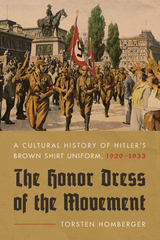 The Honor Dress of the Movement: A Cultural History of Hitler’s Brown Shirt Uniform, 1920–1933
Torsten Homberger
University of Massachusetts Press, 2021 During the era of the Weimar Republic, Germany was characterized by deep contradictions and polarizations. New, progressive social mores and artistic developments mixed uneasily with growing reactionary politics. When the 1929 stock market crash produced a severe economic shock, voters began to shift their allegiances from the parties of the center to radicals on both the left and the right. By 1933, amidst crisis and chaos, the Nazis had taken over.
In The Honor Dress of the Movement, Torsten Homberger contends that the brown-shirted Stormtrooper uniform was central to Hitler's rise to power. By analyzing its design and marketing, he investigates how Nazi leaders used it to project a distinct political and military persona that was simultaneously violent and orderly, retrograde and modern—a dual image that proved popular with the German people and was key to the Nazis' political success. Based on a wealth of sources that includes literature, films, and newspapers of the era, Homberger exhibits how the Nazis shaped and used material culture to destroy democracy.
 The Honor Plays of Lope de Vega
Donald R. Larson
Harvard University Press, 1977 One of the hallmarks of the classical Spanish theater is a vengeful conception of personal honor. This view, to some extent characteristic of Spanish life and thinking of the time, finds its fullest expression in those dramas called “honor plays.” In this study Donald R. Larson analyzes the honor plays of Lope de Vega, stellar playwright of Spain's Golden Age, and demonstrates in the course of them a consistent line of dramatic development.
Representative works have been selected from each of the three categories into which Lope's plays are customarily grouped—the early plays, those of the middle period, and the late plays. Larson's approach to the comedias is both critical and historical; it allows him to chart the evolution of the group as a whole, while providing significant new insights into the individual works. In the words of Bruce W. Wardropper, he gives us “a rare opportunity to follow one of the multiple threads through the Lopean labyrinth.”
As Lope is one of the giants of European literature and ought to be of interest to all students of the drama, the book contains complete English translations of passages quoted in the original Spanish.
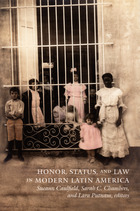 Honor, Status, and Law in Modern Latin America
Sueann Caulfield, Sarah C. Chambers, and Lara Putnam, eds.
Duke University Press, 2005 This collection brings together recent scholarship that examines how understandings of honor changed in Latin America between political independence in the early nineteenth century and the rise of nationalist challenges to liberalism in the 1930s. These rich historical case studies reveal the uneven processes through which ideas of honor and status came to depend more on achievements such as education and employment and less on the birthright privileges that were the mainstays of honor during the colonial period. Whether considering court battles over lost virginity or police conflicts with prostitutes, vagrants, and the poor over public decorum, the contributors illuminate shifting ideas about public and private spheres, changing conceptions of race, the growing intervention of the state in defining and arbitrating individual reputations, and the enduring role of patriarchy in apportioning both honor and legal rights. Each essay examines honor in the context of specific historical processes, including early republican nation-building in Peru; the transformation in Mexican villages of the cargo system, by which men rose in rank through service to the community; the abolition of slavery in Rio de Janeiro; the growth of local commerce and shifts in women’s status in highland Bolivia; the formation of a multiethnic society on Costa Rica’s Caribbean coast; and the development of nationalist cultural responses to U.S. colonialism in Puerto Rico. By connecting liberal projects that aimed to modernize law and society with popular understandings of honor and status, this volume sheds new light on broad changes and continuities in Latin America over the course of the long nineteenth century. Contributors. José Amador de Jesus, Rossana Barragán, Sueann Caulfield, Sidney Chalhoub, Sarah C. Chambers, Eileen J. Findley, Brodwyn Fischer, Olívia Maria Gomes da Cunha, Laura Gotkowitz, Keila Grinberg, Peter Guardino, Cristiana Schettini Pereira, Lara Elizabeth Putnam
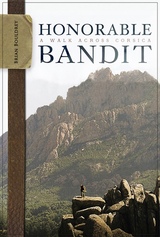 Honorable Bandit: A Walk across Corsica
Brian Bouldrey
University of Wisconsin Press, 2007
Brian Bouldrey traveled to the island of Corsica, with its wine-dark Mediterranean waters, powdered-sugar beach sand, sumptuous cuisine, and fine wine. And then he walked away from all of them.
Bouldrey strapped on a backpack and walked across Napoleon's native land with the same spirit many choose to dance or drink: to celebrate, to mourn, to think, to avoid thinking, to recall, to ignore, to escape, and to arrive.
This wonderfully textured account of a two-week ramble along a famous Corsican hiking trail with his German friend Petra (she was good at the downhills while he was better at the uphills) offers readers a journal that is a launching point for reflection: thoughts on cultural differences, friendship, physical challenge, personal challenge, and getting very, very lost. Part travelogue, part memoir, and part lampoon, this book offers readers an impressionistic view of a little talked about yet stunningly beautiful landscape.
Best Books for General Audiences, selected by the American Association of School Librarians and the Public Library Association
Runner-up, Best Travel Book, National Association of Travel Journalists
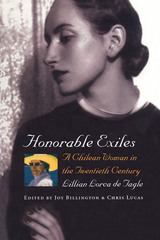 Honorable Exiles: A Chilean Woman in the Twentieth Century
By Lillian Lorca de Tagle
University of Texas Press, 2000 Lillian Lorca de Tagle is living proof of women's progress in the twentieth century. Born into a privileged, yet circumscribed world in 1914 as the daughter of a wealthy Chilean diplomat, she became a translator and journalist at a time when few women of her class held jobs. Ordered into exile in the United States by her disapproving mother, she became a successful reporter, translator, and editor, while raising two daughters as a single working mother. In this beautifully written memoir, de Tagle looks back over a fascinating, cosmopolitan life. She describes how her upbringing in various European capitals prepared her for a life of continual change. She remembers the restrictions that upper class Chilean society placed on women and how these ultimately propelled her to a career in the United States that included an editorship at Américas magazine and work for the State Department, as well as a series of posts with the USIA/Voice of America. Woven throughout her memoir are vivid glimpses of family, friends, husbands, and lovers, including the artist Roberto Matta. This spicy blend of personalities, work, and culture tells a quintessential coming-of-age story of a thoroughly modern woman.
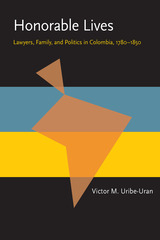 Honorable Lives: Lawyers, Family, and Politics in Colombia, 1780–1850
Victor M. Uribe-Uran
University of Pittsburgh Press, 2000 The first work in English to discuss the social and political history of lawyers in a Latin American country, Honorable Lives presents a portrait of lawyers in late colonial and early modern Colombia. Uribe-Uran focuses on the social origins, education, and careers of those qualified to practice law before the highest colonial courts—Audiencias—and the republican courts after the 1820s. In the course of his study, Uribe-Uran answers many questions about this elite group of professionals. What were the social origins and families of lawyers? Their relation to the state? Their participation in political movements and parties, revolutions, civil wars, and other political processes? Their ideas, education, and training? By exploring the lives of lawyers, Uribe-Uran is also able to present a general history of Latin America while examining the key social and political changes and continuities from 1780 to 1850—particularly the elites and state managers.
Honorable Lives features three genealogical charts detailing bureaucratic networks established by families of lawyers in different historical periods. The text also contains an abundant series of statistical tables and charts, and concise biographical information on approximately 150 Latin American lawyers. This book will appeal to Latin Americanists, students of law, and anyone interested in the lives and histories of lawyers.
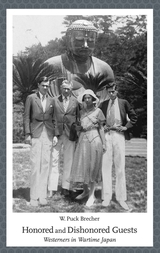 Honored and Dishonored Guests: Westerners in Wartime Japan
W. Puck Brecher
Harvard University Press, 2017 The brutality and racial hatred exhibited by Japan’s military during the Pacific War piqued outrage in the West and fanned resentments throughout Asia. Public understanding of Japan’s wartime atrocities, however, often fails to differentiate the racial agendas of its military and government elites from the racial values held by the Japanese people. While not denying brutalities committed by the Japanese military, Honored and Dishonored Guests overturns these standard narratives and demonstrates rather that Japan’s racial attitudes during wartime are more accurately discerned in the treatment of Western civilians living in Japan than the experiences of enemy POWs.
The book chronicles Western communities in wartime Japan, using this body of experiences to reconsider allegations of Japanese racism and racial hatred. Its bold thesis is borne out by a broad mosaic of stories from dozens of foreign families and individuals who variously endured police harassment, suspicion, relocation, starvation, denaturalization, internment, and torture, as well as extraordinary acts of charity. The book’s account of stranded Westerners—from Tokyo, Yokohama, and Kobe to the mountain resorts of Karuizawa and Hakone—yields a unique interpretation of race relations and wartime life in Japan.
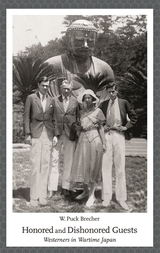 Honored and Dishonored Guests: Westerners in Wartime Japan
W. Puck Brecher
Harvard University Press The brutality and racial hatred exhibited by Japan’s military during the Pacific War piqued outrage in the West and fanned resentments throughout Asia. Public understanding of Japan’s wartime atrocities, however, often fails to differentiate the racial agendas of its military and government elites from the racial values held by the Japanese people. While not denying brutalities committed by the Japanese military, Honored and Dishonored Guests overturns these standard narratives and demonstrates rather that Japan’s racial attitudes during wartime are more accurately discerned in the treatment of Western civilians living in Japan than the experiences of enemy POWs.
The book chronicles Western communities in wartime Japan, using this body of experiences to reconsider allegations of Japanese racism and racial hatred. Its bold thesis is borne out by a broad mosaic of stories from dozens of foreign families and individuals who variously endured police harassment, suspicion, relocation, starvation, denaturalization, internment, and torture, as well as extraordinary acts of charity. The book’s account of stranded Westerners—from Tokyo, Yokohama, and Kobe to the mountain resorts of Karuizawa and Hakone—yields a unique interpretation of race relations and wartime life in Japan.
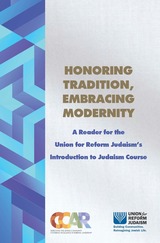 Honoring Tradition, Embracing Modernity: A Reader for the Union for Reform Judaism's Introduction to Judaism Course
Rabbi Beth Lieberman
Central Conference of American Rabbis, 2017 Honoring Tradition, Embracing Modernity, created in partnership between the Central Conference of American Rabbis and the Union for Reform Judaism, is for readers who seek to deepen their knowledge of Judaism--its wisdom, its practices, its beliefs, its customs, its people, and our story. This sourcebook includes selections from Judaism's rich library of wisdom literature, classic and contemporary, in a format designed for use with the URJ's Introduction to Judaism classes. Honoring Tradition, Embracing Modernity includes five units, as listed below: - Beginnings: What is Judaism? What are the ethics and values of the Jewish People? How can we understand humanity and human potential through our relationship to God? - Creating a Jewish Life in Time: An exploration of the Jewish calendar of celebration and sanctity, as well as how life in the community connects and intertwines with life at home. - The Cycle of Jewish Life: Relationship and marriage traditions, raising a family, growing into later adulthood, and the central role of learning for all generations. - Creating a Jewish Theology: Different understandings of God, and the diverse roles that synagogue, prayer, and sacred texts play in our lives. - The Jewish Story and Creating a Jewish Journey: The historical journey of the Jewish People, and the many identities that have emerged from it. URJ Introduction to Judaism course outlines and other supporting curricular materials are available to download in the "Introduction to Judaism Faculty" private group in the Tent, URJ's online collaboration platform. View and download one of the courses below: URJ Introduction to Judaism 18 Session Course Outline for Faculty
 Honus Wagner: A Biography
Dennis Devaleria
University of Pittsburgh Press, 1998 With the coming of the twentieth century, America was thinking on a grand scale. Barriers of communication and transportation were being overcome and giants such as Andrew Carnegie, John D. Rockefeller, and William Randolph Hearst walked the land. The nation’s game was baseball, and its giant was Honus Wagner. In 1996, a baseball card depicting Honus Wagner sold for $640,500 - the largest sum ever paid at auction for a sports artifact. What could possibly make that piece of cardboard, approximately one-and-a-half by two-and-a-half inches, worth more than half a million dollars? The DeValerias tell the unique story behind this now-famous baseball card and the man depicted on it. In doing so, they accurately present the local, regional, and national context so readers gain a thorough understanding of Wagner’s times.Wagner’s gradual emergence from the pack into stardom and popularity is described here in rich detail, but the book also reveals much of Wagner’s family and personal life - his minor leauge career, his values, his failed business ventures during the Depression, and his later years. Neither the “rowdy-ball” ruffian nor the teetotal saint constructed of legend, Wagner is presented here in a complete portrait - one that offers a vivid impression of the era when baseball was America’s game and the nation was evolving into the world’s industrial leader.
Hooded Americanism: The History of the Ku Klux Klan
David M. Chalmers
Duke University Press, 1987 "The only work that treats Ku Kluxism for the entire period of it's existence . . . the authoritative work on the period. Hooded Americanism is exhaustive in its rich detail and its use of primary materials to paint the picture of a century of terror. It is comprehensive, since it treats the entire period, and enjoys the perspective that the long view provides. It is timely, since it emphasizes the undeniable persistence of terrorism in American life."—John Hope Franklin
Hoodlum Movies: Seriality and the Outlaw Biker Film Cycle, 1966-1972
Stanfield, Peter
Rutgers University Press, 2018 From The Wild Angels in 1966 until its conclusion in 1972, the cycle of outlaw motorcycle films contained forty-odd formulaic examples. All but one were made by independent companies that specialized in producing exploitation movies for drive-ins, neighborhood theaters, and rundown inner city theaters. Despised by critics, but welcomed by exhibitors denied first-run films, these cheaply and quickly produced movies were made to appeal to audiences of mobile youths. The films are repetitive, formulaic, and eminently forgettable, but there is a story to tell about all of the above, and it is one worth hearing. Hoodlum Movies is not only about the films, its focus is on why and how these films were made, who they were made for, and how the cycle developed through the second half of the 1960s and came to a shuddering halt in 1972.
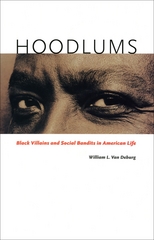 Hoodlums: Black Villains and Social Bandits in American Life
William L. Van Deburg
University of Chicago Press, 2004 Martin Luther King Jr. Malcolm X. Muhammad Ali. When you think of African American history, you think of its heroes—individuals endowed with courage and strength who are celebrated for their bold exploits and nobility of purpose. But what of black villains? Villains, just as much as heroes, have helped define the black experience.
Ranging from black slaveholders and frontier outlaws to serial killers and gangsta rappers, Hoodlums examines the pivotal role of black villains in American society and popular culture. Here, William L. Van Deburg offers the most extensive treatment to date of the black badman and the challenges that this figure has posed for race relations in America. He first explores the evolution of this problematic racial stereotype in the literature of the early Republic—documents in which the enslavement of African Americans was justified through exegetical claims. Van Deburg then probes antebellum slave laws, minstrel shows, and the works of proslavery polemicists to consider how whites conceptualized blacks as members of an inferior and dangerous race. Turning to key works by blacks themselves, from the writings of Frederick Douglass and W. E. B. Du Bois to classic blaxploitation films like Black Caesar and The Mack, Van Deburg demonstrates how African Americans have combated such negative stereotypes and reconceptualized the idea of the badman through stories of social bandits—controversial individuals vilified by whites for their proclivity toward evil, but revered in the black community as necessarily insurgent and revolutionary.
Ultimately, Van Deburg brings his story up-to-date with discussions of prison and hip-hop culture, urban rioting, gang warfare, and black-on-black crime. What results is a work of remarkable virtuosity—a nuanced history that calls for both whites and blacks to rethink received wisdom on the nature and prevalence of black villainy.
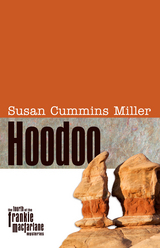 Hoodoo
Susan Cummins Miller
Texas Tech University Press, 2008 Southeastern Arizona is a tinderbox. Down Under Copper’s plans to explore for minerals pit landowners, worried about their water supply and land values, against those hoping to profit from the mining venture. Someone snaps.In the traditional homeland of the Chiricahua Apaches, an environmental lawyer’s body lies in the burned wreckage of his trailer. As if in retaliation, a DUC executive is shot. Geologist Frankie MacFarlane, her students, and Joaquin Black, an old friend and local rancher, find the executive’s body in a clearing among the volcanic hoodoos of Chiricahua National Monument. And that night, near Paradise, on the eastern side of the mountain range, someone kills an ethnobotanist—a walker and puzzle maker who hasn’t spoken in years.When Frankie, Joaquin, and Joaquin’s brother Raul become suspects in the murders, Frankie must decipher interlocking puzzles to clear their names and to find the killer—or killers—before they strike again. In the process, she discovers that, contrary to geologic principles, the past is the key to the present.Miller weaves together geoscience, Western history and culture, ecology, family, and place into a compelling puzzle mystery narrated in Frankie MacFarlane’s unique voice.
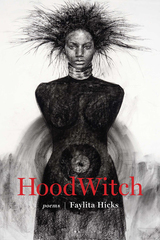 HoodWitch
Faylita Hicks
Acre Books, 2019 This riveting debut from poet Faylita Hicks is a reclamation of power for black women and nonbinary people whose bodies have become the very weapons used against them. HoodWitch tells the story of a young person who discovers that they are “something that can & will survive / a whole century of hunt.” Through a series of poems based on childhood photographs, Hicks invokes the spirits of mothers and daughters, sex workers and widows, to conjure an alternative to their own early deaths and the deaths of those whom they have already lost.
In this collection about resilience, Hicks speaks about giving her child up for adoption, mourning the death of her fiancé, and embracing the nonbinary femme body—persevering in the face of medical malpractice, domestic abuse, and police violence. The poems find people transformed, “remade out of smoke & iron” into cyborgs and wolves, machines and witches—beings capable of seeking justice in a world that refuses them the option.
Exploring the intersections of Christianity, modern mysticism, and Afrofuturism in a sometimes urban, sometimes natural setting, Hicks finds a place where “everyone everywhere is hands in the air,” where “you know they gonna push & pull it together. / Just like they learned to.” It is a place of natural magick—where someone like Hicks can have more than one name: where they can be both dead and alive, both a mortal and a god.
 Hooked: Art and Attachment
Rita Felski
University of Chicago Press, 2020 A powerful challenge to the dominant ethos of critical aloofness in literary studies
How does a novel entice or enlist us? How does a song surprise or seduce us? Why do we bristle when a friend belittles a book we love, or fall into a funk when a favored TV series comes to an end? What characterizes the aesthetic experiences of feeling captivated by works of art? In Hooked, Rita Felski challenges the ethos of critical aloofness that is a part of modern intellectuals’ self-image. The result is sure to be as widely read as Felski’s book, The Limits of Critique.
Wresting the language of affinity away from accusations of sticky sentiment and manipulative marketing, Felski argues that “being hooked” is as fundamental to the appreciation of high art as to the enjoyment of popular culture. Hooked zeroes in on three attachment devices that connect audiences to works of art: identification, attunement, and interpretation. Drawing on examples from literature, film, music, and painting—from Joni Mitchell to Matisse, from Thomas Bernhard to Thelma and Louise—Felski brings the language of attachment into the academy. Hooked returns us to the fundamentals of aesthetic experience, showing that the social meanings of artworks are generated not just by critics, but also by the responses of captivated audiences.
 Hooked: Art and Attachment
Rita Felski
University of Chicago Press, 2020 This is an auto-narrated audiobook edition of this book. How does a novel entice or enlist us? How does a song surprise or seduce us? Why do we bristle when a friend belittles a book we love, or fall into a funk when a favored TV series comes to an end? What characterizes the aesthetic experiences of feeling captivated by works of art? In Hooked, Rita Felski challenges the ethos of critical aloofness that is a part of modern intellectuals’ self-image. The result is sure to be as widely read as Felski’s book, The Limits of Critique.
Wresting the language of affinity away from accusations of sticky sentiment and manipulative marketing, Felski argues that “being hooked” is as fundamental to the appreciation of high art as to the enjoyment of popular culture. Hooked zeroes in on three attachment devices that connect audiences to works of art: identification, attunement, and interpretation. Drawing on examples from literature, film, music, and painting—from Joni Mitchell to Matisse, from Thomas Bernhard to Thelma and Louise—Felski brings the language of attachment into the academy. Hooked returns us to the fundamentals of aesthetic experience, showing that the social meanings of artworks are generated not just by critics, but also by the responses of captivated audiences.
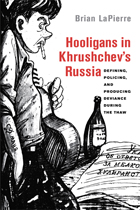 Hooligans in Khrushchev's Russia: Defining, Policing, and Producing Deviance during the Thaw
Brian LaPierre
University of Wisconsin Press, 2012 Swearing, drunkenness, promiscuity, playing loud music, brawling—in the Soviet Union these were not merely bad behavior, they were all forms of the crime of "hooliganism." Defined as "rudely violating public order and expressing clear disrespect for society," hooliganism was one of the most common and confusing crimes in the world's first socialist state. Under its shifting, ambiguous, and elastic terms, millions of Soviet citizens were arrested and incarcerated for periods ranging from three days to five years and for everything from swearing at a wife to stabbing a complete stranger.
Hooligans in Khrushchev's Russia offers the first comprehensive study of how Soviet police, prosecutors, judges, and ordinary citizens during the Khrushchev era (1953–64) understood, fought against, or embraced this catch-all category of criminality. Using a wide range of newly opened archival sources, it portrays the Khrushchev period—usually considered as a time of liberalizing reform and reduced repression—as an era of renewed harassment against a wide range of state-defined undesirables and as a time when policing and persecution were expanded to encompass the mundane aspects of everyday life. In an atmosphere of Cold War competition, foreign cultural penetration, and transatlantic anxiety over "rebels without a cause," hooliganism emerged as a vital tool that post-Stalinist elites used to civilize their uncultured working class, confirm their embattled cultural ideals, and create the right-thinking and right-acting socialist society of their dreams.
 Hoop Crazy: The Lives of Clair Bee and Chip Hilton
Dennis Gildea
University of Arkansas Press, 2013 Clair Bee (1896-1983) was a hugely successful basketball coach at Rider College and Long Island University with a 412 and 87 record before his career was derailed in 1951 by a point-shaving scandal. In the trial that sent his star player, Sherman White, to prison, the judge excoriated Bee for creating a morally lax culture that contributed to his players' involvement with gambling. To a certain extent, Bee agreed with the judge's scolding, concluding that coaches, himself included, had become so driven to succeed on the court that they had lost sight of the educational role sports should play. His coaching career effectively over, Bee launched an effort to reform the ills he saw in college sports, and he did so in the pages of the Chip Hilton novels for young readers. He began the series in 1948, but it was the post-scandal books that he used as teaching tools. The books mirrored some of the events of the gambling scandal and were Bee's attempt to reform the problems plaguing college sports. He used his fiction to posit a better sports world that he hoped his young readers would construct and inhabit. The Chip Hilton books were extremely popular and have become a classic series, with over two million copies sold to date. Hoop Crazy is the fascinating story of Clair Bee and his star character Chip Hilton and the ways in which their lives, real and fictional, were intertwined.
Hoosier Public Enemy: A Life of John Dillinger
John Beineke
Indiana Historical Society Press, 2014 During the bleak days of the Great Depression, news of economic hardship often took a backseat to articles on the exploits of an outlaw from Indiana—John Dillinger. For a period of fourteen months during 1933 and 1934 Dillinger became the most famous bandit in American history, and no criminal since has matched him for his celebrity and notoriety.
Dillinger won public attention not only for his robberies, but his many escapes from the law. The escapes he made from jails or “tight spots,” when it seemed law officials had him cornered, became the stuff of legends. While the public would never admit that they wanted the “bad guy” to win, many could not help but root for the man who appeared to be an underdog.
Although his crime wave took place in the last century, the name Dillinger has never left the public imagination
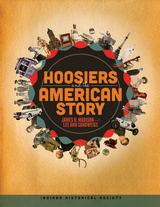 Hoosiers and the American Story
James H. Madison and Lee Ann Sandweiss
Indiana Historical Society Press, 2014 A supplemental textbook for middle and high school students, Hoosiers and the American Story provides intimate views of individuals and places in Indiana set within themes from American history. During the frontier days when Americans battled with and exiled native peoples from the East, Indiana was on the leading edge of America’s westward expansion. As waves of immigrants swept across the Appalachians and eastern waterways, Indiana became established as both a crossroads and as a vital part of Middle America. Indiana’s stories illuminate the history of American agriculture, wars, industrialization, ethnic conflicts, technological improvements, political battles, transportation networks, economic shifts, social welfare initiatives, and more. In so doing, they elucidate large national issues so that students can relate personally to the ideas and events that comprise American history. At the same time, the stories shed light on what it means to be a Hoosier, today and in the past.
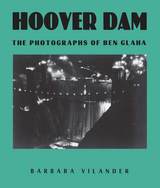 Hoover Dam: The Photographs of Ben Glaha
Barbara Vilander
University of Arizona Press, 1999 Hoover Dam was constructed during one of the most depressed economic climates in American history, in a remote desert canyon where temperatures ranged from single to triple digits. In order to visually document the project, the Bureau of Reclamation assigned employee Ben Glaha to photograph all aspects of the dam's construction. Glaha's photographs were used in press releases, periodicals, books, pamphlets, and slide shows to demonstrate that the dam was structurally sound and that government funds were being used wisely.
Hoover Dam: The Photographs of Ben Glaha is the first detailed examination of Glaha's images of the project, some of which have never before been published. Glaha photographed every aspect of the construction process—from details of how the dam was assembled to the overall progress as the dam rose from the bottom of the dry riverbed. Glaha not only provided the Bureau with the photographs it required, he also employed his own artistic abilities to produce images of the dam that were exhibited in museums and galleries as works of art. Because Glaha was able to create a selection of Hoover Dam photographs worthy of exhibition, he was unique among government documentary photographers.
Art historian Barbara Vilander's text places Glaha's efforts within the historical context of western landscape exploration and development and reveals how his particular qualifications led to his selection as the project photographer. Vilander then examines the many publications and venues in which the Bureau used Glaha's photographs to create support for the project. She also discusses how Glaha was recognized in his own era as an influential artist and teacher, and compares his work with that of other contemporary landscape photographers addressing western water management.
Glaha's Hoover Dam images were widely published, although in accordance with Bureau policy he was not usually given personal credit and therefore his name remains largely unknown. Vilander's book corrects that oversight by giving Glaha the technical and artistic credit he is due within the context of one of the most ambitious projects in American history.
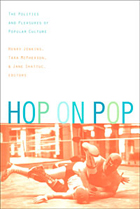 Hop on Pop: The Politics and Pleasures of Popular Culture
Henry Jenkins, Tara McPherson and Jane Shattuc, eds.
Duke University Press, 2003 Hop on Pop showcases the work of a new generation of scholars—from fields such as media studies, literature, cinema, and cultural studies—whose writing has been informed by their ongoing involvement with popular culture and who draw insight from their lived experiences as critics, fans, and consumers. Proceeding from their deep political commitment to a new kind of populist grassroots politics, these writers challenge old modes of studying the everyday. As they rework traditional scholarly language, they search for new ways to write about our complex and compelling engagements with the politics and pleasures of popular culture and sketch a new and lively vocabulary for the field of cultural studies. The essays cover a wide and colorful array of subjects including pro wrestling, the computer games Myst and Doom, soap operas, baseball card collecting, the Tour de France, karaoke, lesbian desire in the Wizard of Oz, Internet fandom for the series Babylon 5, and the stress-management industry. Broader themes examined include the origins of popular culture, the aesthetics and politics of performance, and the social and cultural processes by which objects and practices are deemed tasteful or tasteless. The commitment that binds the contributors is to an emergent perspective in cultural studies, one that engages with popular culture as the culture that "sticks to the skin," that becomes so much a part of us that it becomes increasingly difficult to examine it from a distance. By refusing to deny or rationalize their own often contradictory identifications with popular culture, the contributors ensure that the volume as a whole reflects the immediacy and vibrancy of its objects of study. Hop on Pop will appeal to those engaged in the study of popular culture, American studies, cultural studies, cinema and visual studies, as well as to the general educated reader. Contributors. John Bloom, Gerry Bloustein, Aniko Bodroghkozy, Diane Brooks, Peter Chvany, Elana Crane, Alexander Doty, Rob Drew, Stephen Duncombe, Nick Evans, Eric Freedman, Joy Fuqua, Tony Grajeda, Katherine Green, John Hartley, Heather Hendershot, Henry Jenkins, Eithne Johnson, Louis Kaplan, Maria Koundoura, Sharon Mazer, Anna McCarthy, Tara McPherson, Angela Ndalianis, Edward O’Neill, Catherine Palmer, Roberta Pearson, Elayne Rapping, Eric Schaefer, Jane Shattuc, Greg Smith, Ellen Strain, Matthew Tinkhom, William Uricchio, Amy Villarego, Robyn Warhol, Charles Weigl, Alan Wexelblat, Pamela Robertson Wojcik, Nabeel Zuberi
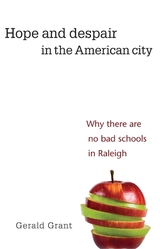 Hope and Despair in the American City: Why There Are No Bad Schools in Raleigh
Gerald Grant
Harvard University Press, 2011 In 1972, the U.S. Supreme Court handed down a 5–4 verdict in Milliken v. Bradley, thereby blocking the state of Michigan from merging the Detroit public school system with those of the surrounding suburbs. This decision effectively walled off underprivileged students in many American cities, condemning them to a system of racial and class segregation and destroying their chances of obtaining a decent education.In Hope and Despair in the American City, Gerald Grant compares two cities—his hometown of Syracuse, New York, and Raleigh, North Carolina—in order to examine the consequences of the nation’s ongoing educational inequities. The school system in Syracuse is a slough of despair, the one in Raleigh a beacon of hope. Grant argues that the chief reason for Raleigh’s educational success is the integration by social class that occurred when the city voluntarily merged with the surrounding suburbs in 1976 to create the Wake County Public School System. By contrast, the primary cause of Syracuse’s decline has been the growing class and racial segregation of its metropolitan schools, which has left the city mired in poverty.Hope and Despair in the American City is a compelling study of urban social policy that combines field research and historical narrative in lucid and engaging prose. The result is an ambitious portrait—sometimes disturbing, often inspiring—of two cities that exemplify our nation’s greatest educational challenges, as well as a passionate exploration of the potential for school reform that exists for our urban schools today.
Hope And Dread In Montana Literature
Ken Egan
University of Nevada Press, 2003 This literary survey from a third-generation Montanan includes a thoughtful discussion on the now infamous events of the mid- to late-nineties. The rich literary tradition of Montana, contends author Ken Egan Jr., reflects a catastrophic vision of the West that shows the "horrors of domination" and "the foolish and destructive habits of the imperial heart." Since the 1860s, Montana’s writers have depicted struggles for survival in the state’s dramatic landscape, and for decency in a region characterized by the headlong exploitation of both natural and human resources.
 Hope and Folly: The United States and UNESCO, 1945-1985
William Preston Jr., Edward S. Herman, and Herbert I. SchillerIntroduction by Ellen Ray and William H. SchappSean MacBride
University of Minnesota Press, 1989 Hope and Folly was first published in 1989. Minnesota Archive Editions uses digital technology to make long-unavailable books once again accessible, and are published unaltered from the original University of Minnesota Press editions. Created in a burst of idealism after World War II, the United Nations Educational, Scientific, and Cultural Organization (UNESCO) existed for forty years in a state of troubled yet often successful collaboration with one of its founders and benefactors, the United States. In 1980, UNESCO adopted the report of a commission that surveyed and criticized the dominance, in world media, of the United States, Japan, and a handful of European countries. The report also provided the conceptual underpinnings for what was later called the New World Information and Communication Order, a general direction adopted by UNESCO to encourage increased Third World participation in world media. This direction - it never became an official program - ultimately led to the United States's withdrawal from UNESCO in 1984. Hope and Folly is an interpretive chronicle of U.S./ UNESCO relations. Although the information debated has garnered wide attention in Europe and the Third World, there is no comparable study in the English language, and none that focuses specifically on the United States and the broad historical context of the debate. In the first three parts, William Preston covers the changing U.S./ UNESCO relationship from the early cold war years through the period of anti-UNESCO backlash, as well as the politics of the withdrawal. Edward Herman's section is an interpretive critique of American media coverage of the withdrawal, and Herbert Schiller's is a conceptual analysis of conflicts within the United States's information policies during its last years in UNESCO. The book's appendices include an analysis of Ed Bradley's notorious "60 Minutes" broadcast on UNESCO.
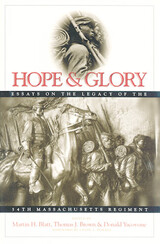 Hope and Glory: Essays on the Legacy of the 54th Massachusetts Regiment
Martin H. Blatt
University of Massachusetts Press, 2009 The monument by Augustus Saint-Gaudens to Robert Gould Shaw and the 54th Massachusetts Regiment, located on Boston Common, stands at a symbolic crossroads of American history. A reminder of the nation's ongoing struggle over race, it captures the Civil War's higher purpose—the end of slavery—and memorializes those black soldiers and white officers who made common cause in the service of freedom. The monument and the saga of the 54 th Massachusetts remain powerful touchstones, inspiring enduring meditations such as Robert Lowell's poem "For the Union Dead" and the popular film Glory.
This volume brings together the best scholarship on the history of the 54th, the formation of collective memory and identity, and the ways Americans have responded to the story of the regiment and the Saint-Gaudens monument. Contributors use the historical record and popular remembrance of the 54 th as a lens for examining race and community in the United States. The essays range in time from the mid-nineteenth century to the present and encompass history, literature, art, music, and popular culture.
In addition to the editors and Colin Powell, who writes about the memory and example of the 54th in his own career, contributors include Stephen Belyea, David W. Blight, Thomas Cripps, Kathryn Greenthal, James Oliver Horton, Edwin S. Redkey, Marilyn Richardson, Kirk Savage, James Smethurst, Cathy Stanton, Helen Vendler, Denise Von Glahn, and Joan Waugh.
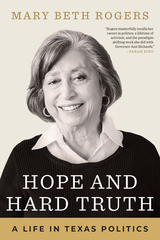 Hope and Hard Truth: A Life in Texas Politics
Mary Beth Rogers
University of Texas Press, 2022 Mary Beth Rogers has led an eventful life rooted in the weeds of Texas politics, occasionally savoring a few victories—particularly the 1990 governor’s race when, as campaign manager for Ann Richards, she did the impossible and put a Democratic woman in office. She also learned to absorb her losses—after all, she was a liberal feminist in America’s most aggressively conservative state. Rogers’s road to a political life was complex. Candidly and vulnerably, she shares both public and private memories of how she tried to maintain a rich family life with growing children and a husband with a debilitating illness. She goes on to provide an insider’s account of her experiences as Richards’s first chief of staff while weaving her way through the highs and lows of political intrigue and legislative maneuvering. Reflecting on her family heritage and nascent spiritual quest, Rogers discovers a reality at once sobering and invigorating: nothing is ever completely lost or completely won. It is a constant struggle to create humane public policies built on a foundation of fairness and justice—particularly in her beloved Texas.
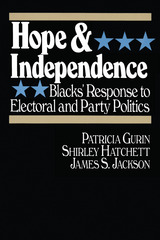 Hope and Independence: Blacks' Response to Electoral and Party Politics
Patricia Gurin
Russell Sage Foundation, 1989 Over the past fifteen years, a New Black Politics has swept black candidates into office and registered black voters in numbers unimaginable since the days of Reconstruction. Based on interviews with a representative sample of nearly 1,000 voting-age black Americans, Hope and Independence explores blacks' attitudes toward electoral and party politics and toward Jesse Jackson's first presidential bid. Viewed in the light of black political history, the survey reveals enduring themes of hope (for eventual inclusion in traditional politics, despite repeated disappointments) and independence (a strategy of operating outside conventional political institutions in order to achieve incorporation). The authors describe a black electorate that is less alienated than many have suggested. Blacks are more politically engaged than whites with comparable levels of education. And despite growing economic inequality in the black community, the authors find no serious class-based political cleavage. Underlying the widespread support for Jackson among blacks, a distinction emerges between "common fate" solidarity, which is pro-black, committed to internal criticism of the Democratic party, and conscious of commonality with other disadvantaged groups, and "exclusivist" solidarity, which is pro-black but also hostile to whites and less empathetic to other minorities. This second, more divisive type of solidarity expresses itself in the desire for a separate black party or a vote black strategy—but its proponents constitute a small minority of the black electorate and show surprisingly hopeful attitudes toward the Democratic party. Hope and Independence will be welcomed by readers concerned with opinion research, the sociology of race, and the psychology of group consciousness. By probing the attitudes of individual blacks in the context of a watershed campaign, this book also makes a vital contribution to our grasp of current electoral politics.
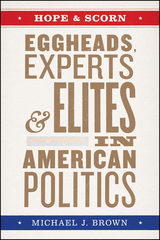 Hope and Scorn: Eggheads, Experts, and Elites in American Politics
Michael J. Brown
University of Chicago Press, 2020 Intellectuals “have been both rallying points and railed against in American politics, vessels of hope and targets of scorn,” writes Michael J. Brown as he invigorates a recurrent debate in American life: Are intellectual public figures essential voices of knowledge and wisdom, or out-of-touch elites? Hope and Scorn investigates the role of high-profile experts and thinkers in American life and their ever-fluctuating relationship with the political and public spheres. From Eisenhower’s era to Obama’s, the intellectual’s role in modern democracy has been up for debate. What makes an intellectual, and who can claim that privileged title? What are intellectuals’ obligations to society, and how, if at all, are their contributions compatible with democracy? For some, intellectuals were models of civic engagement. For others, the rise of the intellectual signaled the fall of the citizen. Carrying us through six key moments in this debate, Brown expertly untangles the shifting anxieties and aspirations for democracy in America in the second half of the twentieth century and beyond. Hope and Scorn begins with “egghead” politicians like Adlai Stevenson; profiles scholars like Richard Hofstadter and scholars-turned-politicians like H. Stuart Hughes; and ends with the rise of public intellectuals such as bell hooks and Cornel West. In clear and unburdened prose, Brown explicates issues of power, authority, political backlash, and more. Hope and Scorn is an essential guide to American concerns about intellectuals, their myriad shortcomings, and their formidable abilities.
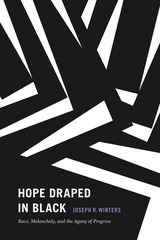 Hope Draped in Black: Race, Melancholy, and the Agony of Progress
Joseph R. Winters
Duke University Press, 2016 In Hope Draped in Black Joseph R. Winters responds to the enduring belief that America follows a constant trajectory of racial progress. Such notions—like those that suggested the passage into a postracial era following Barack Obama's election—gloss over the history of racial violence and oppression to create an imaginary and self-congratulatory world where painful memories are conveniently forgotten. In place of these narratives, Winters advocates for an idea of hope that is predicated on a continuous engagement with loss and melancholy. Signaling a heightened sensitivity to the suffering of others, melancholy disconcerts us and allows us to cut against dominant narratives and identities. Winters identifies a black literary and aesthetic tradition in the work of intellectuals, writers, and artists such as W. E. B. Du Bois, Ralph Ellison, Toni Morrison, and Charles Burnett that often underscores melancholy, remembrance, loss, and tragedy in ways that gesture toward such a conception of hope. Winters also draws on Walter Benjamin and Theodor Adorno to highlight how remembering and mourning the uncomfortable dimensions of American social life can provide alternate sources for hope and imagination that might lead to building a better world.
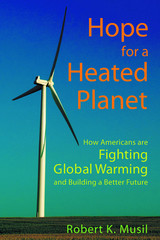 Hope for a Heated Planet: How Americans Are Fighting Global Warming and Building a Better Future
Musil, Robert K
Rutgers University Press, 2009 Rejecting cries of gloom and doom, Hope for a Heated Planet shows how the fight against global warming can be won by the grassroots efforts of individuals. Robert K. Musil, who led the Nobel Peace Prize-winning organization Physicians for Social Responsibility, explains that a growing new climate movement can produce unprecedented change-in the economy, public health, and home-while saving the planet. Musil draws on personal experience and compelling data in this practical and rigorous analysis of the causes and cures for global warming. The book presents all the players in the most pressing challenge facing society today, from the massive fossil fuel lobby to the enlightened corporations that are joining the movement to "go green." Musil thoroughly explains the tremendous potential of renewable energy sources-wind, solar, and biofuel-and the startling conclusions of experts who say society can do away entirely with fossil fuels. He tells readers about the engaged politicians, activists, religious groups, and students who are already working together against climate change. But the future depends, Musil insists, on what changes ordinary citizens make. Through personal choices and political engagement, he shows how readers can cut carbon emissions and create green communities where they live. With practical and realistic solutions, Hope for a Heated Planet inspires readers to be accountable and enables them to usher in an age of sustainability for future generations.
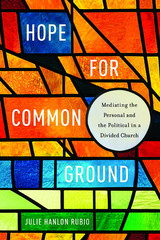 Hope for Common Ground: Mediating the Personal and the Political in a Divided Church
Julie Hanlon Rubio
Georgetown University Press Much like the rest of the country, American Catholics are politically divided, perhaps more so now than at any point in their history. In this learned but accessible work for scholars, students, and religious and lay readers, ethicist Julie Hanlon Rubio suggests that there is a way beyond red versus blue for orthodox and progressive Catholics. In a call for believers on both sides of the liberal-conservative divide to put aside labels and rhetoric, Rubio, a leading scholar in marriage and family for more than twenty years, demonstrates that common ground does exist in the local sphere between the personal and the political. In Hope for Common Ground, Rubio draws on Catholic Social Thought to explore ways to bring Catholics together. Despite their differences, Catholics across the political spectrum can share responsibility for social sin and work within communities to contribute to social progress. Rubio expands this common space into in-depth discussions on family fragility, poverty, abortion, and end-of-life care. These four issues, though divisive, are part of a seamless worldview that holds all human life as sacred. Rubio argues that if those on different sides focus on what can be done to solve social problems in “the space between” or local communities, opposing sides will see they are not so far apart as they think. The common ground thus created can then lead to far-reaching progress on even the most divisive issues—and help quiet the discord tearing apart the Church.
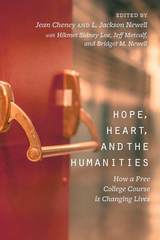 Hope, Heart, and the Humanities: How a Free College Course is Changing Lives
Jean Cheney and L. Jackson Newell, editors, with Hikmet Sidney Loe, Jeff Metcalf, and Bridget M. Newell
University of Utah Press, 2016 Hope, Heart, and the Humanities tells the story of how Venture, a free, interdisciplinary college humanities course inspired by the national Clemente Course, has helped open doors to improve the lives of people with low incomes who face barriers to attending college. For over a decade, this course has given hundreds of adults, some of them immigrants or refugees, the knowledge, confidence, and power to rechart their lives.
Readers will go inside Venture classrooms to see what occurs when adults enter serious discussions about literature, critical writing, art history, American history, and philosophy. Apparent also are the difficulties nontraditional students, who range in age from 18 to 60, often encounter in a college classroom and the hard choices they and their teachers make. What readers may remember most are the stories and words from people whose views of the world broaden and whose directions in life changed.
Interview with Tom Williams at Access Utah
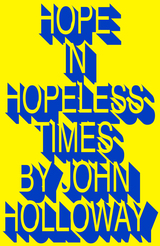 Hope in Hopeless Times
John Holloway
Pluto Press, 2022 In this final part of his ground-breaking trilogy, John Holloway expertly fuses anti-capitalism and anti-identitarianism, and brings hope into the critique of political economy and revolutionary theory, challenging us to find hope within ourselves and channel it into a dignified, revolutionary rage.
Hope lies in our richness, in the joy of our collective creativity. But that richness exists in the peculiar form of money. The fact that we relate to one another through money causes tremendous social pain and destruction and is dragging us through pandemics and war towards extinction.
Richness against money: this battle will decide the future of humanity. If we cannot emancipate richness from money-capital profit, there is probably no hope. Money seems invincible but the constant expansion of debt shows that its rule is fragile. The fictitious expansion of money through debt is driven by fear, fear of us, fear of the rabble. Money contains, but richness overflows.
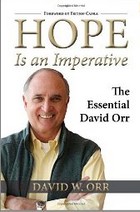 Hope Is an Imperative: The Essential David Orr
David W. Orr
Island Press, 2010 For more than three decades, David Orr has been one of the leading voices of the environmental movement, championing the cause of ecological literacy in higher education, helping to establish and shape the field of ecological design, and working tirelessly to raise awareness of the threats to future generations posed by humanity’s current unsustainable trajectory.
Hope Is an Imperative brings together in a single volume Professor Orr’s most important works. These include classics such as “What Is Education For?,” one of the most widely reprinted essays in the environmental literature, “The Campus and the Biosphere,” which helped launch the green campus movement,and “Loving Children: A Design Problem,” which renowned theologian and philosopher Thomas Berry called “the most remarkable essay I’ve read in my whole life.”
The book features thirty-three essays, along with an introductory section that considers the evolution of environmentalism, section introductions that place the essays into a larger context, and a foreword by physicist and author Fritjof Capra.
Hope Is an Imperative is a comprehensive collection of works by one of the most important thinkers and writers of our time. It offers a complete introduction to the writings of David Orr for readers new to the field, and represents a welcome compendium of key essays for longtime fans. The book is a must-have volume for every environmentalist’s bookshelf.
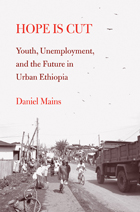 Hope Is Cut: Youth, Unemployment, and the Future in Urban Ethiopia
Daniel Mains
Temple University Press, 2013 How do ambitious young men grapple with an unemployment rate in urban Ethiopia hovering around fifty percent? Urban, educated, and unemployed young men have been the primary force behind the recent unrest and revolutions in North Africa and the Middle East. Daniel Mains' detailed and moving ethnographic study, Hope is Cut, examines young men's struggles to retain hope for the future in the midst of economic uncertainty and cultural globalization. Through a close ethnographic examination of young men's day-to-day lives Hope is Cut explores the construction of optimism through activities like formal schooling, the consumption of international films, and the use of khat, a mild stimulant. Mains also provides a consideration of social theories concerning space, time, and capitalism. Young men here experience unemployment as a problem of time—they often congregate on street corners, joking that the only change in their lives is the sun rising and setting. Mains addresses these factors and the importance of reciprocity and international migration as a means of overcoming the barriers to attaining aspirations.
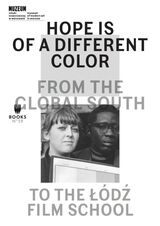 Hope Is of a Different Color: From the Global South to the Lodz Film School
Edited by Magda Lipska and Monika Talarczyk
Museum of Modern Art in Warsaw, 2020 The history of film students from the Global South who studied in Poland during the Cold War.
As Poland’s second-largest city, Łódź was a hub for international students who studied in Poland from the mid-1960s to 1989. The Łódź Film School, a member of CILECT since 1955, was a favored destination, with students from Africa, Latin America, and the Middle East accounting for one-third of its international student body. Despite the school’s international reputation, the experience of its filmmakers from the Global South is little known beyond Poland.
Hope Is of a Different Color addresses the history of student exchanges between the Global South and the Polish People’s Republic during the Cold War. It sheds light on the experiences and careers of a generation of young filmmakers at Łódź, many of whom went on to achieve success as artists in their home countries, and provides insight into emerging areas of research and race relations in Central and Eastern Europe. The essays reflect on these issues from multiple perspectives, considering sociology, political science, art, and film history. The book also features previously unpublished photographs and film stills from private archives along with visual and written material collected at the Łódź Film School.
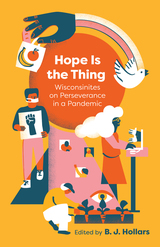 Hope is the Thing: Wisconsinites on Perseverance in a Pandemic
B. J. Hollars
Wisconsin Historical Society Press, 2021 In March 2020, as a pandemic began to ravage our world, writer and professor B. J. Hollars started a collaborative writing project to bridge the emotional challenges created by our physical distancing. Drawing upon Emily Dickinson’s famous poem “‘Hope’ is the thing with feathers,” Hollars called on Wisconsinites to reflect on their own glimpses of hope in the era of COVID-19. The call resulted in an avalanche of submissions, each reflecting on hope’s ability to persist and flourish, even in the darkest times.
As the one hundred essays and poems gathered here demonstrate, hope comes in many forms: a dad dance, a birth plan, an unblemished banana, a visit from a neighborhood dog, the revival of an old tradition, empathy. The contributors are racially, geographically, and culturally diverse, representing a rough cross section of Wisconsin voices, from truck driver to poet laureate, from middle school student to octogenarian, from small business owner to seasoned writer. The result is a book-length exploration of the depth and range of hope experienced in times of crisis, as well as an important record of what Wisconsinites were facing and feeling through these historic times.
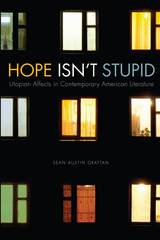 Hope Isn't Stupid: Utopian Affects in Contemporary American Literature
Sean Austin Grattan
University of Iowa Press, 2017 Hope Isn’t Stupid is the first study to interrogate the neglected connections between affect and the practice of utopia in contemporary American literature. Although these concepts are rarely theorized together, it is difficult to fully articulate utopia without understanding how affects circulate within utopian texts. Moving away from science fiction—the genre in which utopian visions are often located—author Sean Grattan resuscitates the importance of utopianism in recent American literary history. Doing so enables him to assert the pivotal role contemporary American literature has to play in allowing us to envision alternatives to global neoliberal capitalism.
Novelists William S. Burroughs, Dennis Cooper, John Darnielle, Toni Morrison, Thomas Pynchon, and Colson Whitehead are deeply invested in the creation of utopian possibilities. A return to reading the utopian wager in literature from the postmodern to the contemporary period reinvigorates critical forms that imagine reading as an act of communication, friendship, solace, and succor. These forms also model richer modes of belonging than the diluted and impoverished ones on display in the neoliberal present. Simultaneously, by linking utopian studies and affect studies, Grattan’s work resists the tendency for affect studies to codify around the negative, instead reorienting the field around the messy, rich, vibrant, and ambivalent affective possibilities of the world. Hope Isn’t Stupid insists on the centrality of utopia not only in American literature, but in American life as well.
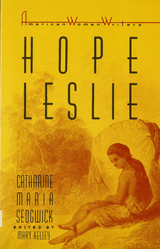 Hope Leslie: Or, Early Times in the Massachusetts
Sedgwick, Catherine M
Rutgers University Press, 1987 Hope Leslie (1827), set in the seventeenth-century New England, is a novel that forced readers to confront the consequences of the Puritans’ subjugation and displacement of the indigenous Indian population at a time when contemporaries were demanding still more land from the Cherokees, the Chickasaws, and the Choctaws.
"This handsome reprint ... makes available after many decades the New Englander's tale of seventeeth-century Puritans, and their relations with the indigenous Indian population." -- Nineteeth-Century Literature
" A splendidly conceived edition of Sedwick's historical romance. Highly recommended." --Choice "Develop(s) the connections between patriarchal authority within the Puritan state and its policy of dispossessing and exterminating Indians. The different heritage it envisions explicitly link white women and Indians and elaborates a communal concept of liberty at odds with the individualistic concept which predominated in American culture." -- Legacy
Hope Lies in the Proles: George Orwell and the Left
John Newsinger
Pluto Press, 2018 Few figures on the left are as widely heralded as George Orwell. Yet his actual politics are poorly understood. Hope Lies in the Proles corrects that, offering a sympathetic yet critical account of Orwell’s often muddied political thinking and its continued relevance today. John Newsinger takes up various aspects of Orwell’s personal politics, exploring his attempts to change working-class consciousness, considering it alternately romantic, realistic, and patronizing—and at times all three at once. He examines Orwell’s antifascism, and how it fits in with his criticism of the Soviet Union; looks into his relationship with the Labour Party and feminism; and delves into Orwell’s shifting views on the United States. The result is the clearest understanding we’ve ever had of Orwell’s politics and their legacy.
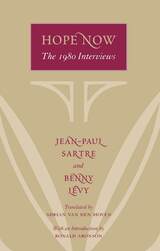 Hope Now: The 1980 Interviews
Jean-Paul Sartre and Benny Lévy
University of Chicago Press, 1996 In March of 1980, just a month before Sartre's death, Le Nouvel Observateur published a series of interviews, the last ever given, between the blind and debilitated philosopher and his young assistant, Benny Levy. Readers were scandalized and denounced the interviews as distorted, inauthentic, even fraudulent. They seemed to portray a Sartre who had abandoned his leftist convictions and rejected his most intimate friends, including Simone de Beauvoir. This man had cast aside his own fundamental beliefs in the primacy of individual consciousness, the inevitability of violence, and Marxism, embracing instead a messianic Judaism. No, Sartre's supporters argued, it was his interlocutor, the ex-radical, the orthodox, ultra-right-wing activist who had twisted the words and thought of an ailing Sartre to his own ends. Or had he?
Shortly before his death, Sartre confirmed the authenticity of the interviews and their puzzling content. Over the past fifteen years, it has become the task of Sartre scholars to unravel and understand them. Presented in this fresh, meticulous translation, the interviews are framed by two provocative essays from Benny Levy himself, accompanied by a comprehensive introduction from noted Sartre authority Ronald Aronson. Placing the interviews in proper biographical and philosophical perspective, Aronson demonstrates that the thought of both Sartre and Levy reveals multiple intentions that taken together nevertheless confirm and add to Sartre's overall philosophy. This absorbing volume at last contextualizes and elucidates the final thoughts of a brilliant and influential mind.
Jean-Paul Sartre (1906-1980) was offered, but declined, the Nobel Prize for literature in 1964. His many works of fiction, drama, and philosophy include the monumental study of Flaubert, The Family Idiot, and The Freud Scenario, both published in translation by the University of Chicago Press.
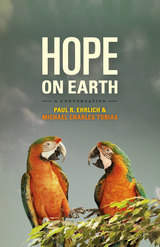 Hope on Earth: A Conversation
Paul R. Ehrlich and Michael Charles Tobias
University of Chicago Press, 2014 Hope on Earth is the thought-provoking result of a lively and wide-ranging conversation between two of the world’s leading interdisciplinary environmental scientists: Paul R. Ehrlich, whose book The Population Bomb shook the world in 1968 (and continues to shake it), and Michael Charles Tobias, whose over 40 books and 150 films have been read and/or viewed throughout the world. Hope on Earth offers a rare opportunity to listen in as these deeply knowledgeable and highly creative thinkers offer their takes on the most pressing environmental concerns of the moment.
Both Ehrlich and Tobias argue that we are on the verge of environmental catastrophe, as the human population continues to grow without restraint and without significant attempts to deal with overconsumption and the vast depletion of resources and climate problems it creates. Though their views are sympathetic, they differ in their approach and in some key moral stances, giving rise to a heated and engaging dialogue that opens up dozens of new avenues of exploration. They both believe that the impact of a human society on its environment is the direct result of its population size, and through their dialogue they break down the complex social problems that are wrapped up in this idea and attempts to overcome it, hitting firmly upon many controversial topics such as circumcision, religion, reproduction, abortion, animal rights, diet, and gun control. For Ehrlich and Tobias, ethics involve not only how we treat other people directly, but how we treat them and other organisms indirectly through our effects on the environment. University of California, Berkeley professor John Harte joins the duo for part of the conversation, and his substantial expertise on energy and climate change adds a crucial perspective to the discussion of the impact of population on global warming.
This engaging and timely book invites readers into an intimate conversation with some of the most eminent voices in science as they offer a powerful and approachable argument that the ethical and scientific issues involved in solving our environmental crisis are deeply intertwined, while offering us an optimistic way forward. Hope on Earth is indeed a conversation we should all be having.
Hope, Trust, and Forgiveness: Essays in Finitude
John T. Lysaker
University of Chicago Press, 2023 A new ethics of human finitude developed through three experimental essays.
As ethical beings, we strive for lives that are meaningful and praiseworthy. But we are finite. We do not know, so we hope. We need, so we trust. We err, so we forgive. In this book, philosopher John T. Lysaker draws our attention to the ways in which these three capacities—hope, trust, and forgiveness—contend with human limits. Each experience is vital to human flourishing, yet each also poses significant personal and institutional challenges as well as opportunities for growth. Hope, Trust, and Forgiveness explores these challenges and opportunities and proposes ways to best meet them. In so doing, Lysaker experiments with the essay as a form and advances an improvisational perfectionism to deepen and expand our ethical horizons.
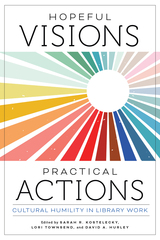 Hopeful Visions, Practical Actions: Cultural Humility in Library Work
Edited by Sarah R. Kostelecky, Lori Townsend, and David A. Hurley
American Library Association, 2023 Cultural humility offers a renewing and transformative framework for navigating interpersonal interactions in libraries, whether between patrons and staff or staff members with one another. It foregrounds a practice of critical self-reflection and commitment to recognizing and redressing structural inequities and problematic power imbalances. This collection, the first book-length treatment of this approach in libraries, gathers contributors from across the field to demonstrate how cultural humility can change the way we work and make lasting impacts on diversity, equity, and inclusion in libraries. This book's chapters explore such topics as - how Indigenous adages can be tools for reflection and guidance in developing cultural humility;
- the experiences of two Black librarians who are using cultural humility to change the profession;
- new perspectives on core concepts of customer service;
- rethinking policies and practices in libraries both large and small;
- using cultural humility in approaching collection development and creating resource guides;
- what cultural humility can look like for a tribal librarian working in a tribal college library; and
- reflecting on cultural humility itself and where it is going.
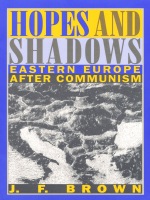 Hopes and Shadows: Eastern Europe After Communism
J. F. Brown
Duke University Press, 1994 After the exuberance that marked the revolutions of 1989, the countries of Eastern Europe have faced the breathtakingly ambitious task of remaking their societies. Simultaneously they have sought to build liberal democracies based on market economics, while confronting reassertions of claims for national independence long suppressed. Taking up where his previous book Surge to Freedom ended, J. F. Brown’s Hopes and Shadows analyzes the results of the first four years of Eastern Europe’s separation from communist rule and the prospects for the future.
The forces at work in the midst of this revolution are examined from a perspective that is necessarily both historical and contemporary as the complex relationship between the tasks that face these countries and the legacy of their communist and pre-communist past shape the difficult present. As the usefulness of the designation "Eastern Europe" is itself questioned, Brown provides both regional and country-by-country analysis of the political situation. The Czech Republic, Slovakia, Hungary, and Poland are grouped together, as are Romania, Bulgaria, and Albania, to address questions such as the development of liberal democratic culture, the activation of democratic institutions and procedures, and the future of former communist bureaucracies. He considers the former Yugoslavia—now torn violently apart—largely as a separate case. The theoretical, political, social, financial, cultural, and psychological dimensions of the transition from socialism to a market economy are discussed in detail. The final aspect of this revolution, the failure of which most immediately threatens the entire process, is the attempt to build new and stable national statehoods. Brown explores the history and impact of the current reemergence of nationalism and the dangers it represents.
A comprehensive and authoritative survey, J. F. Brown’s analysis and presentation of the contemporary Eastern European political landscape will be essential reading for scholars and specialists and of great interest to general readers.
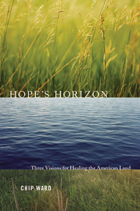 Hope's Horizon: Three Visions For Healing The American Land
Chip Ward
Island Press, 2004 At a time of widespread environmental pessimism, Hope's Horizon goes on an inspirational offensive. In this entertaining and thought-provoking book, author Chip Ward tells of his travels among a new generation of activists who are moving beyond defensive environmental struggles and advocating pioneering, proactive strategies for healing the land. Chip Ward's three-year odyssey took him behind the scenes of efforts to reconnect fragmented habitats and "re-wild" the North American continent; the campaign to drain Lake Powell and restore Glen Canyon to its natural state; and the struggle to keep nuclear waste off Western Shoshone ancestral lands and, ultimately, to abolish all nuclear power and weapons. These movements, and the practical visionaries leading them, challenge readers with a new paradigm in which land is used in a spirit of collaboration with natural systems rather than domination of them. Broad in its sweep, Hope's Horizon uses its topical subjects as springboards for exploring how we can redefine our place in the world while restoring damaged habitats, replenishing lost diversity, and abandoning harmful technologies. Lively, literate, and free of the grimness that characterizes so much environmental writing, Hope's Horizon will change the way readers see the world. It makes complicated concepts and issues accessible, and wild ideas compelling. And while the book's starting point is a hard-nosed indictment of humanity's failed stewardship of the earth, the stories that follow tell of catalytic optimism and ecological wisdom in the face of self-destructive habit and blind pride.
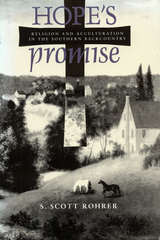 Hope's Promise: Religion and Acculturation in the Southern Backcountry
S. Scott Rohrer
University of Alabama Press, 2013 This eloquent study describes the complex process of assimilation that occurred among multi-ethnic groups in Wachovia, the evangelical community that settled a 100,000-acre tract in Piedmont North Carolina from 1750 to 1860. It counters commonplace notions that evangelicalism was a divisive force in the antebellum South, demonstrating instead the ability of evangelical beliefs and practices to unify diverse peoples and foster shared cultural values.
In Hope's Promise, Scott Rohrer dissects the internal workings of the ecumenical Moravian movement at Wachovia—how this disparate group of pilgrims hailing from many countries (Germany, Ireland, Scandinavia, England) and different denominations (Lutheran, Reformed, Methodist, Anglican) yielded their ethnicities as they became, above all, a people of faith. By examining the "open" farm congregations of Hope, Friedberg, and Friedland, Rohrer offers a sensitive portrayal of their evangelical life and the momentous cultural changes it wrought: the organization of tight-knit congregations bound by "heart religion;" the theology of the new birth; the shape of religious discipline; the sacrament of communion; and the role of music. Drawing on courthouse documents and church records, Rohrer carefully demonstrates how various groups began to take on traits of the others. He also illustrates how evangelical values propelled interaction with the outside world—at the meetinghouse and the frontier store, for example—and fostered even more collective and accelerated change.
As the Moravians became ever more "American" and "southern," the polyglot of ethnicities that was Wachovia would, under the unifying banner of evangelicalism, meld into one of the most sophisticated religious communities in early America.
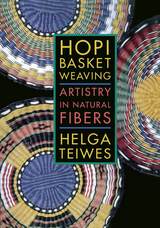 Hopi Basket Weaving: Artistry in Natural Fibers
Helga Teiwes
University of Arizona Press, 1996 "With the inborn wisdom that has guided them for so long through so many obstacles, Hopi men and women perpetuate their proven rituals, strongly encouraging those who attempt to neglect or disrespect their obligations to uphold them. One of these obligations is to respect the flora and fauna of our planet. The Hopi closeness to the Earth is represented in all the arts of all three mesas, whether in clay or natural fibers. What clay is to a potter's hands, natural fibers are to a basket weaver." —from the Introduction
Rising dramatically from the desert floor, Arizona's windswept mesas have been home to the Hopis for hundreds of years. A people known for protecting their privacy, these Native Americans also have a long and less known tradition of weaving baskets and plaques. Generations of Hopi weavers have passed down knowledge of techniques and materials from the plant world around them, from mother to daughter, granddaughter, or niece.
This book is filled with photographs and detailed descriptions of their beautiful baskets—the one art, above all others, that creates the strongest social bonds in Hopi life. In these pages, weavers open their lives to the outside world as a means of sharing an art form especially demanding of time and talent. The reader learns how plant materials are gathered in canyons and creek bottoms, close to home and far away. The long, painstaking process of preparation and dying is followed step by step. Then, using techniques of coiled, plaited, or wicker basketry, the weaving begins.
Underlying the stories of baskets and their weavers is a rare glimpse of what is called "the Hopi Way," a life philosophy that has strengthened and sustained the Hopi people through centuries of change. Many other glimpses of the Hopi world are also shared by author and photographer Helga Teiwes, who was warmly invited into the homes of her collaborators. Their permission and the permission of the Cultural Preservation Office of the Hopi Tribe gave her access to people and information seldom available to outsiders.
Teiwes was also granted access to some of the ceremonial observances where baskets are preeminent. Woven in brilliant reds, greens, and yellows as well as black and white, Hopi weavings, then, not only are an arresting art form but also are highly symbolic of what is most important in Hopi life. In the women's basket dance, for example, woven plaques commemorate and honor the Earth and the perpetuation of life. Other plaques play a role in the complicated web of Hopi social obligation and reciprocity.
Living in a landscape of almost surreal form and color, Hopi weavers are carrying on one of the oldest arts traditions in the world. Their stories in Hopi Basket Weaving will appeal to collectors, artists and craftspeople, and anyone with an interest in Native American studies, especially Native American arts. For the traveler or general reader, the book is an invitation to enter a little-known world and to learn more about an art form steeped in meaning and stunning in its beauty.
Hopi Cookery
Juanita Tiger Kavena
University of Arizona Press, 1980 More than one hundred authentic recipes center around Hopi staples of beans, corn, wheat, chilies, meat, gourds, and native greens and fruits.
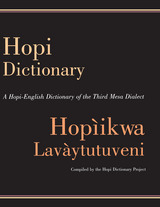 Hopi Dictionary/Hopìikwa Lavàytutuveni: A Hopi-English Dictionary of the Third Mesa Dialect
Hopi Dictionary Project Hopi Dictionary Project
University of Arizona Press, 1998 Hopi culture has long received considerable attention from the outside world, but the Hopi language has remained much less well known. This is the first true dictionary of Hopi, containing approximately 30,000 entries. The dictionary is based on the dialect spoken today in villages on Third Mesa and was compiled in consultation with a large team of elder Hopi speakers. Its preparation has involved a comprehensive survey of the ethnographic and linguistic literature to identify Hopi vocabulary, and each item found has been checked against existing Third Mesa knowledge of Hopi. The dictionary is valuable not only for the number of its entries but also for its many illustrative sentences and its abundance of information on aspects of Hopi culture, such as often-misunderstood expressions concerning time and space. Main entries, presented for the simplest and most common forms of words, contain full information on inflection in addition to definitions and examples. Cross-references are made for inflected forms that are not easily predictable, such as plurals, less common variants, and combining forms. Many definitions are illustrated with line drawings. The volume also features an English-Hopi word-finder list and a sketch of Hopi grammar, which makes it possible for the user to determine the structure of almost any Hopi sentence. An invaluable reference in Uto-Aztecan languages, this dictionary permits informed reading of Hopi texts. It is a definitive source for understanding not only a language but also a way of life.
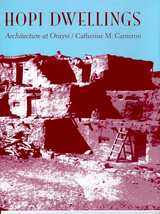 Hopi Dwellings: Architectural Change at Orayvi
Catherine M. Cameron
University of Arizona Press, 1999 The dramatic split of the Hopi community of Orayvi in 1906 had lasting consequences not only for the people of Third Mesa but also for the very buildings around which they centered their lives. This book examines architectural and other effects of that split, using architectural change as a framework with which to understand social and cultural processes at prehistoric Southwestern pueblos. Catherine Cameron examines architectural change at Orayvi from 1871 to 1948, a period of great demographic and social upheaval.
Her study is unique in its use of historic photographs to document and understand abandonment processes and apply that knowledge to prehistoric sites. Photos taken by tourists, missionaries, and early anthropologists during the late nineteenth century portray original structures, while later photos show how Orayvi buildings changed over a period of almost eighty years. Census data relating to house size and household configuration shed additional light on social change in the pueblo.
Examining change at Orayvi afforded an opportunity to study the architectural effects of an event that must have happened many times in the past--the partial abandonment of a pueblo--by tracing the effects of sudden population decline on puebloan architecture. Cameron's work provides clues to how and why villages were abandoned and re-established repeatedly in the prehistoric Southwest as it offers a unique window on the relationship between Pueblo houses and the living people who occupied them.
The Hopi Indians of Old Oraibi: Change and Continuity
Mischa Titiev
University of Michigan Press, 1972 From August of 1933 to March 1933, Mischa Titiev lived among the Hopi Indians of Old Oraibi, an ancient pueblo of the Hopi Indian Reservation in northeastern Arizona. A trained anthropologist, Dr. Titiev was adopted into the tribe and into the Sun clan during his stay - evidence enough of his remarkable acceptance by the people whose life he shared even as he sympathetically observed their ways. Subsequently, Titiev made return trips to Old Oraibi over a period of four decades, observing both the changes in the individual lives of those he had known and the signs of cultural change in the community. This fascinating diary of his extended 1933-34 visit - now published for the first time, and incorporating the observations made during the author's many subsequent stays - thus stands as a unique and irreplaceable record of Hopi life, and a rare longitudinal study of sociocultural change.
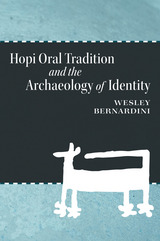 Hopi Oral Tradition and the Archaeology of Identity
Wesley Bernardini
University of Arizona Press, 2005 As contemporary Native Americans assert the legacy of their ancestors, there is increasing debate among archaeologists over the methods and theories used to reconstruct prehistoric identity and the movement of social groups. This is especially problematic with respect to the emergence of southwestern tribes, which involved shifting populations and identities over the course of more than a thousand years. Wesley Bernardini now draws on an unconventional source, Hopi traditional knowledge, to show how hypotheses that are developed from oral tradition can stimulate new and productive ways to think about the archaeological record. Focusing on insights that oral tradition has to offer about general processes of prehistoric migration and identity formation, he describes how each Hopi clan acquired its particular identity from the experiences it accumulated on its unique migration pathway. This pattern of “serial migration” by small social groups often saw the formation of villages by clans that briefly came together and then moved off again independently, producing considerable social diversity both within and among villages. Using Anderson Mesa and Homol’ovi as case studies, Bernardini presents architectural and demographic data suggesting that the fourteenth century occupation of these regions was characterized by population flux and diversity consistent with the serial migration model. He offers an analysis of rock art motifs—focusing on those used as clan symbols—to evaluate the diversity of group identities, then presents a compositional analysis of Jeddito Yellow Ware pottery to evaluate the diversity of these groups’ eventual migration destinations. Evidence supporting serial migration greatly complicates existing notions of links between ancient and modern social groups, with important implications for the implementation of the Native American Graves Protection and Repatriation Act. Bernardini’s work clearly demonstrates that studies of cultural affiliation must take into account the fluid nature of population movements and identity in the prehistoric landscape. It takes a decisive step toward better understanding the major demographic change that occurred on the Colorado Plateau from 1275 to 1400 and presents a strategy for improving the reconstruction of cultural identity in the past.
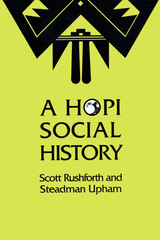 A Hopi Social History
By Scott Rushforth and Steadman Upham
University of Texas Press, 1992 All anthropologists and archaeologists seek to answer basic questions about human beings and society. Why do people behave the way they do? Why do patterns in the behavior of individuals and groups sometimes persist for remarkable periods of time? Why do patterns in behavior sometimes change?
A Hopi Social History explores these basic questions in a unique way. The discussion is constructed around a historically ordered series of case studies from a single sociocultural system (the Hopi) in order to understand better the multiplicity of processes at work in any sociocultural system through time. The case studies investigate the mysterious abandonments of the Western Pueblo region in late prehistory, the initial impact of European diseases on the Hopis, Hopi resistance to European domination between 1680 and 1880, the split of Oraibi village in 1906, and some responses by the Hopis to modernization in the twentieth century.
These case studies provide a forum in which the authors examine a number of theories and conceptions of culture to determine which theories are relevant to which kinds of persistence and change. With this broad theoretical synthesis, the book will be of interest to students and scholars in the social sciences.
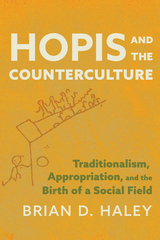 Hopis and the Counterculture: Traditionalism, Appropriation, and the Birth of a Social Field
Brian D. Haley
University of Arizona Press, 2024 This book addresses how the Hopi became icons of the followers of alternative spiritualities and reveals one of the major pathways for the explosive appropriation of Indigenous identities in the 1960s. It reveals a largely unknown network of Native, non-Indian, and neo-Indian actors who spread misrepresentations of the Hopi that they created through interactions with the Hopi Traditionalist faction of the 1940s through 1980s. Significantly, many non-Hopis involved adopted Indian identities during this time, becoming “neo-Indians.”
Exploring the new social field that developed to spread these ideas, Hopis and the Counterculture meticulously traces the trajectories of figures such as Ammon Hennacy, Craig Carpenter, Frank Waters, and the Firesign Theatre, among others. Drawing on insights into the interplay between primitivism, radicalism, stereotyping, and identity, Haley expands on concepts from scholars such as Roy Harvey Pearce’s notion of “isolated radicals” and Jonathan Friedman’s observations regarding the ascendancy of primitivism amid global crises. Haley scrutinizes the roles played by non-Hopi actors and the timing behind the widespread popularization of Hopi religious practices.
HOPOS: The Journal of the International Society for the History of Philosophy of Science, volume 11 number 2 (Fall 2021)
The University of Chicago Press
University of Chicago Press Journals, 2021 This is volume 11 issue 2 of HOPOS: The Journal of the International Society for the History of Philosophy of Science. Presenting international, peer-reviewed scholarship on the history of philosophy of science, HOPOS explores connections across a range of social, economic, and political contexts. The work of philosophers of science is a central focus, as well as the development, interpretation, and impact of the philosophy of science as a discipline. The journal features articles, special issues, book reviews, and review essays of recent scholarship in growing areas of the field. HOPOS is the official journal of the International Society for the History of Philosophy of Science.
HOPOS: The Journal of the International Society for the History of Philosophy of Science, volume 12 number 1 (Spring 2022)
The University of Chicago Press
University of Chicago Press Journals, 2022 This is volume 12 issue 1 of HOPOS: The Journal of the International Society for the History of Philosophy of Science. Presenting international, peer-reviewed scholarship on the history of philosophy of science, HOPOS explores connections across a range of social, economic, and political contexts. The work of philosophers of science is a central focus, as well as the development, interpretation, and impact of the philosophy of science as a discipline. The journal features articles, special issues, book reviews, and review essays of recent scholarship in growing areas of the field. HOPOS is the official journal of the International Society for the History of Philosophy of Science.
HOPOS: The Journal of the International Society for the History of Philosophy of Science, volume 12 number 2 (Fall 2022)
The University of Chicago Press
University of Chicago Press Journals, 2022 This is volume 12 issue 2 of HOPOS: The Journal of the International Society for the History of Philosophy of Science. Presenting international, peer-reviewed scholarship on the history of philosophy of science, HOPOS explores connections across a range of social, economic, and political contexts. The work of philosophers of science is a central focus, as well as the development, interpretation, and impact of the philosophy of science as a discipline. The journal features articles, special issues, book reviews, and review essays of recent scholarship in growing areas of the field. HOPOS is the official journal of the International Society for the History of Philosophy of Science.
HOPOS: The Journal of the International Society for the History of Philosophy of Science, volume 13 number 1 (Spring 2023)
The University of Chicago Press
University of Chicago Press Journals, 2023 This is volume 13 issue 1 of HOPOS: The Journal of the International Society for the History of Philosophy of Science. Presenting international, peer-reviewed scholarship on the history of philosophy of science, HOPOS explores connections across a range of social, economic, and political contexts. The work of philosophers of science is a central focus, as well as the development, interpretation, and impact of the philosophy of science as a discipline. The journal features articles, special issues, book reviews, and review essays of recent scholarship in growing areas of the field. HOPOS is the official journal of the International Society for the History of Philosophy of Science.
HOPOS: The Journal of the International Society for the History of Philosophy of Science, volume 13 number 2 (Fall 2023)
The University of Chicago Press
University of Chicago Press Journals, 2023 This is volume 13 issue 2 of HOPOS: The Journal of the International Society for the History of Philosophy of Science. Presenting international, peer-reviewed scholarship on the history of philosophy of science, HOPOS explores connections across a range of social, economic, and political contexts. The work of philosophers of science is a central focus, as well as the development, interpretation, and impact of the philosophy of science as a discipline. The journal features articles, special issues, book reviews, and review essays of recent scholarship in growing areas of the field. HOPOS is the official journal of the International Society for the History of Philosophy of Science.
HOPOS: The Journal of the International Society for the History of Philosophy of Science, volume 14 number 1 (Spring 2024)
The University of Chicago Press
University of Chicago Press Journals, 2024 This is volume 14 issue 1 of HOPOS: The Journal of the International Society for the History of Philosophy of Science. Presenting international, peer-reviewed scholarship on the history of philosophy of science, HOPOS explores connections across a range of social, economic, and political contexts. The work of philosophers of science is a central focus, as well as the development, interpretation, and impact of the philosophy of science as a discipline. The journal features articles, special issues, book reviews, and review essays of recent scholarship in growing areas of the field. HOPOS is the official journal of the International Society for the History of Philosophy of Science.
HOPOS: The Journal of the International Society for the History of Philosophy of Science, volume 14 number 2 (Fall 2024)
The University of Chicago Press
University of Chicago Press Journals, 2024 This is volume 14 issue 2 of HOPOS: The Journal of the International Society for the History of Philosophy of Science. Presenting international, peer-reviewed scholarship on the history of philosophy of science, HOPOS explores connections across a range of social, economic, and political contexts. The work of philosophers of science is a central focus, as well as the development, interpretation, and impact of the philosophy of science as a discipline. The journal features articles, special issues, book reviews, and review essays of recent scholarship in growing areas of the field. HOPOS is the official journal of the International Society for the History of Philosophy of Science.
HOPOS: The Journal of the International Society for the History of Philosophy of Science, volume 15 number 1 (Spring 2025)
The University of Chicago Press
University of Chicago Press Journals, 2025 This is volume 15 issue 1 of HOPOS: The Journal of the International Society for the History of Philosophy of Science. Presenting international, peer-reviewed scholarship on the history of philosophy of science, HOPOS explores connections across a range of social, economic, and political contexts. The work of philosophers of science is a central focus, as well as the development, interpretation, and impact of the philosophy of science as a discipline. The journal features articles, special issues, book reviews, and review essays of recent scholarship in growing areas of the field. HOPOS is the official journal of the International Society for the History of Philosophy of Science.
HOPOS: The Journal of the International Society for the History of Philosophy of Science, volume 15 number 2 (Fall 2025)
The University of Chicago Press
University of Chicago Press Journals, 2025 This is volume 15 issue 2 of HOPOS: The Journal of the International Society for the History of Philosophy of Science. Presenting international, peer-reviewed scholarship on the history of philosophy of science, HOPOS explores connections across a range of social, economic, and political contexts. The work of philosophers of science is a central focus, as well as the development, interpretation, and impact of the philosophy of science as a discipline. The journal features articles, special issues, book reviews, and review essays of recent scholarship in growing areas of the field. HOPOS is the official journal of the International Society for the History of Philosophy of Science.
HOPOS vol 10 num 1
The University of Chicago Press
University of Chicago Press Journals, 2020
HOPOS vol 10 num 2
The University of Chicago Press
University of Chicago Press Journals, 2020
HOPOS vol 3 num 1
The University of Chicago Press
University of Chicago Press Journals, 2013
HOPOS vol 3 num 2
The University of Chicago Press
University of Chicago Press Journals, 2013
HOPOS vol 4 num 1
The University of Chicago Press
University of Chicago Press Journals, 2014
HOPOS vol 4 num 2
The University of Chicago Press
University of Chicago Press Journals, 2014
HOPOS vol 5 num 1
The University of Chicago Press
University of Chicago Press Journals, 2015
HOPOS vol 5 num 2
The University of Chicago Press
University of Chicago Press Journals, 2015
HOPOS vol 6 num 1
The University of Chicago Press
University of Chicago Press Journals, 2016
HOPOS vol 6 num 2
The University of Chicago Press
University of Chicago Press Journals, 2016
HOPOS vol 7 num 1
The University of Chicago Press
University of Chicago Press Journals, 2017
HOPOS vol 7 num 2
The University of Chicago Press
University of Chicago Press Journals, 2017
HOPOS vol 8 num 1
The University of Chicago Press
University of Chicago Press Journals, 2018
HOPOS vol 8 num 2
The University of Chicago Press
University of Chicago Press Journals, 2018
HOPOS vol 9 num 1
The University of Chicago Press
University of Chicago Press Journals, 2019
HOPOS vol 9 num 2
The University of Chicago Press
University of Chicago Press Journals, 2019
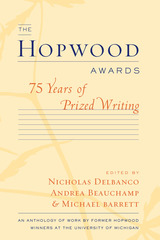 The Hopwood Awards: 75 Years of Prized Writing
Edited by Nicholas Delbanco, Andrea Beauchamp, and Michael Barrett
University of Michigan Press, 2006 "Permit me to say that I have won Hopwoods and also lost them, and I know the power that winning gives and the way the soul shakes when, all ears, you hear silence instead of your name."
-Arthur Miller
The Hopwood Awards claim a gallery of prizewinners who rose to become the Who's Who of writers of the last three generations: Max Apple, John Ciardi, Mary Gaitskill, Robert Hayden, Laura Kasischke, Jane Kenyon, Arthur Miller, Howard Moss, Frank O'Hara, Marge Piercy, Ronald Wallace, and Nancy Willard, among many others.
Since they first began in 1931, funded by a bequest from the will of playwright Avery Hopwood, University of Michigan Class of 1905, the Hopwood Awards have grown in profile and stature to become one of the most sought after and celebrated writing prizes for students.
The Hopwood Awards: 75 Years of Prized Writing collects-for the first time in one volume-poetry and prose by writers who won Hopwood Awards when they were students at the University of Michigan and who went on to achieve fame as writers.
Nicholas Delbanco is Professor of English and Director of the Hopwood Program at the University of Michigan. He is author or editor of numerous books, including Anywhere Out of the World: Essays on Travel, Writing, Death;The Sincerest Form; and The Writing Life: The Hopwood Lectures.
Andrea Beauchamp is Program Associate at the Hopwood Program, and Michael Barrett is Associate Editor at the Hopwood Program, University of Michigan.
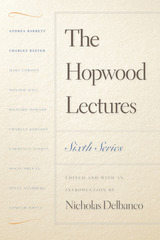 The Hopwood Lectures
Edited and with an introduction by Nicholas Delbanco
University of Michigan Press, 2009 The prestigious Hopwood Creative Writing Awards were established in 1931 from a bequest of the will of Avery Hopwood, a University of Michigan graduate and one of the most popular and successful dramatists of his time. Hopwood left one-fifth of his estate to his alma mater, an endowment that now awards approximately $135,000 each year in prize money. Annual awards are offered to both undergraduate and graduate students in drama, screenplay, nonfiction, novel, short fiction, and poetry. Among the program's most famous recipients are Robert Hayden, Arthur Miller, Frank O'Hara, and Marge Piercy. In addition to the prize ceremony, the Hopwood Awards are celebrated each year with a lecture delivered by a prominent literary figure. Past Hopwood speakers include such luminaries as Saul Bellow, Richard Ford, Louise Glück, Nadine Gordimer, Robert Hass, Norman Mailer, Joyce Carol Oates, and John Crowe Ransom. Their speeches have been collected in five previous volumes published by the University of Michigan Press over the past half-century: The Writer and His Craft: The Hopwood Lectures 1932-1952, edited by Roy W. Cowden; To The Young Writer: Hopwood Lectures, Second Series, edited by A. L. Bader; The Writer's Craft, edited by Robert A. Martin; Speaking of Writing: Selected Hopwood Lectures, edited by Nicholas Delbanco; and The Writing Life: The Hopwood Lectures, Fifth Series, edited by Nicholas Delbanco. The present collection contains the ten lectures delivered since the last publication and includes work by Andrea Barrett, Charles Baxter, Mary Gordon, Donald Hall, Richard Howard, Lawrence Kasdan, Susan Orlean, Susan Stamberg, and Edmund White. The tenth lecture was delivered in spring 2008 by Charles Johnson. Nicholas Delbanco is Robert Frost Collegiate Professor of English Language and Literature and Chair of the Hopwood Committee. Delbanco is the author of twenty books of fiction and nonfiction, including, most recently, Spring and Fall: A Novel. As editor he has compiled the work of, among others, John Gardner and Bernard Malamud. In addition to directing the MFA Program and the Hopwood Awards Program at the University of Michigan, he has served as Chair of the Fiction Panel for the National Book Awards and has received a Guggenheim Fellowship and, twice, a National Endowment for the Arts Writing Fellowship. He lives in Ann Arbor, Michigan.
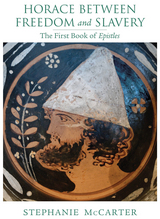 Horace between Freedom and Slavery: The First Book of Epistles
Stephanie McCarter
University of Wisconsin Press, 2015 During the Roman transition from Republic to Empire in the first century B.C.E., the poet Horace found his own public success in the era of Emperor Augustus at odds with his desire for greater independence. In Horace between Freedom and Slavery, Stephanie McCarter offers new insights into Horace's complex presentation of freedom in the first book of his Epistles and connects it to his most enduring and celebrated moral exhortation, the golden mean.
She argues that, although Horace commences the Epistles with an uncompromising insistence on freedom, he ultimately adopts a middle course. She shows how Horace explores in the poems the application of moderate freedom first to philosophy, then to friendship, poetry, and place. Rather than rejecting philosophical masters, Horace draws freely on them without swearing permanent allegiance to any—a model for compromise that allows him to enjoy poetic
renown and friendships with the city's elite while maintaining a private sphere of freedom. This moderation and adaptability, McCarter contends, become the chief ethical lessons that Horace learns for himself and teaches to others. She reads Horace's reconfiguration of freedom as a political response to the transformations of the new imperial age.
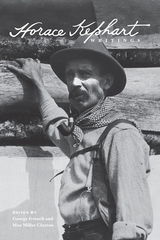 Horace Kephart: Writings
Mae Miller Claxton
University of Tennessee Press, 2020 Best known for Our Southern Highlanders (1913) and Camping and Woodcraft (1916), Horace Kephart’s keen interest in exploring and documenting the great outdoors would lead him not only to settle in Bryson City, North Carolina, but also to become the most significant writer about the Great Smoky Mountains in the early twentieth century.
Edited by Mae Miller Claxton and George Frizzell, Horace Kephart: Writings extends past Kephart’s two well-read works of the early 1900s and dives into his correspondence with friends across the globe, articles and columns in national magazines, unpublished manuscripts, journal entries, and fiction in order to shed some deserved light on Kephart’s classic image as a storyteller and practical guide to the Smokies. The book is divided into thematic subsections that call attention to the variety in Kephart’s writings, its nine chapters featuring Kephart’s works on camping and woodcraft, guns, southern Appalachian culture, fiction, the Cherokee, scouting, and the park and Appalachian trail. Each chapter is accompanied by an introductory essay by a notable Appalachian scholar providing context and background to the included works.
Written for scholars interested in Appalachian culture and history, followers of the modern outdoor movement, students enamored of the Great Smoky Mountains, and general readers alike, Horace Kephart: Writings gathers a plethora of little-known and rarely seen material that illustrates the diversity and richness found in Kephart’s work.
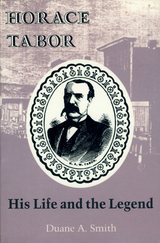 Horace Tabor: His Life and the Legend
Duane A. Smith
University Press of Colorado, 1989 Horace Tabor: His Life and the Legend is the first biography to give full attention to Tabor's mining, business, and political activities as well as to his matrimonial escapades. It is a careful and detailed portrait of a man so extraordinary that even in his own lifetime the facts were largely obscured behind the legend. Rarely has the Victorian American West, both good and bad, been better synopsized in the figure of one man.Show More an.Show Less An 1858er who had spent nearly two decades following the will-o-the-wisp Colorado mining frontier, in 1876 Tabor was then living and working in out-of-the-way Oro City, near where Leadville would be one day. Soon thereafter came the Little Pittsburg silver strike, and Tabor's fortune took flight. Very quickly, Colorado - and the rest of the nation - was hearing about Horace Tabor. "Denver's lucky star was on high when Governor Tabor decided to spend his fortune here," praised the Denver Tribune in 1881. The Leadville Daily Herald (July 8, 1882) also understood his contribution: "Colorado has produced fortunes for many men, but no man who has met with success has so freely made investments in this state, as has Governor Tabor." The events that followed that amazing silver discovery on Fryer Hill, May 1878 unfolded like a classic Greek tragedy. Tabor weathered them all, and his name has resounded through the succeeding decades. No other Coloradan of his generation is so well remembered, nor does anyone else so typify the tempo of this legendary mining era.
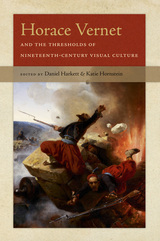 Horace Vernet and the Thresholds of Nineteenth-Century Visual Culture
Edited by Daniel Harkett and Katie Hornstein
Dartmouth College Press, 2017 This collection reconsiders the life and work of Emile Jean-Horace Vernet (1789–1863), presenting him as a crucial figure for understanding the visual culture of modernity. The book includes work by senior and emerging scholars, showing that Vernet was a multifaceted artist who moved with ease across the thresholds of genre and media to cultivate an image of himself as the embodiment of modern France. In tune with his times, skilled at using modern technologies of visual reproduction to advance his reputation, Vernet appealed to patrons from across the political spectrum and made works that nineteenth-century audiences adored. Even Baudelaire, who reviled Vernet and his art and whose judgment has played a significant role in consigning Vernet to art-historical obscurity, acknowledged that the artist was the most complete representative of his age. For those with an interest in the intersection of art and modern media, politics, imperialism, and fashion, the essays in this volume offer a rich reward.
Horatio Nelson Lay and Sino-British Relations, 1854-1864
Jack J. Gerson
Harvard University Press, 1972 Horatio Nelson Lay, the aggressive creator of the Chinese Maritime Customs Service, was employed by the Chinese government to assess the customs duties from China’s foreign trade. Jack Gerson elucidates Lay’s difficult position, delves into the so-called Lay-Osborn Flotilla project, and details the failure of this attempt to provide China with a fleet of gunboats.
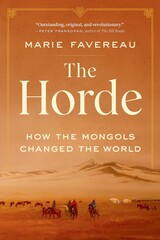 The Horde: How the Mongols Changed the World
Marie Favereau
Harvard University Press, 2021 Cundill Prize Finalist
A Financial Times Book of the Year
A Spectator Book of the Year
A Five Books Book of the Year
The Mongols are known for one thing: conquest. But in this first comprehensive history of the Horde, the western portion of the Mongol empire that arose after the death of Chinggis Khan, Marie Favereau takes us inside one of the most powerful engines of economic integration in world history to show that their accomplishments extended far beyond the battlefield. Central to the extraordinary commercial boom that brought distant civilizations in contact for the first time, the Horde had a unique political regime—a complex power-sharing arrangement between the khan and nobility—that rewarded skillful administrators and fostered a mobile, innovative economic order. From their capital on the lower Volga River, the Mongols influenced state structures in Russia and across the Islamic world, disseminated sophisticated theories about the natural world, and introduced new ideas of religious tolerance.
An eloquent, ambitious, and definitive portrait of an empire that has long been too little understood, The Horde challenges our assumptions that nomads are peripheral to history and makes it clear that we live in a world shaped by Mongols.
“The Mongols have been ill-served by history, the victims of an unfortunate mixture of prejudice and perplexity…The Horde flourished, in Favereau’s fresh, persuasive telling, precisely because it was not the one-trick homicidal rabble of legend.”
—Wall Street Journal
“Fascinating…The Mongols were a sophisticated people with an impressive talent for government and a sensitive relationship with the natural world…An impressively researched and intelligently reasoned book.”
—The Times
Horizon Note
Robin Behn
University of Wisconsin Press, 2001 A son is born too early, as if coming up over the horizon before his own dawn. An elderly father lingers at life’s other horizon. In language dense and clear, playful and somber, and with a formal exactitude and emotional amplitude suggestive of her own musical training, Behn traverses these horizons “extracting,” like the horizon note that drones through traditional Indian music, “a red needle from the sky.”
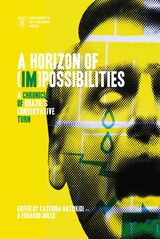 A Horizon of (Im)possibilities: A Chronicle of Brazil’s Conservative Turn
Edited by Katerina Hatzikidi and Eduardo Dullo
University of London Press, 2021 The first volume in English to analyze the impact of recent political phenomena in Brazil, from the rise of Bolsonaro to the climate crisis.
Since the shocking 2018 presidential election in Brazil, a growing body of scholarship has attempted to understand the country’s so-called “conservative turn.” A gripping in-depth account of politics and society in Brazil today, this new volume brings together a myriad of different perspectives to help us better understand the political events that have shaken the country in recent years.
Combining ethnographic insights with political science, history, sociology, and anthropology, the interdisciplinary analyses included in A Horizon of (Im)possibilities offer a panoramic view on social and political change in Brazil, spanning temporal and spatial dimensions. Starting with the 2018 presidential election, the contributors discuss the country’s recent—and more distant—past in relation to the present. Pointing to the continuities and disruptions during those years, this volume is an invaluable guide to understanding the limits of political democracy.
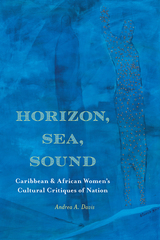 Horizon, Sea, Sound: Caribbean and African Women's Cultural Critiques of Nation
Andrea A. Davis
Northwestern University Press, 2022 Winner of the 2023 Canadian Association of Latin American and Caribbean Studies’ Best Book Prize
In Horizon, Sea, Sound: Caribbean and African Women’s Cultural Critiques of Nation, Andrea Davis imagines new reciprocal relationships beyond the competitive forms of belonging suggested by the nation-state. The book employs the tropes of horizon, sea, and sound as a critique of nation-state discourses and formations, including multicultural citizenship, racial capitalism, settler colonialism, and the hierarchical nuclear family.
Drawing on Tina Campt’s discussion of Black feminist futurity, Davis offers the concept future now, which is both central to Black freedom and a joint social justice project that rejects existing structures of white supremacy. Calling for new affiliations of community among Black, Indigenous, and other racialized women, and offering new reflections on the relationship between the Caribbean and Canada, she articulates a diaspora poetics that privileges our shared humanity. In advancing these claims, Davis turns to the expressive cultures (novels, poetry, theater, and music) of Caribbean and African women artists in Canada, including work by Dionne Brand, M. NourbeSe Philip, Esi Edugyan, Ramabai Espinet, Nalo Hopkinson, Amai Kuda, and Djanet Sears. Davis considers the ways in which the diasporic characters these artists create redraw the boundaries of their horizons, invoke the fluid histories of the Caribbean Sea to overcome the brutalization of plantation histories, use sound to enter and reenter archives, and shapeshift to survive in the face of conquest. The book will interest readers of literary and cultural studies, critical race theories, and Black diasporic studies.
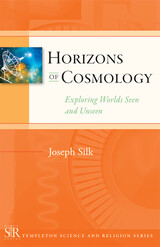 Horizons of Cosmology
Joseph Silk
Templeton Press, 2009 Horizons of Cosmology: Exploring Worlds Seen and Unseen is the fourth title published in the Templeton Science and Religion Series, in which scientists from a wide range of fields distill their experience and knowledge into brief tours of their respective specialties. In this volume, highly esteemed astrophysicist Joseph Silk explores the vast mysteries and speculations of the field of cosmology in a way that balances an accessible style for the general reader and enough technical detail for advanced students and professionals. Indeed, while the physical laws and origins of the universe can be endlessly complex, even Einstein once mused that they could be explained simply enough to be grasped by nonspecialists. To that end Silk begins by introducing the basic story of the major discoveries in cosmology over the past century—wherein we learned that we live in an expanding universe populated with galaxies and stars. The middle chapters examine a number of contemporary puzzles such as dark matter and dark energy. The last third of the book looks at the human side of cosmology and moves to the more philosophical frontiers of the field, such as concepts of multiverses and time travel—areas of exploration where some crossover into speculative territory becomes unavoidable. In the past century alone, our understanding of the universe has expanded exponentially, and it will be fascinating to see what discoveries the next hundred years hold. Few books will provide such a thorough understanding of where we have been and what might lie ahead as Horizons of Cosmology.
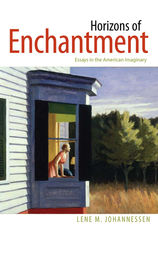 Horizons of Enchantment: Essays in the American Imaginary
Lene M. Johannessen
Dartmouth College Press, 2011 Horizons of Enchantment is about the peculiar power and exceptional pull of the imaginary in American culture. Johannessen’s subject here is the almost mystical American belief in the promise and potential of the individual, or the reliance on a kind of “modern magic” that can loosely be characterized as a fundamental and unwavering faith in the secular sanctity of the American project of modernity. Among the diverse topics and cultural artifacts she examines are the Norwegian American novel A Saloonkeeper’s Daughter by Drude Krog Janson, Walt Whitman’s Song of Myself, Rodolfo Gonzales’s I Am Joaquín, Richard Ford’s The Sportwriter, Ana Menéndez’s In Cuba I Was a German Shepherd, essays by Samuel Huntington and Richard Rodriquez, and the 2009 film Sugar, about a Dominican baseball player trying to make it in the big leagues. In both her subject matter and perspective, Johannessen reconfigures and enriches questions of the transnational and exceptional in American studies.
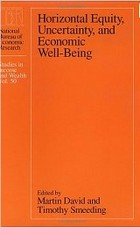 Horizontal Equity, Uncertainty, and Economic Well-being
Edited by Martin David and Timothy Smeeding
University of Chicago Press, 1985 The result of a National Bureau of Economic Research Income and Wealth conference held in December 1983, this volume looks at the concept of "economic well-being" and the ways that analysts have tried to measure it. In addition to income, economists have begun to consider such factors as pensions, wealth, health, and environment when measuring the well-being of a particular group. They have also begun to measure how consumers respond, successfully or unsuccessfully, to such economic uncertainties as inflation, divorce, and retirement. Using new data and techniques, the contributors to this book concentrate on issues of uncertainty and horizontal equity (the equal treatment of individuals within a defined group). Their work points to better ways of determining how various groups in a society are faring relative to other groups. Economists and policy analysts, therefore, will be in a better position to determine how government programs should be applied when well-being is used as a test.
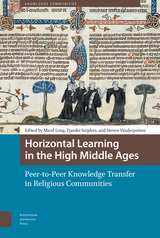 Horizontal Learning in the High Middle Ages: Peer-to-Peer Knowledge Transfer in Religious Communities
Micol Long
Amsterdam University Press, 2019 The history of medieval learning has traditionally been studied as a vertical transmission of knowledge from a master to one or several disciples. Horizontal Learning in the High Middle Ages: Peer-to-Peer Knowledge Transfer in Religious Communities centres on the ways in which cohabiting peers learned and taught one another in a dialectical process - how they acquired knowledge and skills, but also how they developed concepts, beliefs, and adapted their behaviour to suit the group: everything that could mold a person into an efficient member of the community. This process of 'horizontal learning' emerges as an important aspect of the medieval learning experience. Progressing beyond the view that high medieval religious communities were closed, homogeneous, and fairly stable social groups, the essays in this volume understand communities as the product of a continuous process of education and integration of new members. The authors explore how group members learned from one another, and what this teaches us about learning within the context of a high medieval community.
Hormones, Brain, and Behavior
Edited by Carl Gans and David Crews
University of Chicago Press, 1992 This is the first volume to integrate information on ways in which the nervous and endocrine systems interact to mediate crucial aspects of reptile behavior. Although the authors pay particular attention to reproductive behavior, from initial recognition and evaluation of potential partners to decisions about reproduction, they also deal with other survival behaviors.
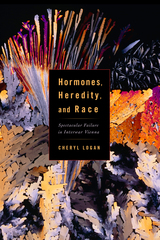 Hormones, Heredity, and Race: Spectacular Failure in Interwar Vienna
Cheryl A. Logan
Rutgers University Press, 2013 Early in the twentieth century, arguments about “nature” and “nurture” pitted a rigid genetic determinism against the idea that genes were flexible and open to environmental change. This book tells the story of three Viennese biologists—Paul Kammerer, Julius Tandler, and Eugen Steinach—who sought to show how the environment could shape heredity through the impact of hormones. It also explores the dynamic of failure through both scientific and social lenses. During World War I, the three men were well respected scientists; by 1934, one was dead by his own hand, another was in exile, and the third was subject to ridicule.
Paul Kammerer had spent years gathering zoological evidence on whether environmental change could alter heredity, using his research as the scientific foundation for a new kind of eugenics—one that challenged the racism growing in mainstream eugenics. By 1918, he drew on the pioneering research of two colleagues who studied how secretions shaped sexual attributes to argue that hormones could alter genes. After 1920, Julius Tandler employed a similar concept to restore the health and well-being of Vienna's war-weary citizens. Both men rejected the rigidly acting genes of the new genetics and instead crafted a biology of flexible heredity to justify eugenic reforms that respected human rights. But the interplay of science and personality with the social and political rise of fascism and with antisemitism undermined their ideas, leading to their spectacular failure.
The Horn of Africa: Intra-State and Inter-State Conflicts and Security
Edited by Redie Bereketeab and Cyril Obi
Pluto Press, 2013 The Horn of Africa, comprising Djibouti, Eritrea, Ethiopia, Sudan and Somalia, is the most conflict-ridden region in Africa. This book explores the origins and impact of these conflicts at both an intra-state and inter-state level and the insecurity they create.
The contributors show how regional and international interventions have compounded pre-existing tensions and have been driven by competing national interests linked to the 'War on Terror' and acts of piracy off the coast of Somalia.
The Horn of Africa outlines proposals for multidimensional mechanisms for conflict resolution in the region. Issues of border demarcation, democratic deficit, crises of nation and state building, and the roles of political actors and traditional authorities are all clearly analysed.
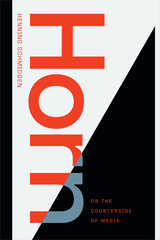 Horn, or The Counterside of Media
Henning Schmidgen
Duke University Press, 2022 We regularly touch and handle media devices. At the same time, media devices such as body scanners, car seat pressure sensors, and smart phones scan and touch us. In Horn, Henning Schmidgen reflects on the bidirectional nature of touch and the ways in which surfaces constitute sites of mediation between interior and exterior. Schmidgen uses the concept of "horn"—whether manifested as a rhinoceros horn or a musical instrument—to stand for both natural substances and artificial objects as spaces of tactility. He enters into creative dialogue with artists, scientists, and philosophers, ranging from Salvador Dalí, William Kentridge, and Rebecca Horn to Sigmund Freud, Walter Benjamin, and Marshall McLuhan, who plumb the complex interplay between tactility and technological and biological surfaces. Whether analyzing how Dalí conceived of images as tactile entities during his “rhinoceros phase” or examining the problem of tactility in Thomas Pynchon’s The Crying of Lot 49, Schmidgen reconfigures understandings of the dynamic phenomena of touch in media.
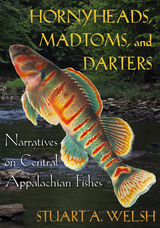 Hornyheads, Madtoms, and Darters: Narratives on Central Appalachian Fishes
Stuart A. Welsh
Ohio University Press, 2023 A collection of essays on nature, naturalists, and the natural history of fishes in central Appalachia. A nature lover’s paradise, central Appalachia supports a diversity of life in an extensive network of waterways and is home to a dazzling array of fish species. This book focuses not only on the fishes of central Appalachia but also on the fascinating things these fishes do in their natural habitats. An ecological dance unfolds from a species and population perspective, although the influence of the community and the ecosystem also figures in the text. Stuart A. Welsh’s essays link central Appalachian fishes with the complexities of competition and predation, species conservation, parasitic infections, climate change, public attitudes, reproductive and foraging ecology, unique morphology, habitat use, and nonnative species. The book addresses a selection of the families of central Appalachian fishes, including lampreys, gars, freshwater eels, pikes, minnows, suckers, catfishes, trouts, trout-perches, sculpins, sunfishes, and perches. These essays often refer to the works of naturalists who contributed to our knowledge of nature during previous centuries and who recorded their discoveries when science writing was less concise than it is today. Although many of these works are nearly forgotten, these early naturalists built a strong knowledge base that supports much of our current science and thus merits reexamination. Most people are not scientists, but many have an interest in nature and are, in their own way, naturalists. This book is for those people willing to peer beneath the water’s surface.
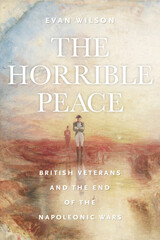 The Horrible Peace: British Veterans and the End of the Napoleonic Wars
Evan Wilson
University of Massachusetts Press, 2023 Few battles in world history provide a cleaner dividing line than Waterloo: before, there was Napoleon; after, there was the Pax Britannica. While Waterloo marked France’s defeat and Britain’s ascendance as an imperial power, the war was far from over for many soldiers and sailors, who were forced to contend with the lasting effects of battlefield trauma, the realities of an impossibly tight labor market, and growing social unrest. The Horrible Peace details a story of distress and discontent, of victory complicated by volcanism, and of the challenges facing Britain at the beginning of its victorious century. Examining the process of demobilization and its consequences for British society, Evan Wilson draws on archival research and veterans’ memoirs to tell the story of this period through the experiences of veterans who struggled to reintegrate and soldiers and sailors who remained in service as Britain attempted to defend and expand the empire. Veterans were indeed central to Britain’s experience of peace, as they took to the streets to protest the government’s indifference to widespread unemployment and misery. The fighting did not stop at Waterloo.
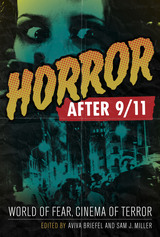 Horror after 9/11: World of Fear, Cinema of Terror
Edited by Aviva Briefel and Sam J. Miller
University of Texas Press, 2011 Horror films have exploded in popularity since the tragic events of September 11, 2001, many of them breaking box-office records and generating broad public discourse. These films have attracted A-list talent and earned award nods, while at the same time becoming darker, more disturbing, and increasingly apocalyptic. Why has horror suddenly become more popular, and what does this say about us? What do specific horror films and trends convey about American society in the wake of events so horrific that many pundits initially predicted the death of the genre? How could American audiences, after tasting real horror, want to consume images of violence on screen? Horror after 9/11 represents the first major exploration of the horror genre through the lens of 9/11 and the subsequent transformation of American and global society. Films discussed include the Twilight saga; the Saw series; Hostel; Cloverfield; 28 Days Later; remakes of The Texas Chainsaw Massacre, Dawn of the Dead, and The Hills Have Eyes; and many more. The contributors analyze recent trends in the horror genre, including the rise of 'torture porn,' the big-budget remakes of classic horror films, the reinvention of traditional monsters such as vampires and zombies, and a new awareness of visual technologies as sites of horror in themselves. The essays examine the allegorical role that the horror film has held in the last ten years, and the ways that it has been translating and reinterpreting the discourses and images of terror into its own cinematic language.
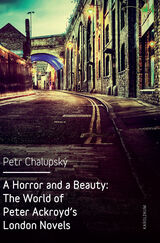 A Horror and a Beauty: The World of Peter Ackroyd's London Novels
Petr Chalupský
Karolinum Press, 2016 Peter Ackroyd’s writing is obsessed with the defining heterogeneity of London—its rich diversity of human experience, mood, and emotion, of actions and events, and of the tools through which all of this heterogeneity is represented and reenacted. But for Ackroyd, one of the foremost of the so-called “London writers,” this energizing heterogeneity also has a sinister side, largely originating outside social norms and mainstream pathways of cultural production. Touching on everything from occult practices to the plotting of radical groups, crime and fraud, dubious scientific experiments, and popular, dramatic forms of ritual and entertainment, Ackroyd contends that these forces both contest prescribed cultural modes and supply the city with its characteristic dynamism and capacity for spiritual renewal.
This idiosyncratic London construct is particularly prominent in Ackroyd’s novels, in which his ideas about the city’s nature and his connection to English literary sensibilities combine to create a distinct chronotope with its own spatial and temporal properties. A Horror and a Beauty explores this world through six defining aspects of the city as Ackroyd identifies them: the relationship between London’s past and present, its uncanny manifestations, its felonious tendencies, its inhabitants’ psychogeographic and antiquarian strategies, its theatricality, and its inherently literary character.
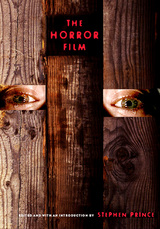 The Horror Film
Prince, Stephen
Rutgers University Press, 2004 In this volume, Stephen Prince has collected essays reviewing the history of the horror film and the psychological reasons for its persistent appeal, as well as discussions of the developmental responses of young adult viewers and children to the genre. The book focuses on recent postmodern examples such as The Blair Witch Project. In a daring move, the volume also examines Holocaust films in relation to horror.
Part One features essays on the silent and classical Hollywood eras. Part Two covers the postWorld War II era and discusses the historical, aesthetic, and psychological characteristics of contemporary horror films. In contrast to horror during the classical Hollywood period, contemporary horror features more graphic and prolonged visualizations of disturbing and horrific imagery, as well as other distinguishing characteristics. Princes introduction provides an overview of the genre, contextualizing the readings that follow.
Stephen Prince is professor of communications at Virginia Tech. He has written many film books, including Classical Film Violence: Designing and Regulating Brutality in Hollywood Cinema, 19301968, and has edited Screening Violence, also in the Depth of Field Series.
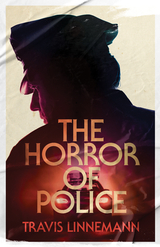 The Horror of Police
Travis Linnemann
University of Minnesota Press, 2022 Unmasks the horrors of a social order reproduced and maintained by the violence of police
Year after year the crisis churns: graft and corruption, violence and murder, riot cops and armored vehicles claim city streets. Despite promises of reform, police operate with impunity, unaccountable to law. In The Horror of Police, Travis Linnemann asks why, with this open record of violence and corruption, policing remains for so many the best, perhaps only means of security in an insecure world. Drawing on the language and texts of horror fiction, Linnemann recasts the police not only as self-proclaimed “monster fighters” but as monsters themselves, a terrifying force set loose in the world. Purposefully misreading a collection of everyday police stories (TV cop dramas, detective fiction, news media accounts, the direct words of police) not as morality tales of innocence avenged and order restored but as horror, Linnemann reveals the monstrous violence at the heart of liberal social order. The Horror of Police shows that police violence is not a deviation but rather a deliberate and permanent fixture of U.S. “law and order.” Only when viewed through the refracted motif of horror stories, Linnemann argues, can we begin to reckon the limits of police and imagine a world without them.
Horror to the Extreme: Changing Boundaries in Asian Cinema
Edited by Jinhee Choi and Mitsuyo Wada-Marciano
Hong Kong University Press, 2009 This book compares production and consumption of Asian horror cinemas in different national contexts and their multidirectional dialogues with Hollywood and neighboring Asian cultures. Individual essays highlight common themes including technology, digital media, adolescent audience sensibilities, transnational productions, pan-Asian marketing techniques, and variations on good vs. evil evident in many Asian horror films. Contributors include Kevin Heffernan, Adam Knee, Chi-Yun Shin, Chika Kinoshita, Robert Cagle, Emilie Yeh Yueh-yu, Neda Ng Hei-tung, Hyun-suk Seo, Kyung Hyun Kim, and Robert Hyland.
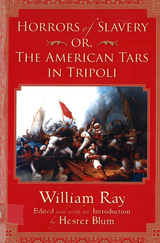 Horrors of Slavery: Or, The American Tars in Tripoli
Blum, Hester
Rutgers University Press, 2008 Barbary pirates in Africa targeted sailors for centuries, often taking slaves and demanding ransom in exchange. First published in 1808, Horrors of Slavery is the tale of one such sailor, captured during the United States's first military encounter with the Islamic world, the Tripolitan War. William Ray, along with three hundred crewmates, spent nineteen months in captivity after his ship, the Philadelphia, ran aground in the harbor of Tripoli. Imprisoned, Ray witnessed-and chronicled-many of the key moments of the military engagement. In addition to offering a compelling history of a little-known war, this book presents the valuable perspective of an ordinary seaman who was as concerned with the injustices of the U.S. Navy as he was with Barbary pirates. Hester Blum's introduction situates Horrors of Slavery in its literary, historical, and political contexts, bringing to light a crucial episode in the early history of our country's relations with Islamic states. A volume in the Subterranean Lives series, edited by Bradford Verter
Horse and Rider: Poems
Melissa Range, with introduction by Robert A. Fink
Texas Tech University Press, 2010 Horse and Rider takes its title from a passage in the book of Exodus: “Sing unto the Lord, for he has triumphed gloriously; horse and rider he has cast into the sea.” Melissa Range’s poems explore violence and power, particularly as those concepts relate to religion and to the natural world. Her mixture of free and formal verse is populated with warriors, weapons, animals, and figures from the Bible and mythology. In a galloping triptych of ancient and apocalyptic visions, these vigorous poems probe the recurring image of the horse and its sometimes troubled, sometimes loving relationship with its rider.
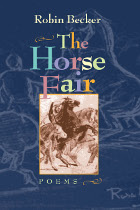 The Horse Fair
Robin Becker
University of Pittsburgh Press, 2000 In The Horse Fair, Robin Becker asks questions about citizenship and participation in the marketplaces—of bodies, of ideas, of objects—in which we function. She investigates how individuals marginalized by gender, religion, and sexual preference negotiate public and private spheres while inventing sustainable communities. Beginning with the great nineteenth-century French painter Rosa Bonheur, Becker has produced a number of multi-voiced, synthetic portraits, each within a framework of social history and a poetics of partiality—she speaks from the persona of Charlotte Salomon, child of assimilate, German-Jewish parents and grandparents and killed by the Nazis at the age of twenty-six; she appropriates passages from the Rosh Hashanah and Yom Kippur services; and juxtaposes them against stanzas that mourn her sister’s death and those that celebrate non-traditional families. Organized around the long meditations, other poems show Becker's dexterity with formal verse (sestina, sonnet, tercets) and her imaginative engagements with free verse.
The Horse Fair takes its name from Bonheur's monumental painting and serves as the vehicle through which Becker explores anti-Semitism, cross-dressing, and Bonheur's lifelong relationships with women. In Becker's hands, The Horse Fair transports us to the communal plaza where we come to barter and to buy, to study one another, to touch the foundation upon which we build our temporary habitations.
Horse in the Dark: Poems
Vievee Francis
Northwestern University Press, 2012 In the next chapter of the Cave Canem/Northwestern University Poetry Prize, we enter the poetic world of Vievee Francis. Bold and skilled, Francis takes us into the still landscapes of Texas and the fluid details of the African American South. Her poems become panhandle folktales revealing the weight of memories so clear and on the cusp. Her creative tangle of metaphors, people and geography will keep the reader rooted in a good earth of extraordinary verse.
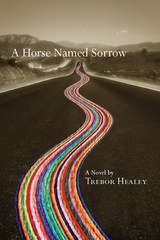 A Horse Named Sorrow
Trebor Healey
University of Wisconsin Press, 2012 Selection, Over the Rainbow Project, GLBT Round Table of the American Library Association Finalist, General Fiction, Lambda Literary Awards Winner, Ferro-Grumley Award for LGBT Fiction, Publishing Triangle Winner, Duggins outstanding Mid-Career novelist Award, Lambda Literary Foundation Award-winning novelist Trebor Healey depicts San Francisco in the 1980s and ’90s in poetic prose that is both ribald and poignant, and a crossing into the American West that is dreamy, mythic, and visionary. When troubled twenty-one-year-old Seamus Blake meets the strong and self-possessed Jimmy (just arrived in San Francisco by bicycle from his hometown in Buffalo, New York), he feels his life may finally be taking a turn for the better. But the ensuing romance proves short-lived as Jimmy dies of an AIDS-related illness. The grieving Seamus is obliged to keep a promise to Jimmy: “Take me back the way I came.” And so Seamus sets out by bicycle on a picaresque journey with the ashes, hoping to bring them back to Buffalo. He meets truck drivers, waitresses, college kids, farmers, ranchers, Marines, and other travelers—each one giving him a new perspective on his own life and on Jimmy’s death. When he meets and becomes involved with a young Native American man whose mother has recently died, Seamus’s grief and his story become universal and redemptive.
 Horse Power: A History of the Horse and Donkey in Human Societies
Juliet Clutton-Brock
Harvard University Press, 1992 If not for a horse, would Alexander have been the Great? William, the Conqueror? Richard, the Lionhearted? If not for their awesome mounts, would the Spaniards have had their way with the New World? Would Paul Revere have spread the word? Would the West have been won?
It is hard to comprehend how far horse power has carried us, difficult to imagine, in our era of mechanical wizardry and speed, what role the horse has played in shaping human history. This is the challenge Juliet Clutton-Brock takes up in her book, a splendid blend of natural and social history that recounts the horse's story as it has figured in—and transfigured—our own.
By drawing on biological, archaeological, and historical evidence, Clutton-Brock describes the wild horse and the wild ass, from their widespread distribution at the end of the last Ice Age to their near extinction today. She shows how these beasts, once hunted for meat, were drafted for work and domesticated as humans began to grasp the possibilities of riding horseback. This discovery, with the speed, distance, and power it offered, transformed the course of history. This elegant tale of the horse and donkey, wonderfully written and handsomely illustrated, revives the true meaning of "horse power."
|
|

